"The difference between us and the others could be seen at the first Grand Prix. There were those who made the rebroadcast suffice to themselves and those like us who could not wait. Waking up that it was still night, dark room and only the TV on, with breakfast in hand. Low volume as everyone is asleep. Small screen, ridiculous definition, antenna to fix. Garbage collectors still in the street lifting bins, while in Australia Michael and Eddie, in red and white overalls, sit in Ferraris. Everything is very simple albeit complicated. The faces of the drivers are those of the guys we would have liked to become, bold and humble in the same way as only Racing teaches you to be. Damon, Jacques and then Mika are scary, there is no way, but we wanted to be them too below below. We would have liked to be ready for anything like Michael, aliens down to earth like Mika, but we would have been satisfied with being half as relaxed as Eddie in the Valleverde Formula commercial. At the moment of departure you held your breath, then minutes and minutes of V10 with wide open butterfly valves, yellow graphics and tenths, waiting for the moment when everything would be played in a single corner and, punctually, it would happen. It happened that Mika did not take his foot off and that then neither did Michael, it happened that they often went further and you at home realized that you were tightening the pillow with your hands as if it were the Momo of the beautiful and unpredictable F310B or of the majestic and fearsome F2003GA. And the sparks on the ground at the end of the straight, the Berenice braids on the ailerons, the fiery brakes. The knowledge that there were others like us in other dark rooms with only the lights of the TV, tightening the cushions or holding the models in their arms up to the checkered flag. Hoping to see that blue "Winner" graphic alongside Michael Schumacher's name." Davide Cironi
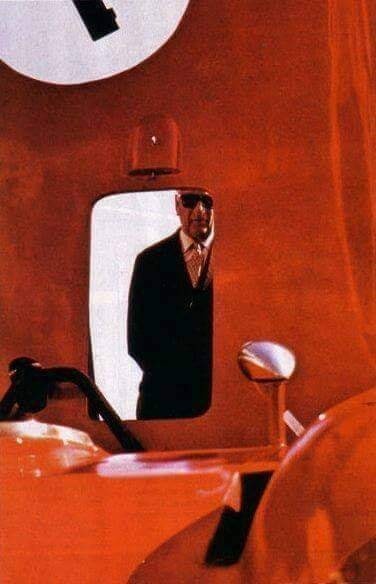
For all those who were living this way the Formula 1 Grands Prix, Enzo Ferrari represented the beginning of all this. In America he was the best known Italian. The story of his factory is a chapter in the history of contemporary costume. If life didn't spare him pain, work gave him everything he hoped for. He has won everything but his success didn’t make him proud. Despite his severe and reserved air, he was shy, hated ostentations, miracles. “Bad luck, he said, doesn’t exist”.
The memory of the Drake / Enzo Ferrari, the last farewell. By pledgetimes.com.
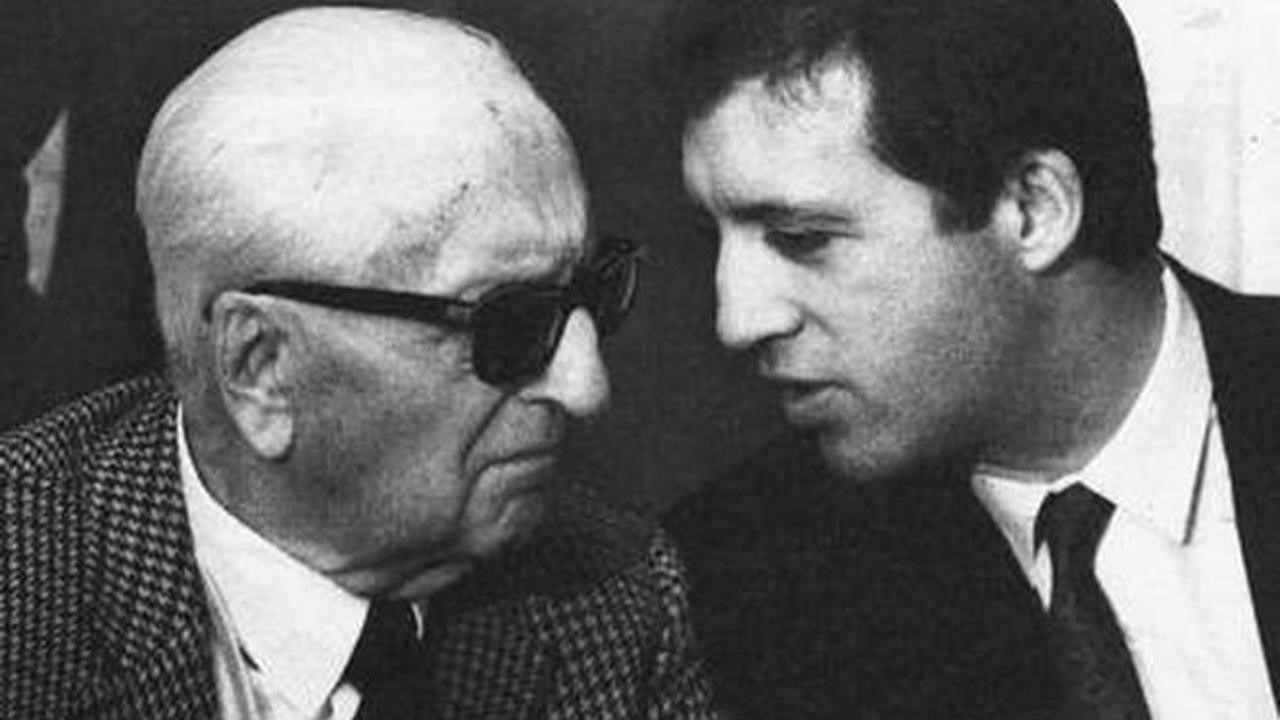
Among the people closest to him was his son Piero, then the one that Ferrari called “the sheet beater”, Sergio Scaglietti. The other great friend was Carlo Benzi, “the accountant”, who has followed the Drake since the beginning of the business. Enzo Ferrari had also foreseen an invitation to his own funeral for Mauro Forghieri, but that 14 August 1988 the engineer was far from Italy.
Through the story of these characters, having been among the figures closest to the great Modenese manufacturer, perhaps one can have an answer on Ferrari’s last will, which I interpret as the desire not to let the media know the date for the last farewell, because the “Commendatore” had the complex of journalists. Enzo Ferrari believed that the journalist had the power, the real one, in his own hands and, consequently, could be stronger than him, even though he was already a myth at the time. A living myth.
The Drake had a passion for journalism, an activity he had carried out as a young man, writing about sports news, about football, for The Gazzetta di Modena. I am convinced that Enzo Ferrari, the only profession he envied, was precisely that of the journalist. Another Ferrari regret was that he was not an engineer, despite having received two degrees honoris causa.
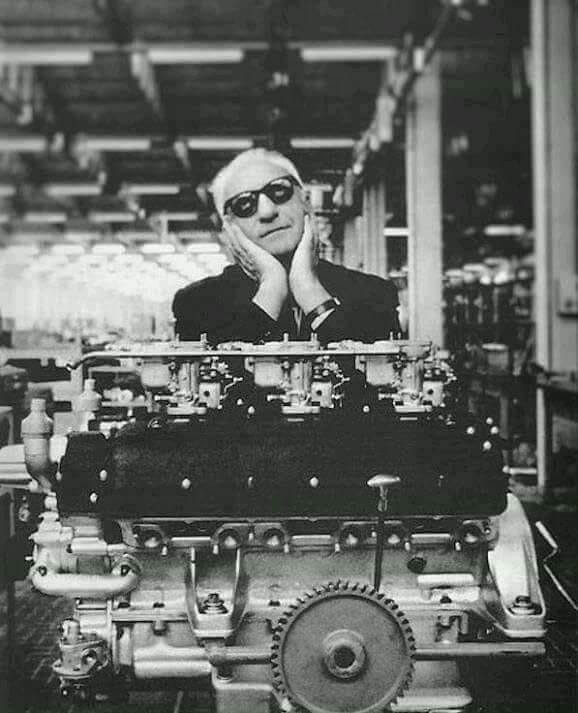
Enzo Ferrari.
Another aspect that intrigues me is that of being able to imagine what would Enzo Ferrari do today, if he were alive, in this Formula 1, with these regulations, in the situation we live in today, where the pilots have taken over the masters of the cabin. The “Commendatore” was jealous of his condition and his role, considering the drivers a “useful accessory”, because the focus of the whole “Ferrari system” was the car.
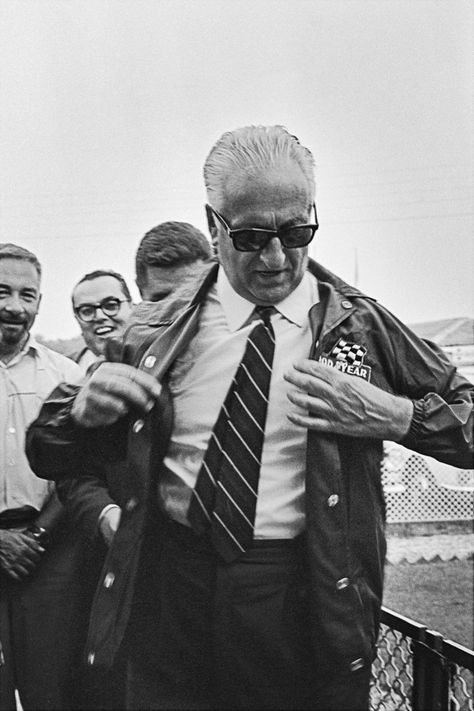
Enzo Ferrari was born in Modena on February 18, 1898, in a modest house on the outskirts of the city, to Alfredo Ferrari, a native of Carpi and owner of a small metal carpentry factory and Adalgisa Bisbini, a native of Forlì. The little one from the Ferrari family was registered in the town hall with the names of Enzo, Anselmo, Giuseppe, Maria.
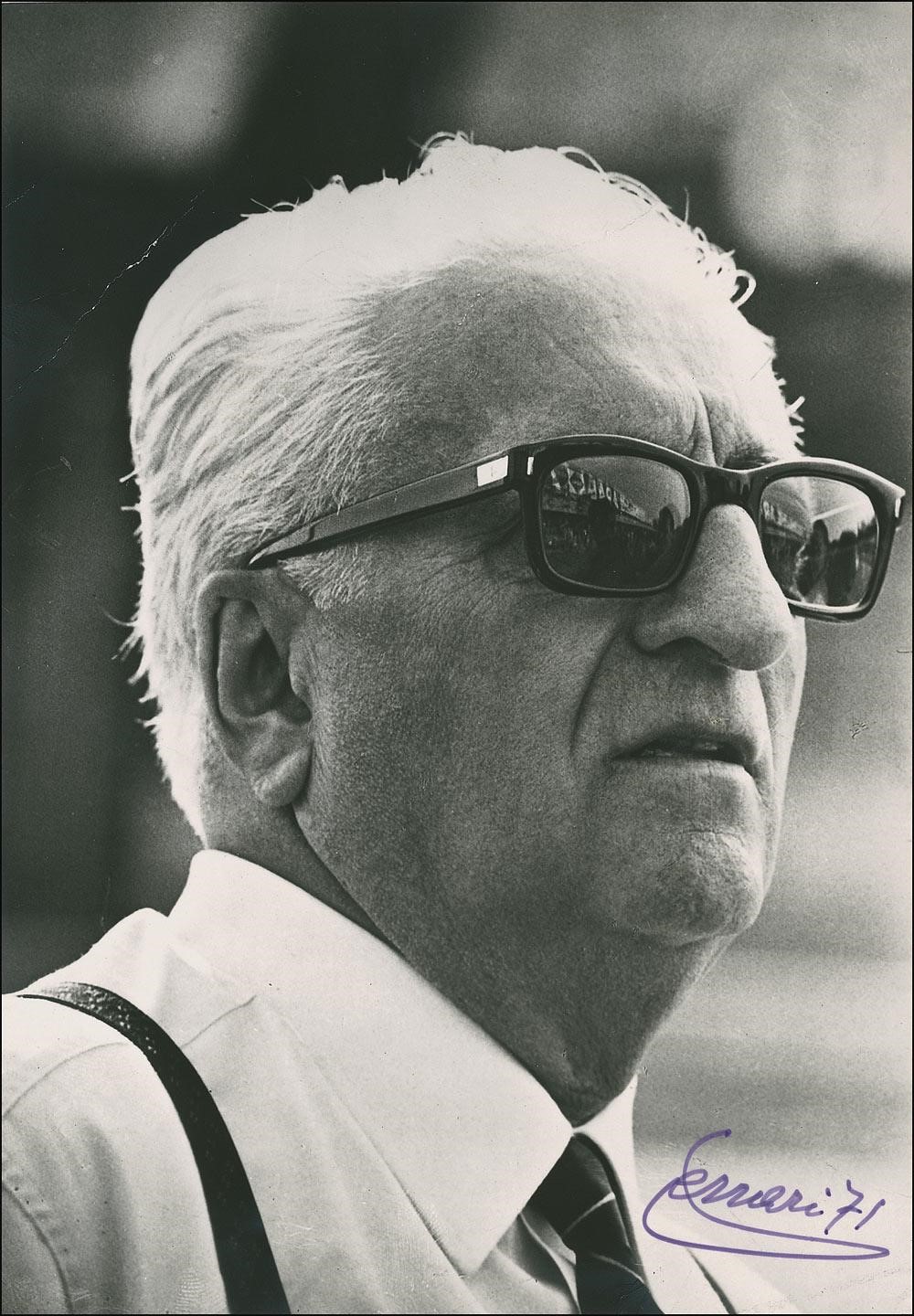
Nicknames and aliases of Enzo Ferrari, what was he called? By Claudio De Felici. June 24, 2020. In history, various nicknames have been coined for the unforgettable Enzo Ferrari, pseudonyms such as the Commendatore, the Drake, the Great Old Man, Al Mat (in Modenese dialect), the Wizard of Maranello, Saturn, the Cynic and the Patriarch.
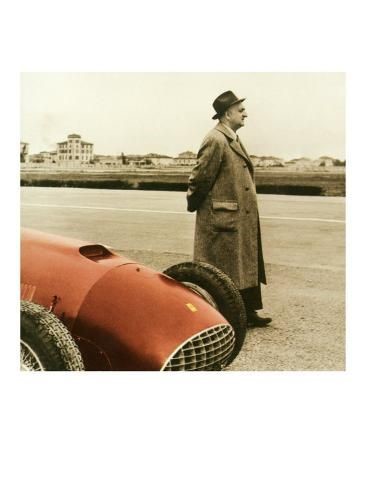
Enzo Ferrari.
The most used and best known name for Enzo Ferrari was perhaps “il Commendatore”, almost a second name. In fact, in 1927, Enzo Ferrari received the honor of Commander of the Order of the Crown of Italy. In addition to that position, on 21 December 1952, he was awarded the title of Cavaliere del Lavoro and, on 25 July 1979, that of Cavaliere di Gran Croce dell’Ordine al merito della Repubblica Italiana. His mechanics, who lived in the postwar period, crippling the Modenese dialect called him "Cumandatur", as if to derive the name from the word command. In German, a language known at the time at least in the main words, kommandatur means command, military garrison.
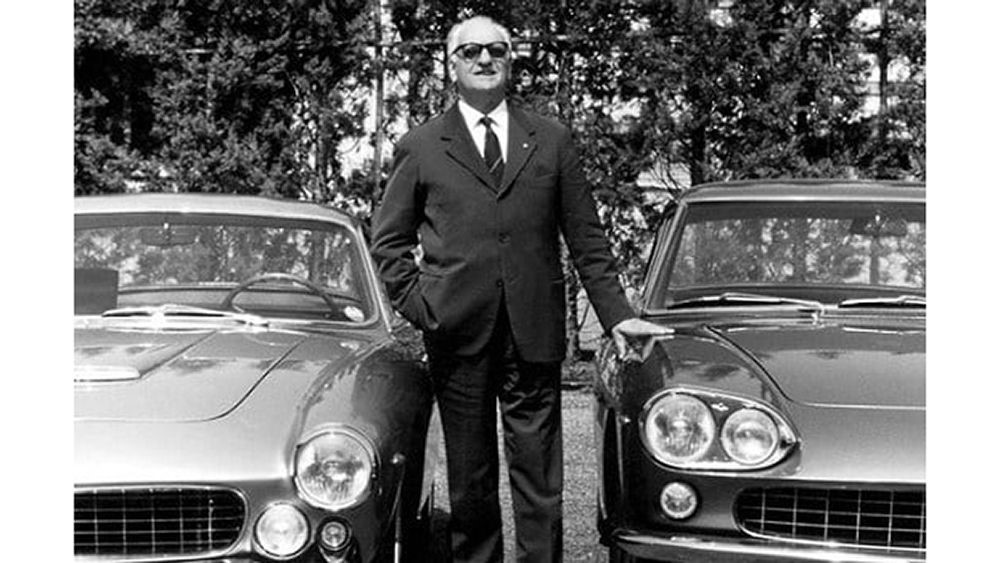
Enzo Ferrari with his beloved cars.
Another laudatory appellation of Enzo Ferrari was “il Drake”, or the dragon. A monster of skill in achieving extraordinary feats. It refers to the famous corsair Francis Drake and was coined by English opponents after World War II. A name that is a mixture of accusation and admiration for the demonstrated ability and determination of the Ferrari man in pursuing and grasping sporting results far beyond his small company, operating a dictatorial management of his team.
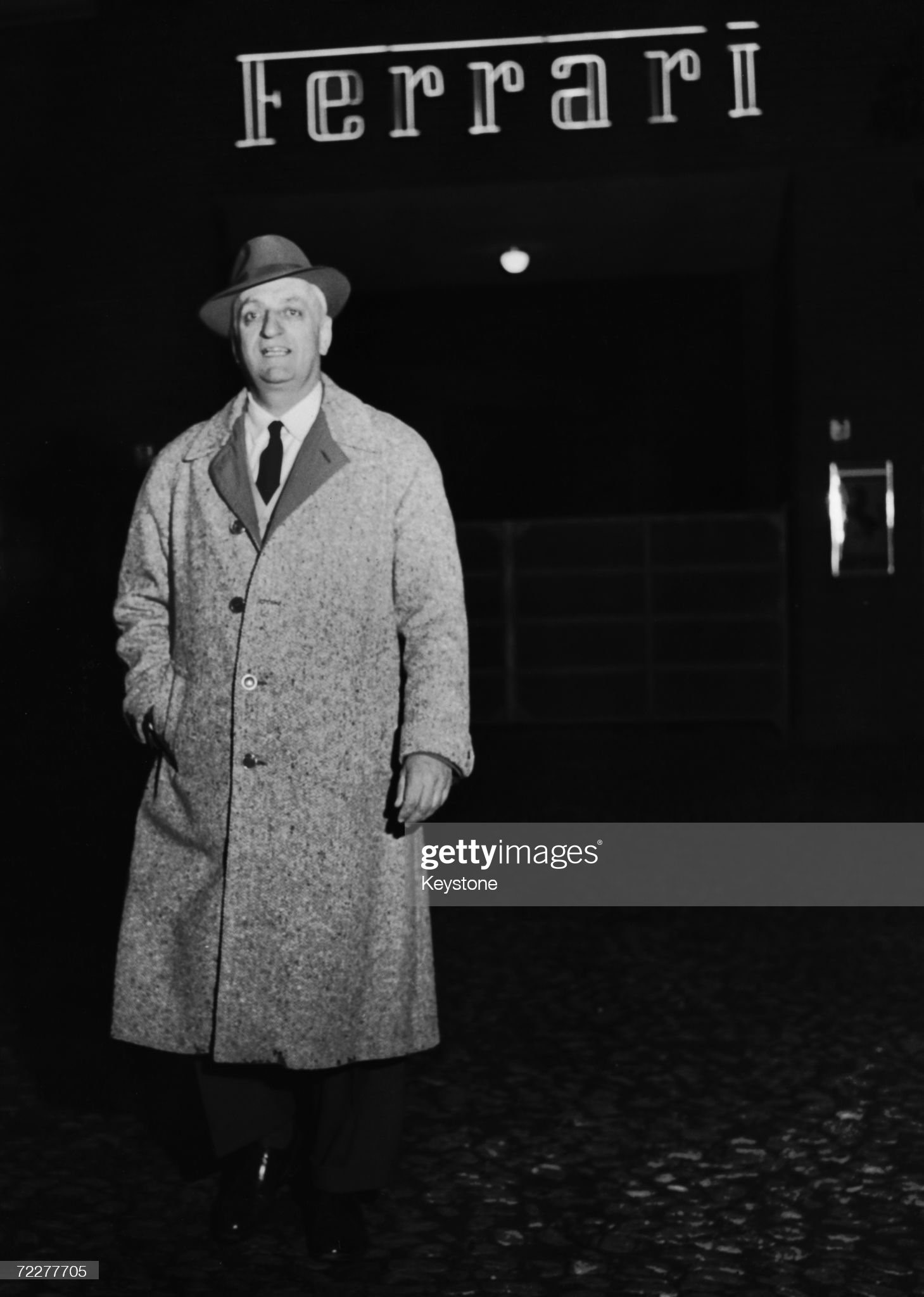
Italian car manufacturer Enzo Ferrari outside the Ferrari premises, circa 1960. Photo by Keystone/Hulton Archive/Getty Images.
Enzo Ferrari was also referred to as “the Engineer” in a referential sense. In fact, the University of Bologna awarded him, on 7 July 1960, an "honoris causa" degree in mechanical industrial engineering. In addition to this academic title, the University of Modena and Reggio Emilia, on February 1, 1988, wanted to award him an "honoris causa" degree in Physics, with the following motivation: "an authentic pioneer, he carried out an intense and productive activity in solid state physics, with particular reference to the production and experimentation of new metallic materials".
Enzo Ferrari was also nicknamed “the Great Old Man” when, even in old age, he continued to command the employees of his company with an authoritarian tone. The adjective great meant everything he had managed to build, a real empire, bringing his name to the apex of the world car market and making the cars produced in Maranello become a source of pride for our Italy.
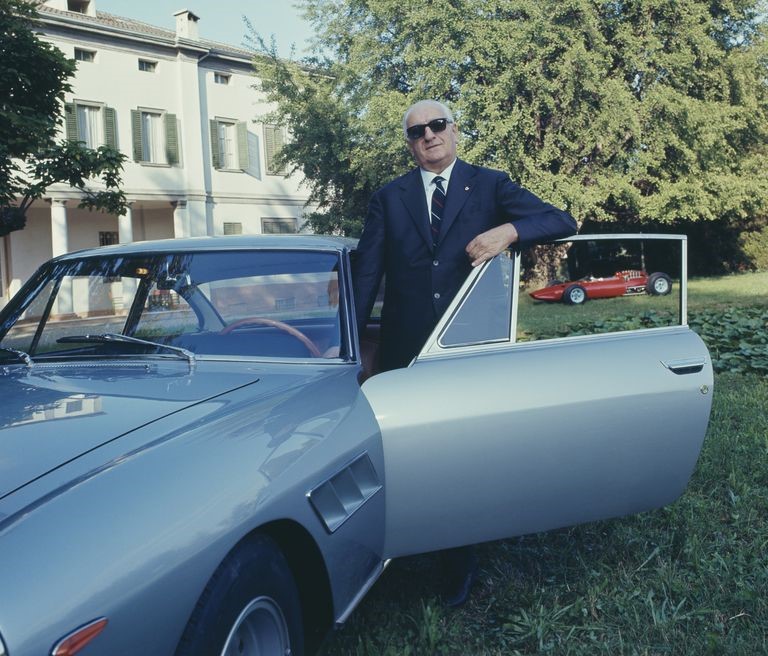
Enzo Ferrari. Getty images.
The people of Modena, his fellow citizens, defined Enzo Ferrari in dialect as "Al Mat", that is the madman. In fact, only a madman could think of setting up a car team in a country that had just emerged from the Second World War with enormous and evident difficulties.
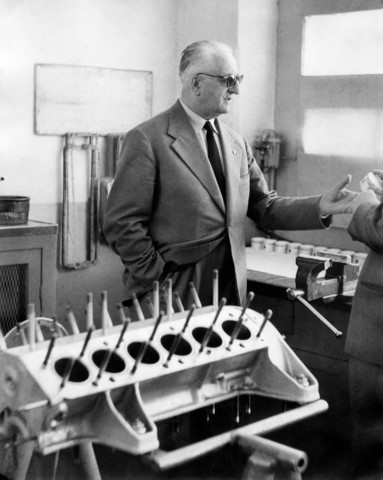
Enzo Ferrari. Getty Images.
On the other hand, after the successes obtained in the competitive field, both in the Formula One Grands Prix and in the competitions that saw Prototype cars lined up, many called him the “Wizard of Maranello”. Magician because he was able to make the drivers who raced with his cars perform legendary, almost magical, feats and deeds.
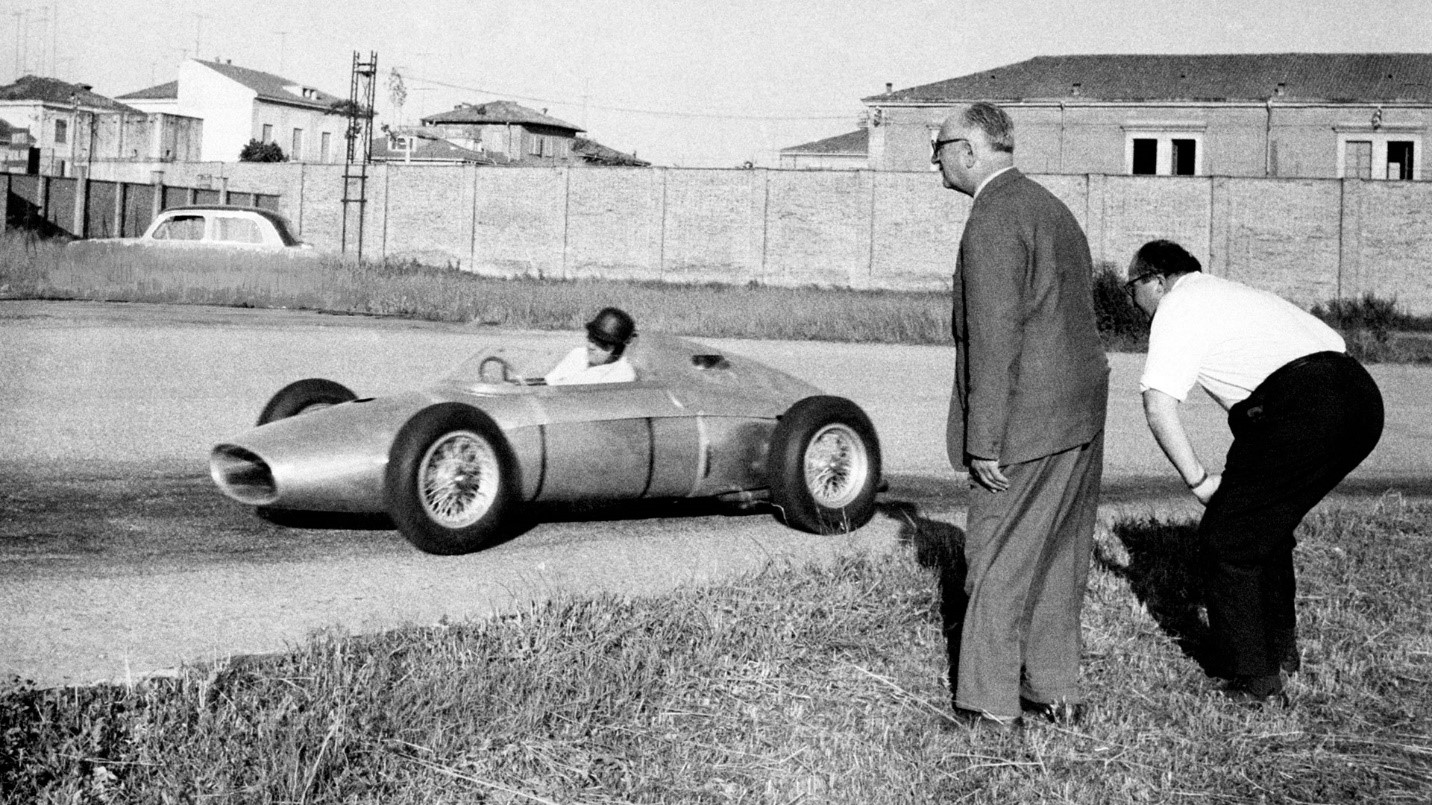
Enzo Ferrari with Carlo Chiti.
Another epithet of Enzo Ferrari was "Saturn", like the Greek God portrayed by the Spanish painter Francisco Goya in one of his paintings, who, according to mythology, devoured his children before they deprived him of power. This nickname was attributed to Ferrari after a black period that marked the history of Italian motoring. The death of the Spaniard Alfonso de Portago and his American co-driver Eddie Nelson during the 1957 Mille Miglia was declared a tragedy announced because, just two months earlier, Eugenio Castellotti, perhaps the most popular of the Ferrari drivers, lost his life on the track of the Modena autodrome just twenty-seven. At the end of that sad spring Ferrari was defined as Saturn.
Enzo Ferrari was also appealed as "The Cynic", that is insensitive to sentiments and common morals, brash, impudent, devoid of sensitivity, who flaunts contempt and mocking indifference, but also "The Patriarch", from the Greek "father-chief", with reference to the most ancient social order as head of a large family that had full and undisputed authority over all his descendants: perhaps one of the more suitable and appropriate nicknames for Enzo Ferrari.
Asked by Enzo Biagi: “of these nicknames you have been given, are there any that resemble you?” Enzo Ferrari replied: “I don’t think so because they don't know me”.
Ferrari museum of horrors / errors, history and curiosities from Maranello. By Claudio De Felici. March 14, 2019. The museum of Ferrari errors or horrors was in the meeting room, where the damaged pieces of the Ferrari F1 that had broken in the race were kept.
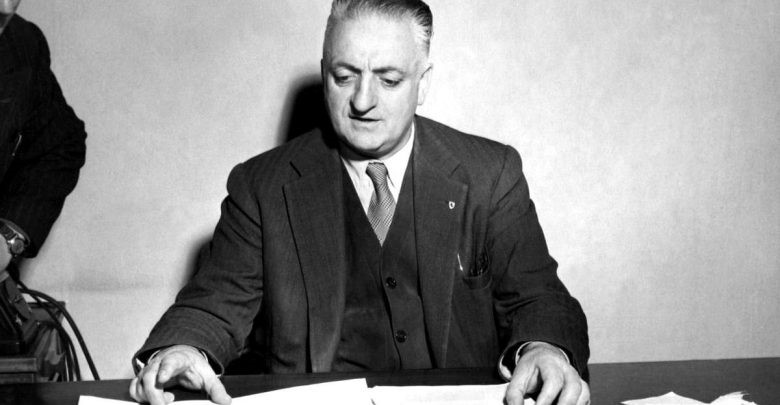
Enzo Ferrari used to collect the pieces that had caused a defeat: they were part of his museum of errors or horrors. This is Ferrari history: in the old configuration of the Maranello factory the offices were located in the building that still hangs over the entrance door to the courtyard today.
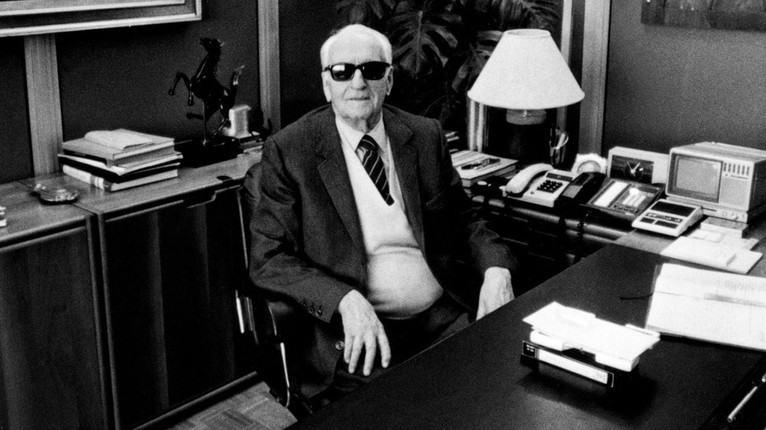
Enzo Ferrari's office was on the left, just after the entrance, with four windows from which the Commendatore could control practically any movement. A staircase led to the upper floor, where the meeting room was.
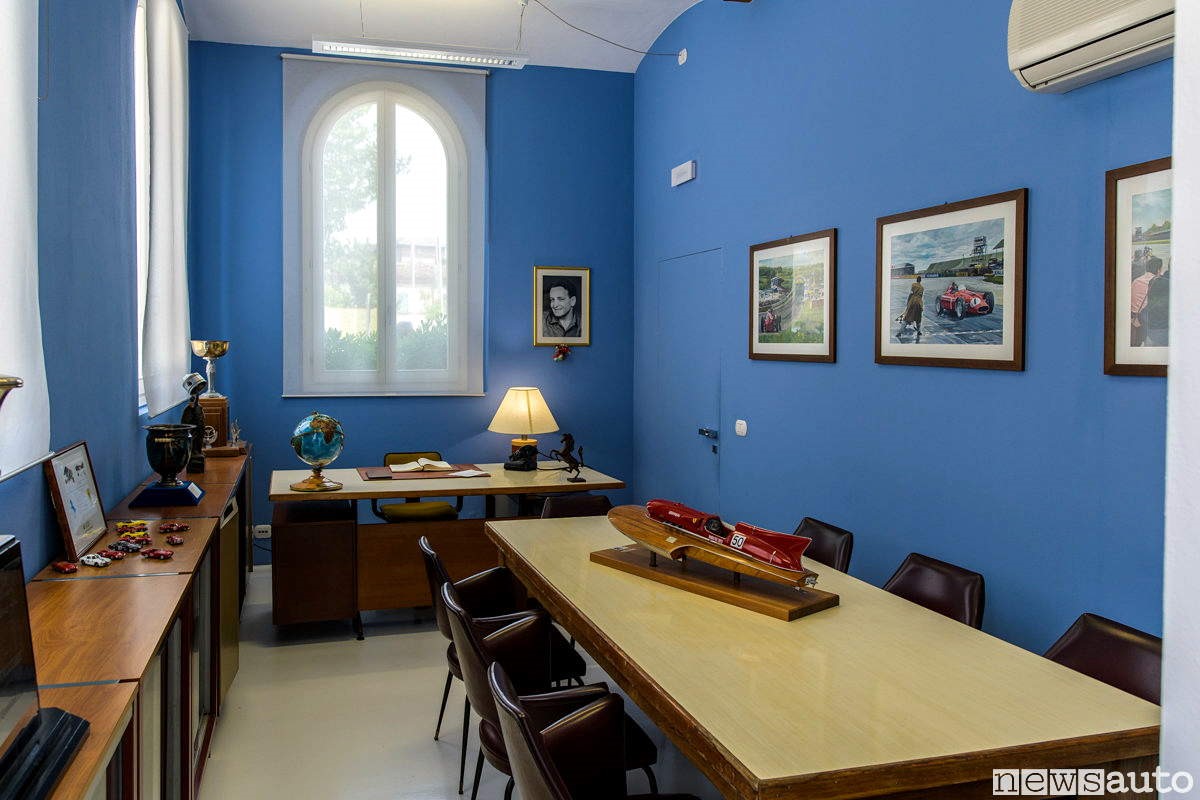
Enzo Ferrari's office in Maranello.
This environment, with the passage of time, had taken on particular characteristics and it is a pity that, in the renovation of recent years, the original configuration has been lost, as the commercial offices have now been transferred.
From a certain point on, the meeting room was called the "museum of errors". It was a small room with a long table in the center, surrounded by a dozen chairs and with a series of glass cabinets on the walls.
The fact that had led to that curious denomination was that in the display cases there were a series of racing car parts: pistons, valves, connecting rods, gears, drive shafts, each with a tag indicating a date and place. Date and place corresponded to a race lost due to the breaking of that piece which was therefore kept for future memory.
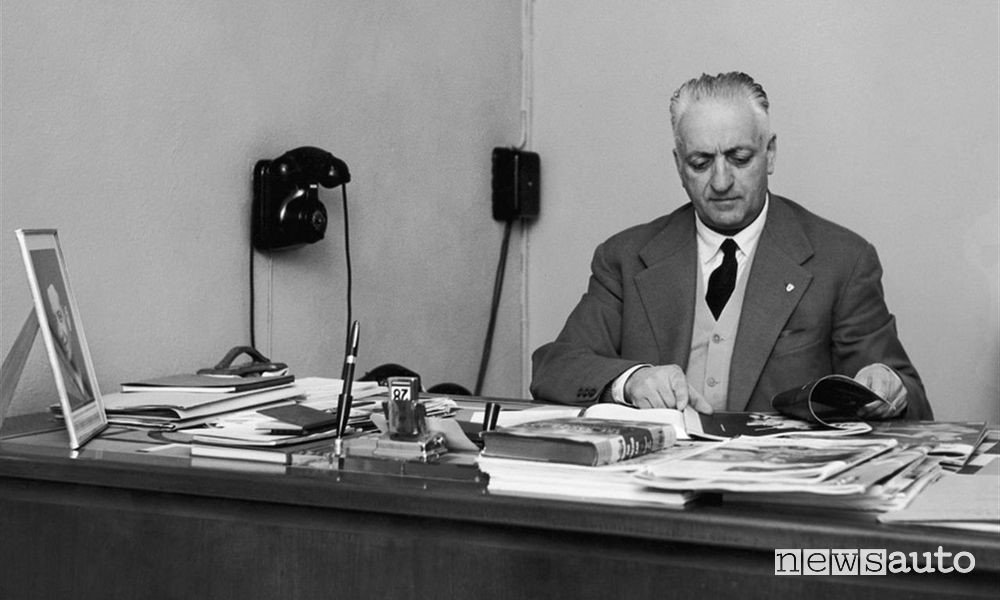
The old collaborators of the Drake say that, every time the failure of a piece occurred, the whole episode was discussed by the technicians under the supervision of Ferrari himself, who didn’t fail to stigmatize the possible inefficiency of those who had studied, calculated and created that piece, in a real "Monday trial".
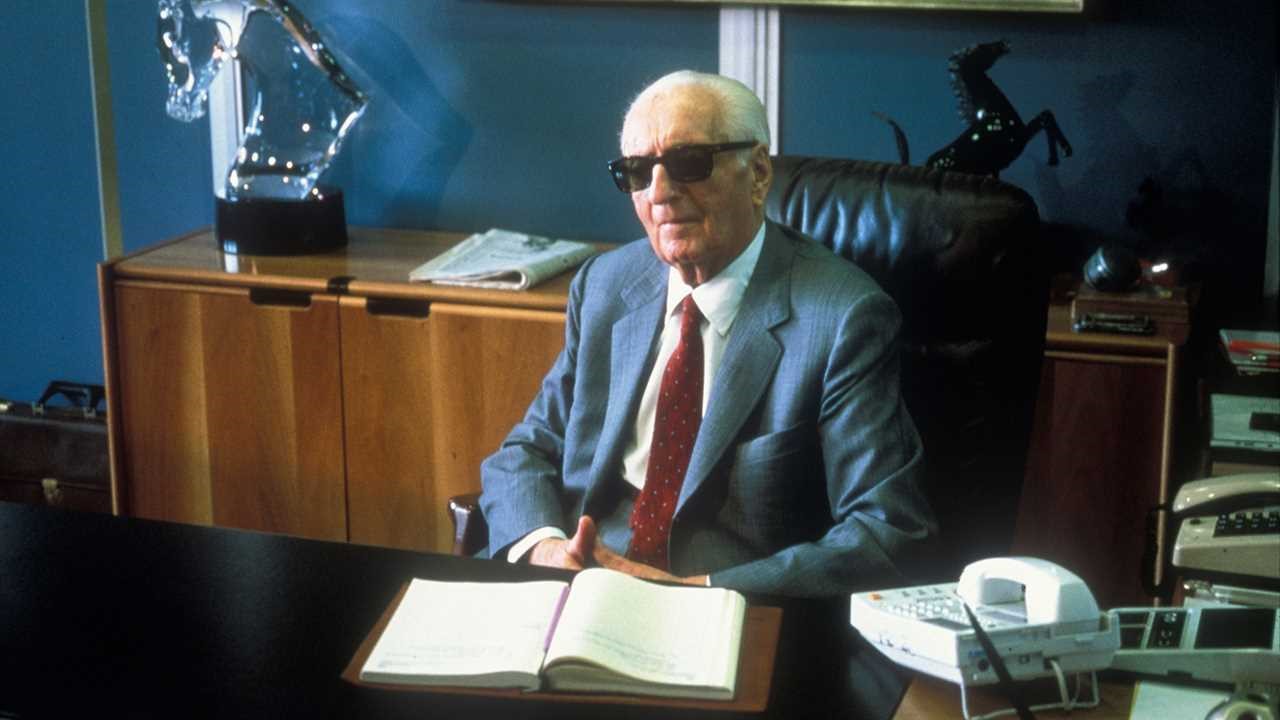
All this took place as long as the Ferrari cars were almost completely built in-house.
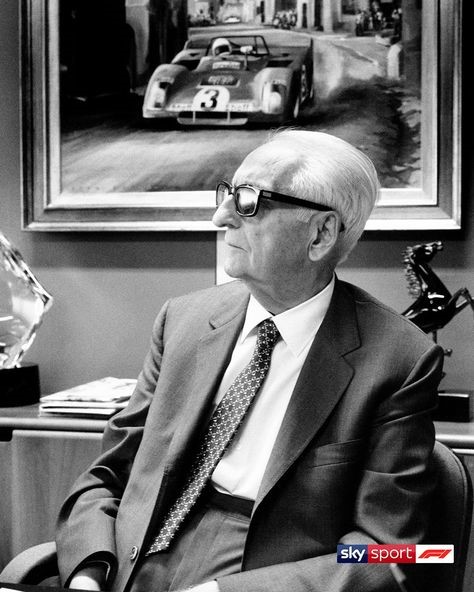
Nowadays, with the massive use of external suppliers for specialized items, such a thing would no longer make sense. This is perhaps why the famous museum of errors has disappeared. But, with its memory, someone still trembles ...
History of the Ferrari logo with the symbol of the prancing horse donated by Baracca. By Claudio De Felici. July 31, 2019. The history of the Ferrari shield with the Prancing Horse, the symbol of Ferrari that the legendary Drake received as a gift from the family of the aviator Francesco Baracca.
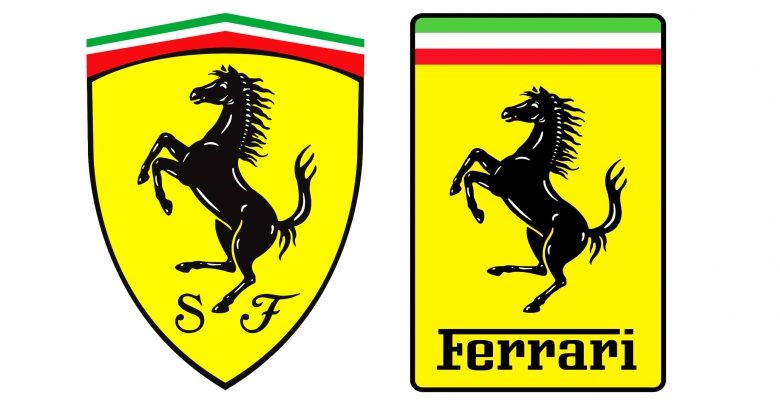
Many people have wondered and are still wondering what was the origin of the "Prancing Horse", the distinctive symbol of the Ferrari industry, of its cars and of everything that revolves around them, known and appreciated all over the world. Below is the answer to the curiosity of interested people.
Ferrari history
Enzo Ferrari's mother was originally from Lugo di Romagna, a town that was also the birthplace of Francesco Baracca, pilot of fighter aircraft, ace of the First World War with 34 victories in aerial combat, Gold Medal for Military Valor, who fell on the slopes of Montello on 19 June 1918.
Major Baracca was a Cavalry Officer and, before obtaining the airplane pilot license and passing through the "Aviator Battalions" of the Royal Army (the Royal Air Force, which became Air Force after the proclamation of the Republic, will be constituted as an autonomous Arms only on March 28, 1923), had served in the 2nd “Piemonte Reale” Cavalry Regiment, a department with over two centuries of history and with significant traditions, having been founded in 1692, third in chronological order in the Savoy Armed Forces.
The heraldic coat of arms of "Piemonte Reale" includes a prancing horse of silver color on a red field, the distinctive color of the Regiment. As evidence of his emotional bond with the Arms of origin, Baracca, as soon as his aerial activity began, had the 2 - ordinal number of the Regiment - and a red princing horse painted on the fuselage of his aircraft, recalling the color that distinguished this Regiment.
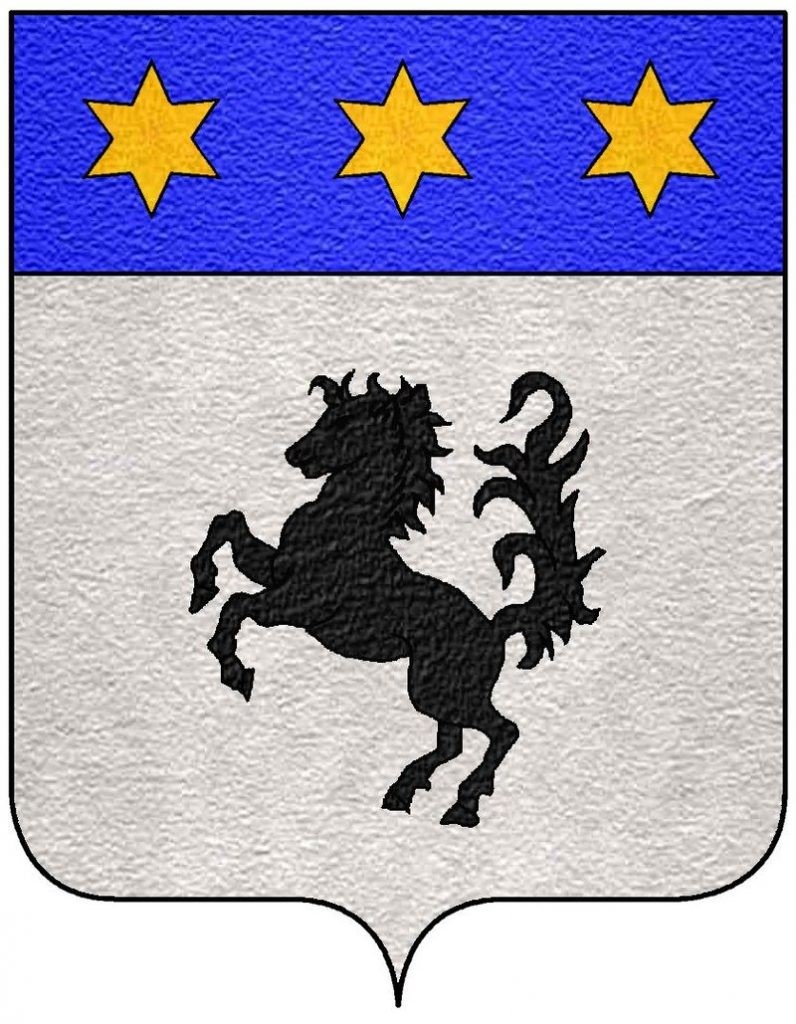
Heraldic coat of arms of the Baracca family with the Prancing Horse logo.
Only later and following the purchase of a black horse of which he soon became fond, Baracca changed the color of the prancing horse from red to black, enclosing it within a white cloud and thus representing, in a symbolic way, a knight reached out into the heavens.
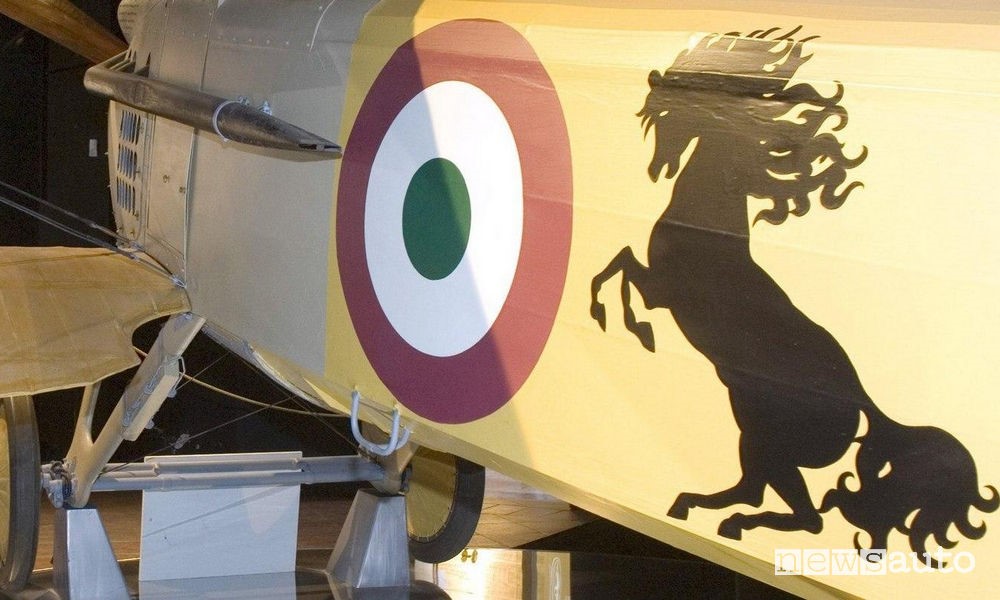
Enzo Ferrari's first race.
In 1923 Enzo Ferrari participated, winning it, in the “Circuito del Savio”, an important car race that took place on the dirt roads near Ravenna. The competition was also attended by Count Enrico and Countess Paolina Baracca, parents of Francesco, who, enthused by the courage and daring shown by the young Ferrari, entrusted him with the glorious symbol of their fallen son, so that he could take him back to the competition, no longer warlike but sporty.
These are the words of Enzo Ferrari himself: "when I won in 1923 the first “Circuito del Savio”, which was raced in Ravenna, I met Count Enrico Baracca, father of the hero; from that meeting the next one with his mother, the Countess Paolina, was born. It was she who told me one day: 'Ferrari, put my son's prancing horse on your cars. It will bring you luck'. I still have the photograph of Baracca with the dedication of the parents in which they entrusted me with the emblem. The horse was and has remained black; I added the canary yellow background which is the color of Modena".
The Ferrari coat of arms given by the Baracca family
Enzo Ferrari gladly accepted the gift given to him, but slightly transformed the emblem by modifying it in three details. The Ferrari emblem, in fact, has the horse with the tail facing upwards, the background is yellow - the color of the banner of the city of Modena - and is surmounted by a tricolor band.
There are two versions of this Ferrari emblem today.
The first, rectangular in shape, constitutes the commercial trademark of the car manufacturer and appears on all the cars built in Maranello; it is equivalent, so to speak, to the three-pointed star of the Mercedes, the four circles of the Audi, the diamond of the Renault or the trident of the Maserati.
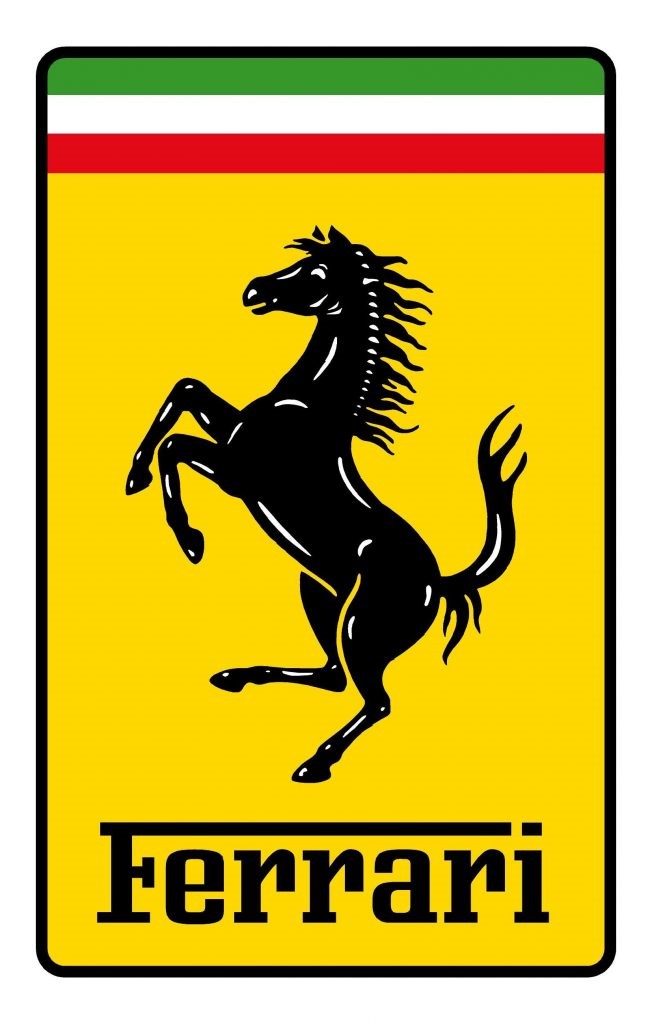
Rectangular Ferrari logo.
The second, in the shape of a shield with at the base the letters S and F in black uppercase italics, is typical of the Scuderia Ferrari; strictly speaking, it should be affixed exclusively to the cars used in racing directly by the parent company.
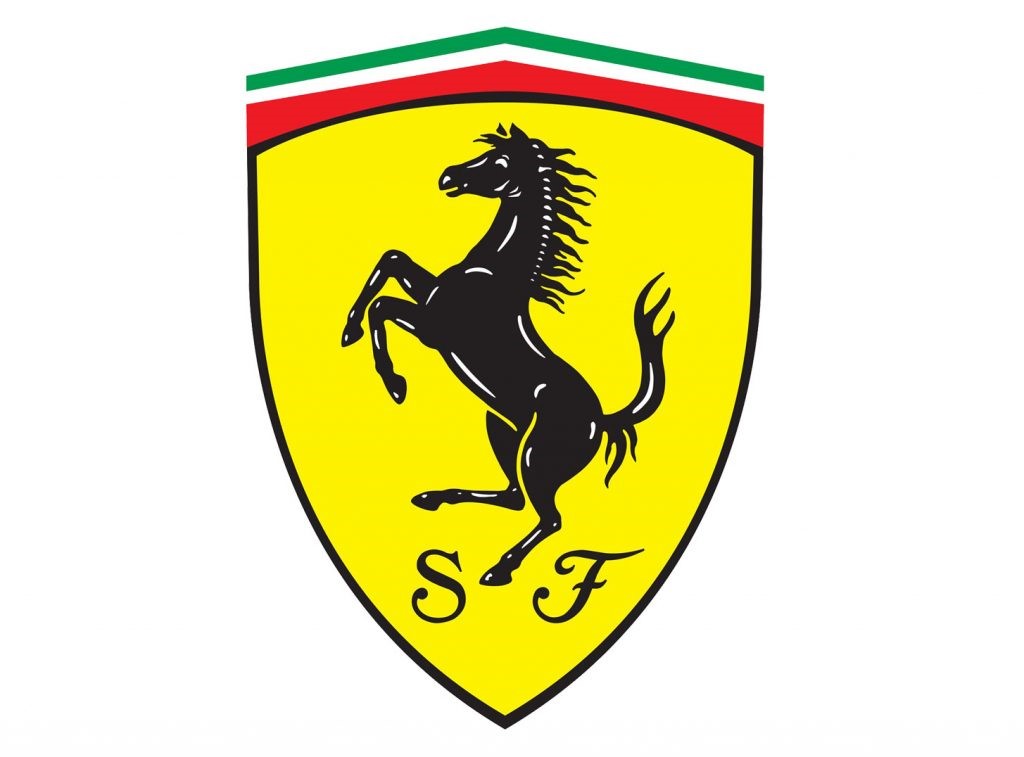
Ferrari logo in the shape of a shield.
Ferrari played a decisive role in the costume of the Italians, soon becoming a status symbol for the most prominent people and a dream for everyone else. By Claudio De Felici. August 19, 2020.
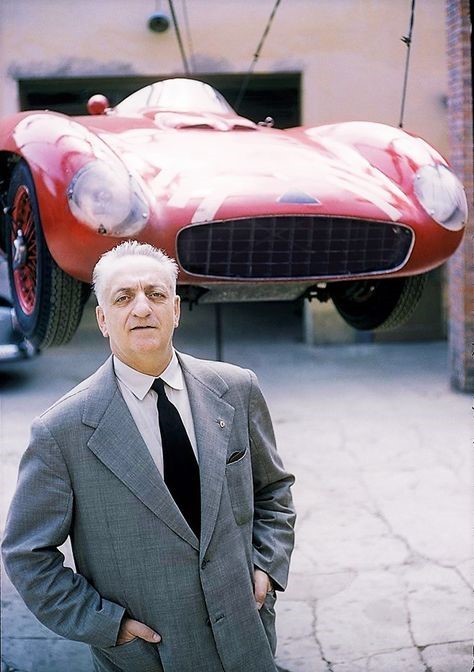
Certainly the fact that Ferrari, both in the past and in the present, has never advertised the cars produced either on newspapers or through other media channels is certainly relevant.
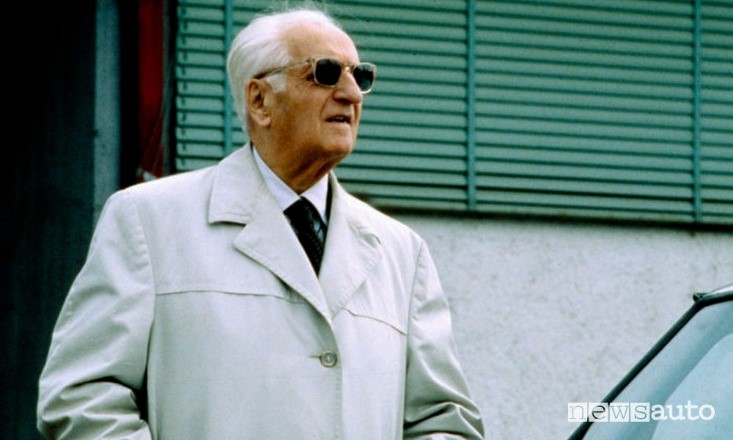
Enzo Ferrari by his will never wanted to advertise his creation.
This corporate setting, strongly desired by Enzo Ferrari and maintained over time by all those who took turns at the helm of the company, originates from the fact that advertising was replaced by the echo resulting from victories in races. In fact, almost 10,000 were the successes achieved by Ferrari cars in competitions held on five continents. This fact meant that Henry Ford junior, the magnate of the American car industry of the same name, one day said with a pinch of envy: "I spend a fortune to advertise my cars while Mr. Ferrari is on the front pages of all the newspapers every Monday without spending a cent".
August 14, Ferragosto’s eve, the third most important Italian holiday after Christmas and Easter of the Resurrection, is the anniversary of the death of Enzo Ferrari. By Claudio De Felici. February 18, 2020.
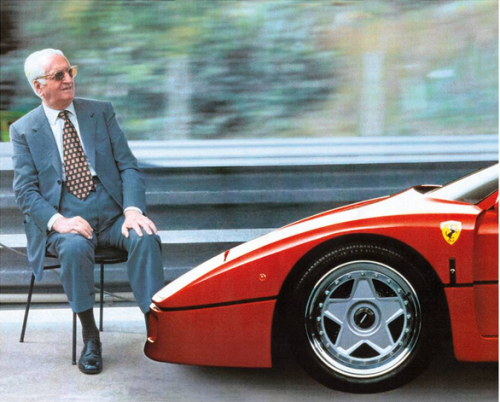
Enzo with his last proper Ferrari, the F40.
Exactly at dawn on August 14, 1988, thirty-one years ago, the Commendatore passed away. By his own will the news of his death was kept in great secrecy because he had given the order to his loved ones and trusted collaborators to communicate it after the funeral. Perhaps it was the last joke of the Drake to journalists, not much loved by Ferrari himself, who, sidetracked, could publish the shocking news in the media only on the morning of August 16, 1988, or two days after as had happened ninety years earlier on the occasion of his birth.
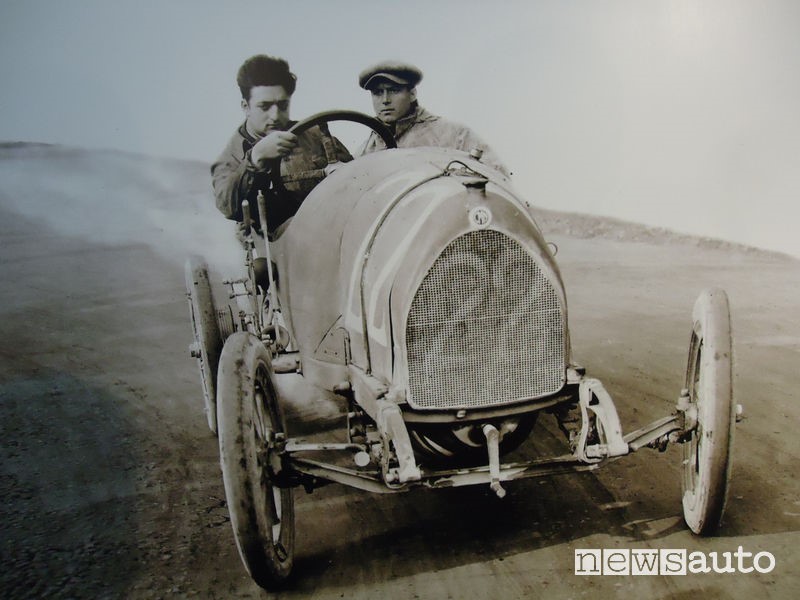
Enzo Ferrari young driver.
Few people took part in Ferrari's funeral ceremony, held on August 15th in the cemetery of San Cataldo in Modena.
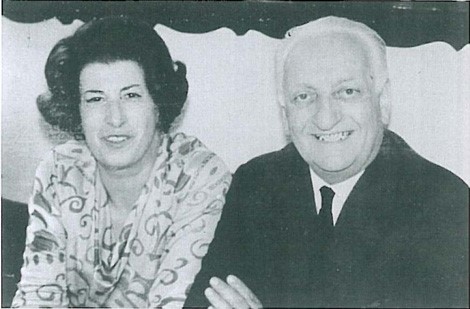
Enzo Ferrari and Lina Lardi.
In addition to Mrs. Lina Lardi, his son Piero together with his wife Floriana Nalin and his daughter Antonella, there were also the Drake's right arm Franco Gozzi, the engineer Mauro Forghieri, the coachbuilder Sergio Scaglietti, the personal accountant Carlo Benzi, the trusted driver Dino Tagliazucchi, the bodyguard Valdemaro Valentini, the historical chief mechanics Antonio Bellentani and Giulio Borsari.
This is the official press release from Fiat following the death of the Commendatore: “Fiat expresses deep condolences for the death of Enzo Ferrari. What distinguished him from any other character in the automotive world was that he had always been totally absorbed by engines and technology. This made him unique. A pioneer in a rapidly evolving sector, with his cars he made an exceptional contribution to sport. His great entrepreneurial skills, his will and his tenacity, have led Ferrari to establish itself everywhere, giving an extraordinary contribution to the image of Italian industry. A legacy that Ferrari will certainly carry on along the lines of its founder".
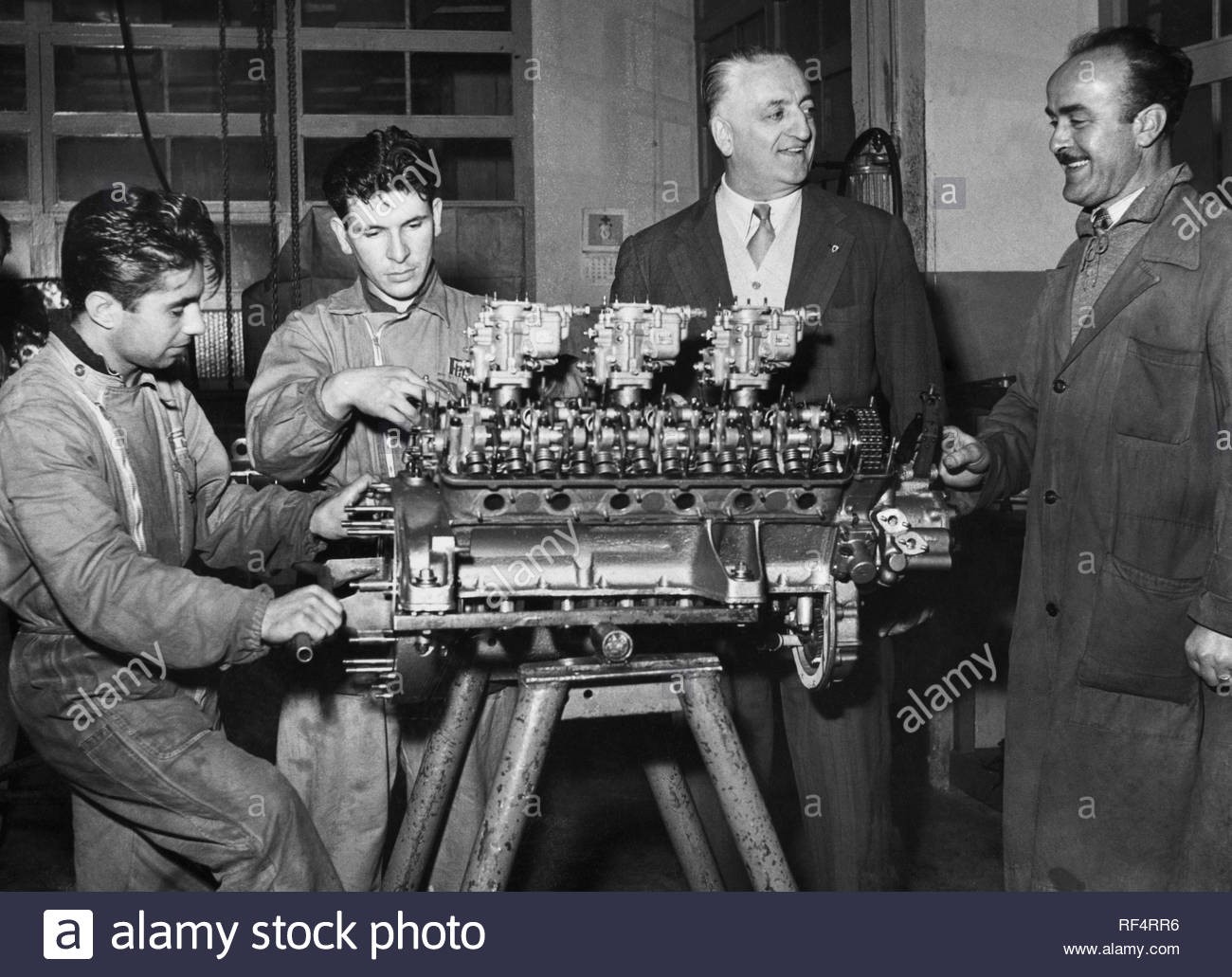
Enzo Ferrari in Mantua in 1955.
Below is the mood of the drivers who raced for Ferrari interviewed after his death and the expressions of those who met the Drake:
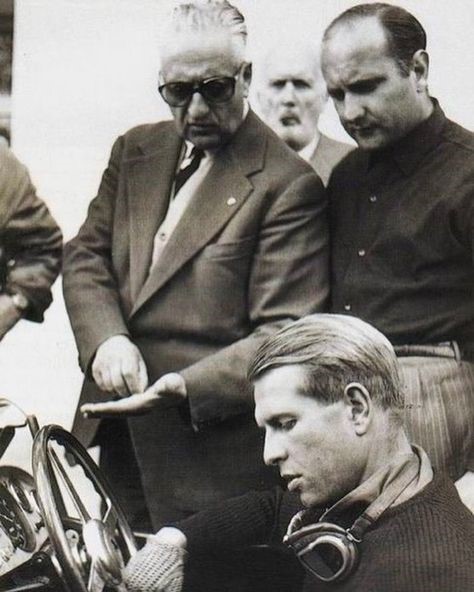
Enzo Ferrari, Juan Manuel Fangio and Peter Collins.
Juan Manuel Fangio: “I have always had good relations with Enzo. Although we didn't meet often, he was always friendly to me. I have always had a deep respect for Ferrari for what he has done. And he was a man who had great merits. He is an example to the world. And that is why I propose to erect a monument to him”.
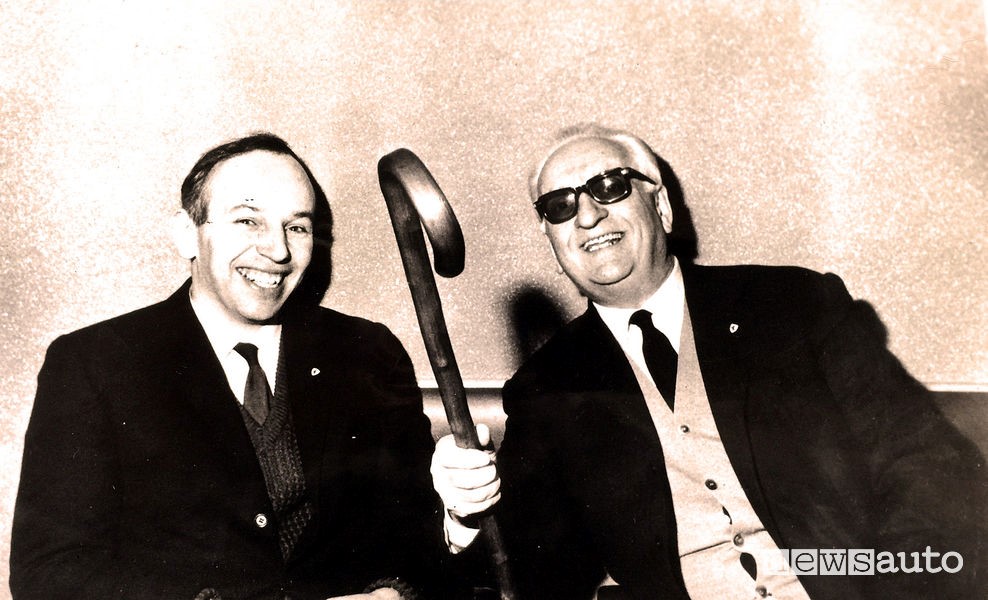
John Surtees with Enzo Ferrari.
“He had a difficult character, it's true. But I don't bear a grudge: anyone who knows how to do and get what Ferrari did and got has the right to have a character that is not always accommodating. Ferrari was the center of a small kingdom totally dedicated to creating the cars he wanted and he produced truly sensational ones”. John Surtees
Carlos Reutemann: "our relations were neither romantic nor rosy because, when I started racing for Ferrari, there were many problems: we were experimenting the Michelin tires and there was a fight against Andretti's Lotus. Although Ferrari's opinion of me was not the best, I generally have good memories of him. And, in particular, I always think of the first time I saw him in Maranello, in 1973, to race with a Ferrari Sport".
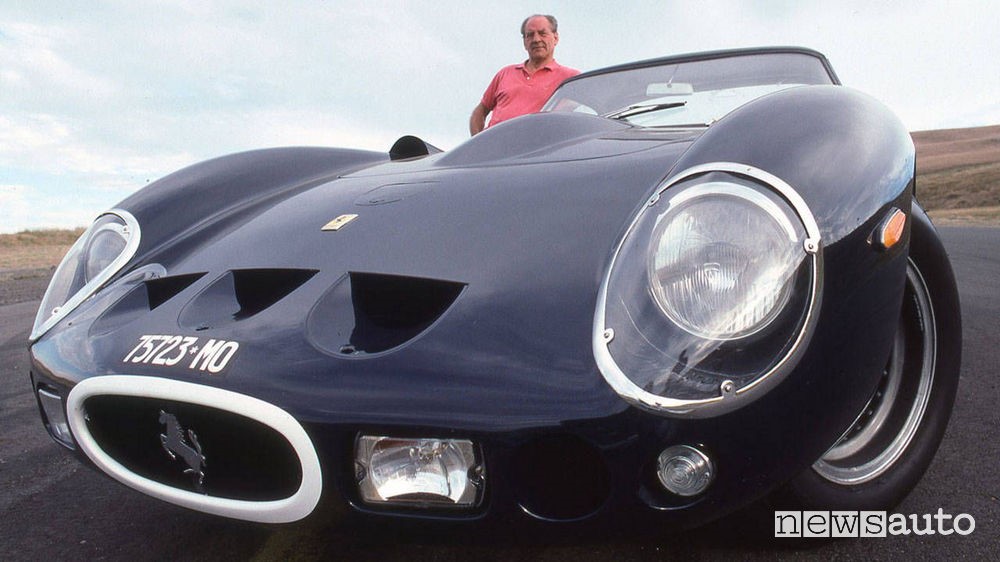
Innes Ireland and the Ferrari 250 GTO. Ireland was not just a great race driver but one of the more entertaining characters in the racing world.
Innes Ireland, British driver: “Ferrari is and will remain a legend. It was not easy to have relations with him because of his aggressive personality, even dictatorial. But he knew what cars he wanted and how to get them built. He was ruthless and yet, in his way, sentimental. The last time I saw him a year ago, he told me about the recent death of his friend Cortese, the first driver to have led a Ferrari to victory. His voice began to tremble, tears came to his eyes and he was silent for a few moments. Then he composed himself and spoke again”.
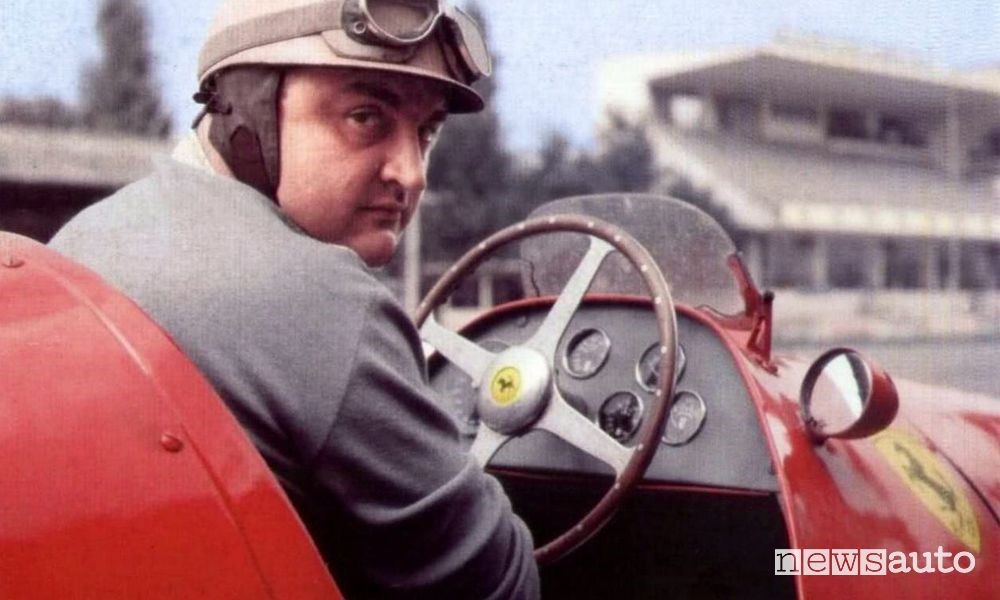
On 14 July 1951, Jose Froilan Gonzalez drove his 375 F1 to take the first victory for Ferrari in the Formula 1 World Championship.
Froilan Gonzales: "Don Enzo had a special attention to me as I was his first driver to take a Ferrari to triumph in the British Grand Prix in 1951. Don Enzo had a very strong character. A perfectionist who will remain in the history of motoring because he managed to save the team after the Second World War, at a time when there was no money in Europe. In any case, Ferrari was aware that death was near because last year, when we met for the last time, he was moved as never before and told me that we would probably never meet again".
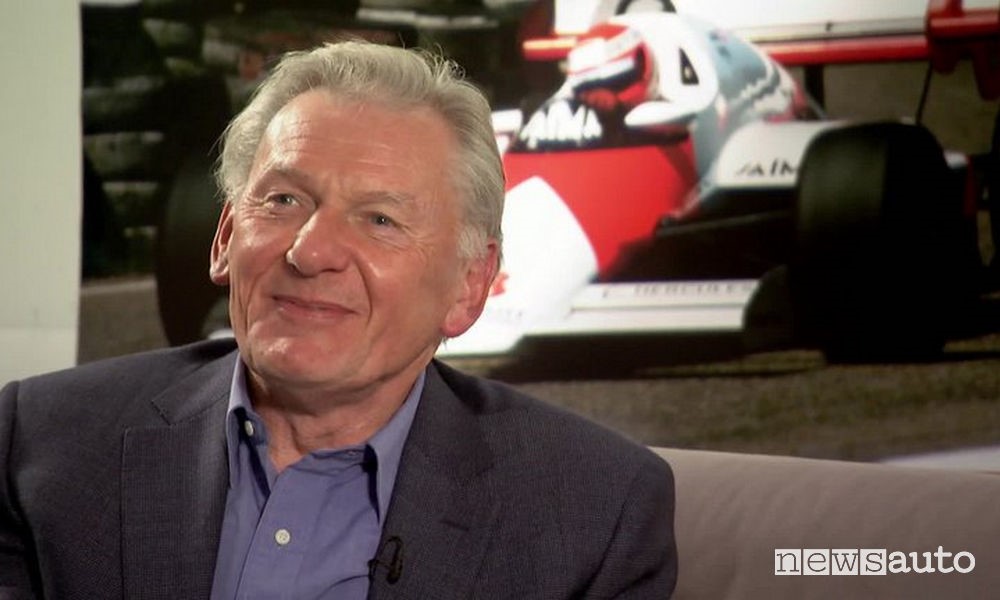
John Barnard.
John Barnard, Formula One designer: “it is very sad the passing of Enzo Ferrari, an eminence of motoring. His name remains in the hearts of true fans".
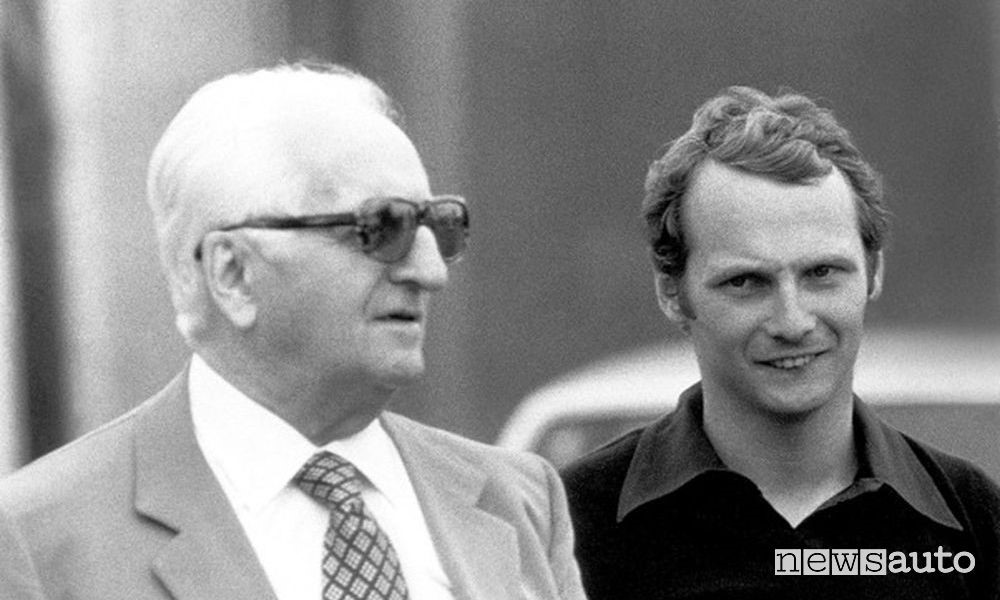
Enzo Ferrari with Niki Lauda.
“With the Drake the greatest personality that I have ever come close to has disappeared. With his charisma he animated a car that lives because Enzo Ferrari is behind it. He lets his car live and the whole world knows a Ferrari. When I ask my seven-year-old son, he knows that Ferrari is a car. This is only possible because he is behind it." Niki Lauda
Gerhard Berger: “Ferrari is one of those men who are not easily forgotten. For me, driving one of his cars was and is a source of pride. I must say that, when this possibility was proposed to me, I said yes, refusing other offers perhaps more advantageous, because I was attracted by the myth of the character rather than by his cars. And I think the same thing has happened to many other drivers before me”.
"Now driving a racing Ferrari without Enzo Ferrari will never be the same, because the most important thing was to drive for Mr. Ferrari." Patrick Tambay
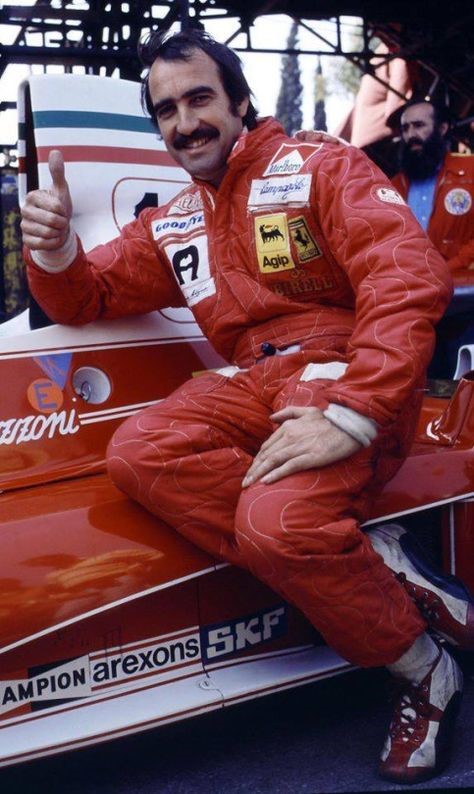
Clay Regazzoni: "with the passing of Enzo Ferrari modern motoring has lost its last pioneer, a heroic character. The world of Formula One is now the domain of managers and becomes more industrialized day by day. I don't know what Scuderia Ferrari will do after this big loss; a precious point of reference will certainly be missing".
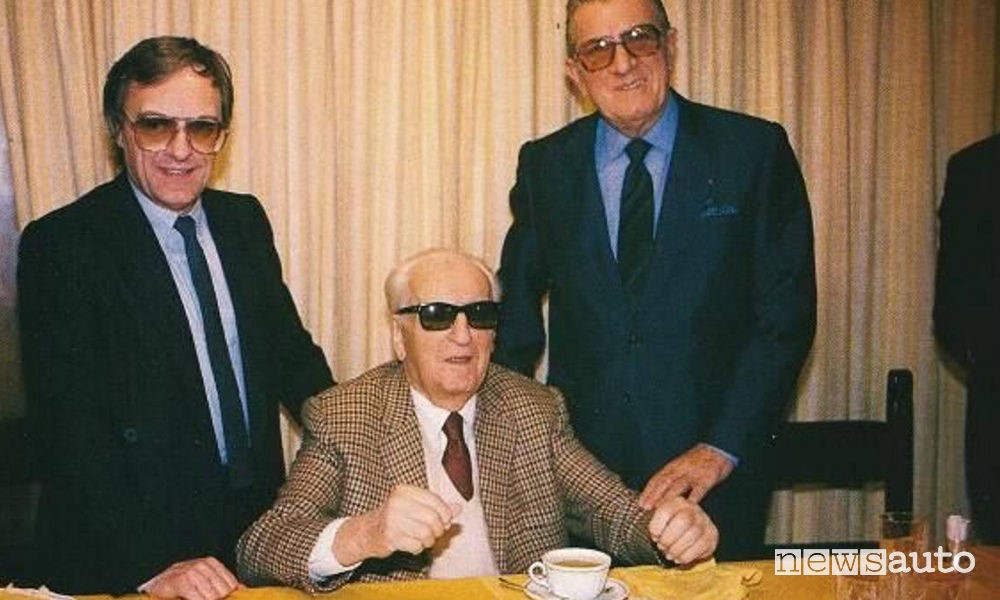
Bernie Ecclestone, Enzo Ferrari and Jean Marie Balestre.
Jean Marie Balestre, president of FISA (Fédération Internationale du Sport Automobile): “Formula One will no longer be as it was in the past. Sport is in mourning. The legendary figure of racing cars has disappeared. Nothing in racing will be the same as before".
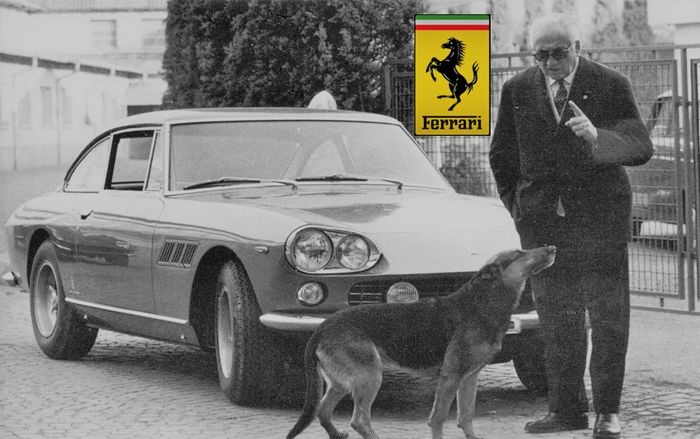
Once, in the paddock of Monza, I heard Henri Pescarolo utter one of the strangest, apparently disturbing and substantially fascinating phrases that one can come across, namely this: «in my opinion the principle that sees all men alike is chromosomally false. They must be for dignity and a guaranteed starting point, of course yes, but then, once the go signal is given, each one makes his own run and turns out to be different, very different from the other. And you meet very rare men who are interesting to listen to, to experience and taste and too many very uninteresting. The secret, always respecting everyone, is to always be and look for the interesting ones. That's all".
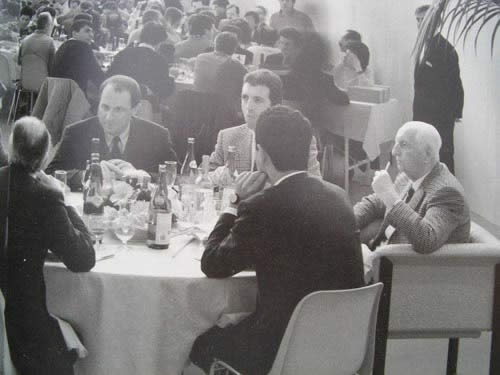
The dinner at the factory for Enzo Ferrari's 90th birthday in 1988.
Enzo Ferrari remains among the most precious, surprising and magnetic characters in the entire history of competitions. Ninety springs lived, 1898-1988, of which at least seventy in direct contact with racing. Witness of precious, unique and unrepeatable time not only for victories, goals and creations but also for the quality of races, champions and cars under direct management. As an agitator of men and technical problems, as he loved to repeat captioning himself.
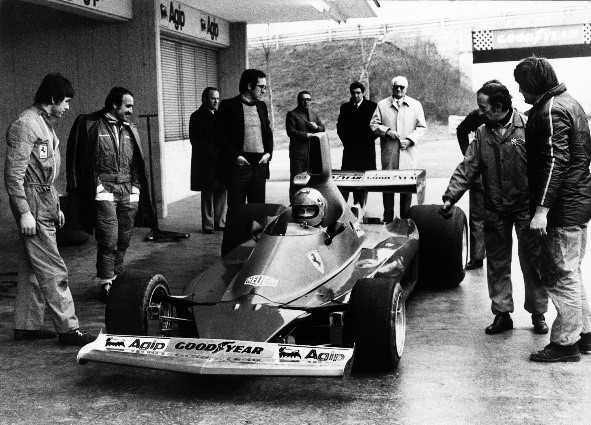
But there is more to represent the adamantine exudate and, even more finely and intellectually enjoyable, the most noble area, the Champions League of the Drake, considered as a stage man and producer of exceptional texts and theatricality.
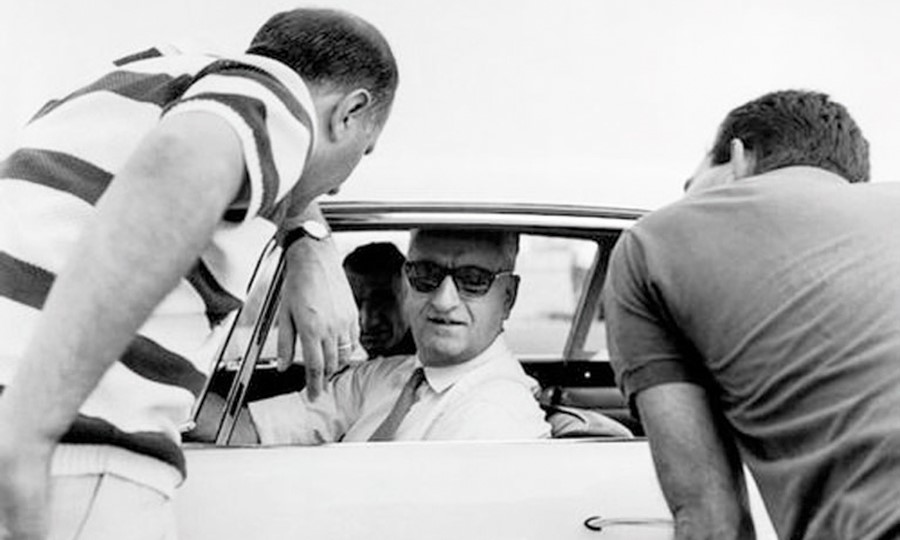
Yet another film will tell Enzo Ferrari's story. This one is said to focus particularly on his life in 1957.
Enzo Ferrari aphorist and histrionist, the argumenter, the actor's machine, the man who can handle the scene magnificently anyway, with anyone and in front of any audience, relentlessly hypnotized.
Enzo Ferrari capable of producing off the cuff structured thoughts that become brocards, pearls, beautiful crystallizations of character and thought. Presumably more belonging to the sphere of the concrete and the rational than to the domains of the visionary and the oneiric, of course, but, at the same time, reasonings that reveal a restless, strong-willed soul and with a courageously straight and never vaguely or sterilely sinusoidal course.
Hearing, listening directly or reading Enzo Ferrari is one of the great pleasures of life for the hard and pure enthusiast. Because, yes, behind the car and the competition he always sees the challenges of everyday life and far beyond the man and the existential nuclei, the very human rages elevated to an intimate confession and a very personal school of life proposed not without the surprising wit, the sudden playful effervescence, the flashing splinter of irony, often garnished with the ruthless blade of sarcasm.
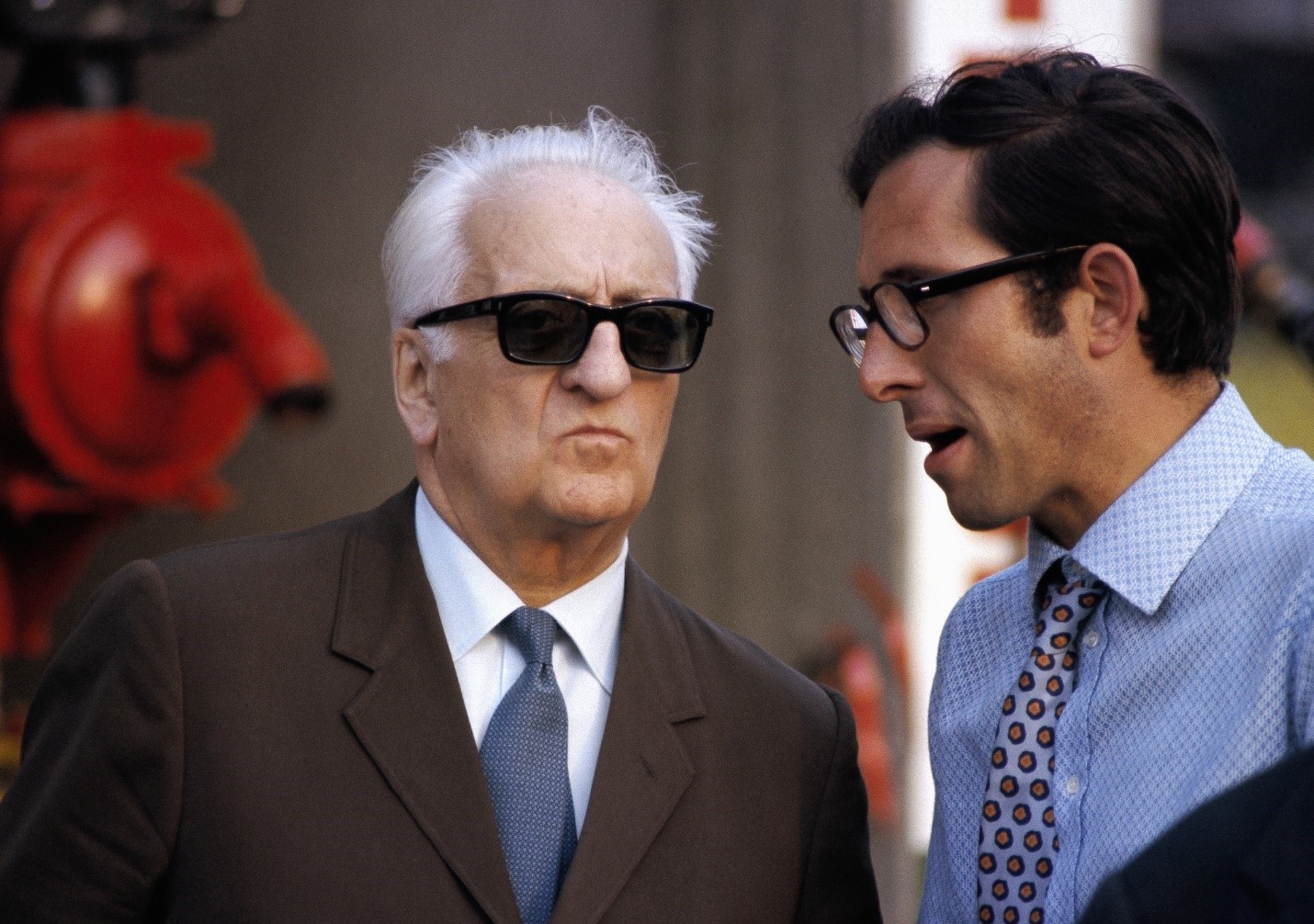
Enzo Ferrari and Mauro Forghieri, Monza 1970.
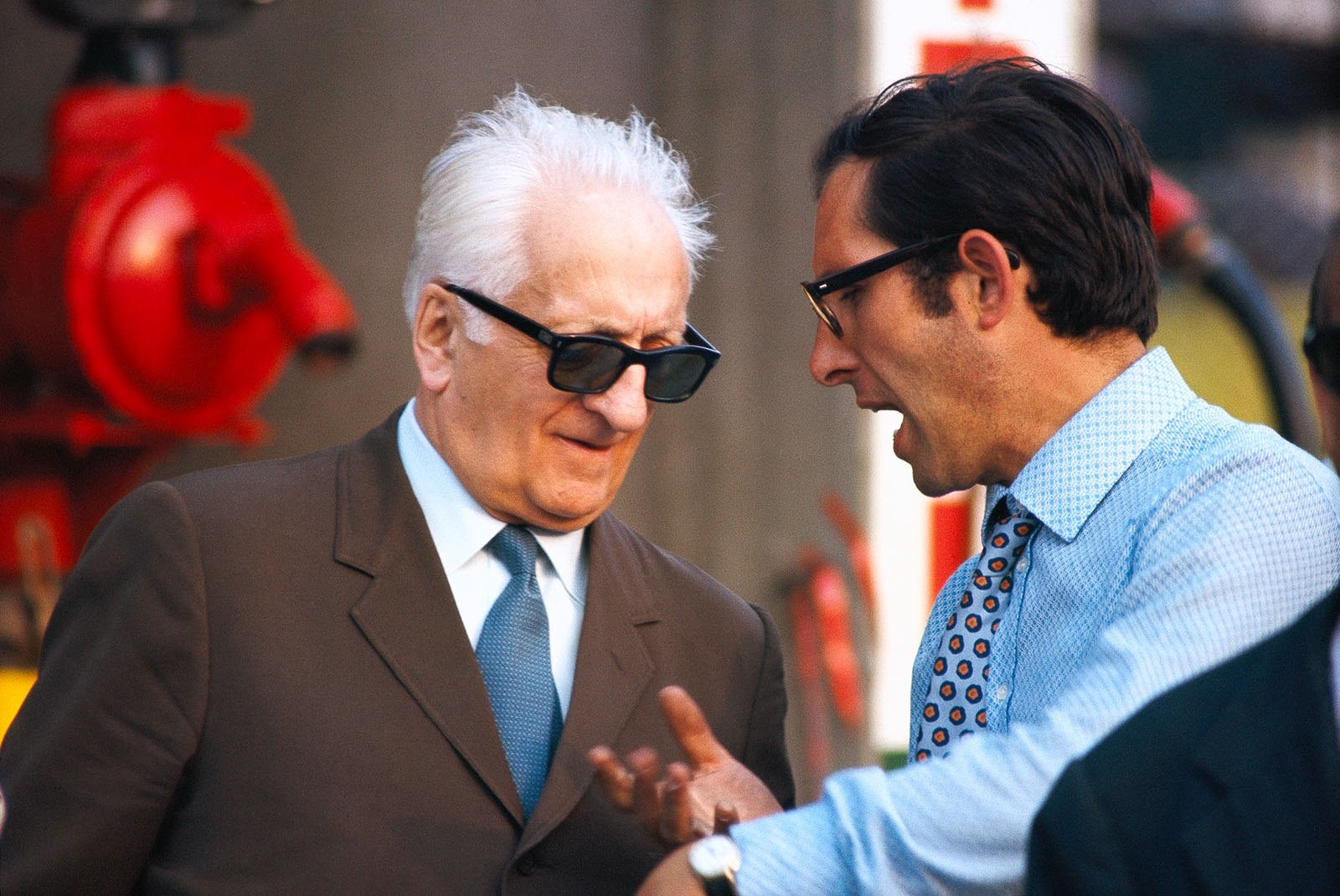
Enzo Ferrari and Mauro Forghieri, Monza 1970. Photo by Rainer Schlegelmilch.
But there's a problem. The supply is infinitely less than the demand, which is still inexhaustible and unsatisfied. Because Enzo Ferrari in his life has written or branded books with the dropper.
Indeed, in fact, practically only one or a little, very little, more. Gioie Terribili (terrible joys), Briglie del Successo (bridles of success), Ferrari 80, call it whatever you want in the respective version or edition, the title changes but the base, the frame or the matrix remains the same. From a well-leavened chapter Piloti che gente (drivers what a people) is born, but we are always there. Add to it the Flobert, a delightful divertissement written by him about journalists, - for once targets and no longer snipers - and we are already almost at the end of the race.
Of course, there are also interview books like the wonderful one by Enzo Biagi, which say so much and make Enzo Ferrari say, but the impression in the end remains that of having much, incredibly less from the Drake than we would have liked to have.
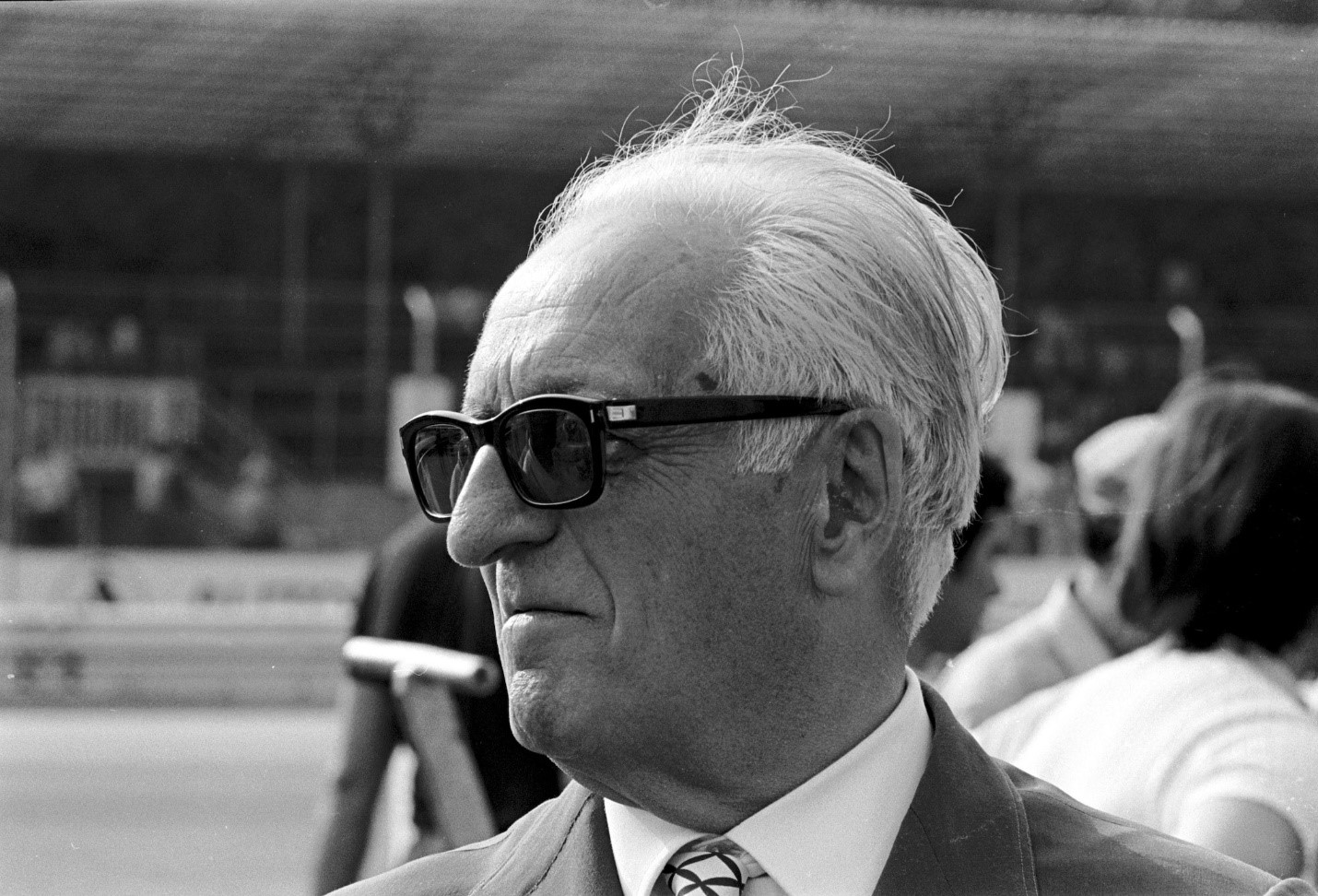
But there are his interviews. With a great prevalence of his one-against-all dialogic appearances, his favorites, up to the exceptions of "one to one", very rare pearls in which the Great Old Man accepts the exclusive two-way exchange, where the other half of the desk, almost invariably, sees the other half of the sky at work, that is the female interviewer on duty. Because, after all, if the car is female so it is as well the pure pleasure of conversation and cerebral confrontation, isn’t it?
But not for us, Enzo Ferrari is here again. Immortal, with his pauses and his restarts, his insightful, insinuating, sometimes mocking phrases, playful or capable of blandish, caress and strike as needed, in a masterful display of what Cicero called Ars opposendi et respondendi, the art to object and respond. In a word the dialectic. With the unmatched clangor of argumentative strength mixed with allure. In this case used as pure communication but also as an instrument of power and captatio benevolentiae as well as an outburst and ostentation of conscious charm.
Served and elegantly placed on the plate directly by the creator of the myth, capable of spreading with an equal and imperceptible smile, essences, poisons and drugs capable of making the experience of those who lend themselves to such administrations beautiful and worth living.
Make them yours, enjoy them well feeling privileged because the Drake's words resemble the Falcone Maltese, ideal sovereign of noir films: they are made up of the very material that dreams are made of.
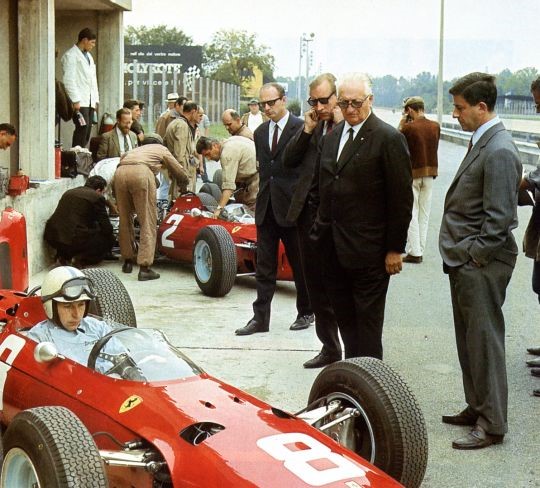
Enzo Ferrari, a legend that never ceases to fascinate. By Vincenzo Borgomeo. 10th August 2018.
Just 30 years ago, the founder of the most famous brand on the planet disappeared. History, anecdotes, curiosities and strategies that led to the birth of the myth.
Thirty years without the Drake, a still very strong presence in his Ferrari. A long life, full of professional satisfactions but also tormented by great pains and "terrible joys" as he himself wrote later.
And this is one of the craziest things, as Sergio Marchionne explained recently: "to think that Enzo Ferrari was born in the nineteenth century seems incredible. His lesson, said the FCA CEO, is more current than ever and his modernity is absolute. He was a man of extraordinary vision and management of people and resources as well as a source of exceptional entrepreneurial spirit and courage. We wonder what goals he could have achieved if he had had the technical means and knowledge of our days at his disposal. The mark he left on the world remains a source of pride for all of us at Ferrari and for the whole of Italy".
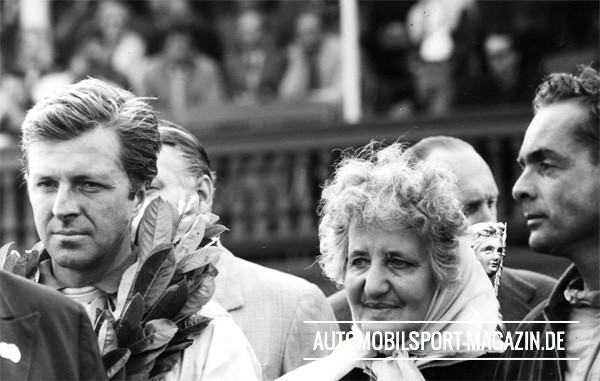
Laura Garello.
On 28 April 1923 he married Laura Garello. A sometimes difficult marriage from which, on January 19, 1932, the son Dino was born who died very young from a terrible and long illness. Ferrari was a destroyed man but he didn’t lose heart and continued with tenacity in the construction of the myth which arrived in great shape to the present day: Ferrari today is the most famous brand in the world, it debuted on the stock market as a star and it flows into legend where reality and fiction blend into one. A factory that produces dreams, not cars and which therefore makes it difficult, very difficult, to reconstruct how it could have come that far. How was it possible that a company in a poor country, torn apart by the war, became so famous by producing very expensive racing cars and GTs. Everything is obviously due to Enzo Ferrari. And partly to his manias. You know, geniuses are often full of manias. But the Drake was something apart in this too: he never took the elevator, plane or train, he never went on vacation, he never traveled and, in the last forty years of his life, he hasn't moved from his happy little islands of Modena and Maranello.
In reality, despite his planetary successes, Enzo Ferrari lived in total solitude. And his detachment from the rest of the world has contributed greatly to creating the image of the myth, of the unattainable man, of the manufacturer of invincible cars.
But in the search for the many whys of the Ferrari myth one fundamental aspect cannot be overlooked: Enzo Ferrari was a precursor of modern marketing laws when this discipline had not yet been invented ...
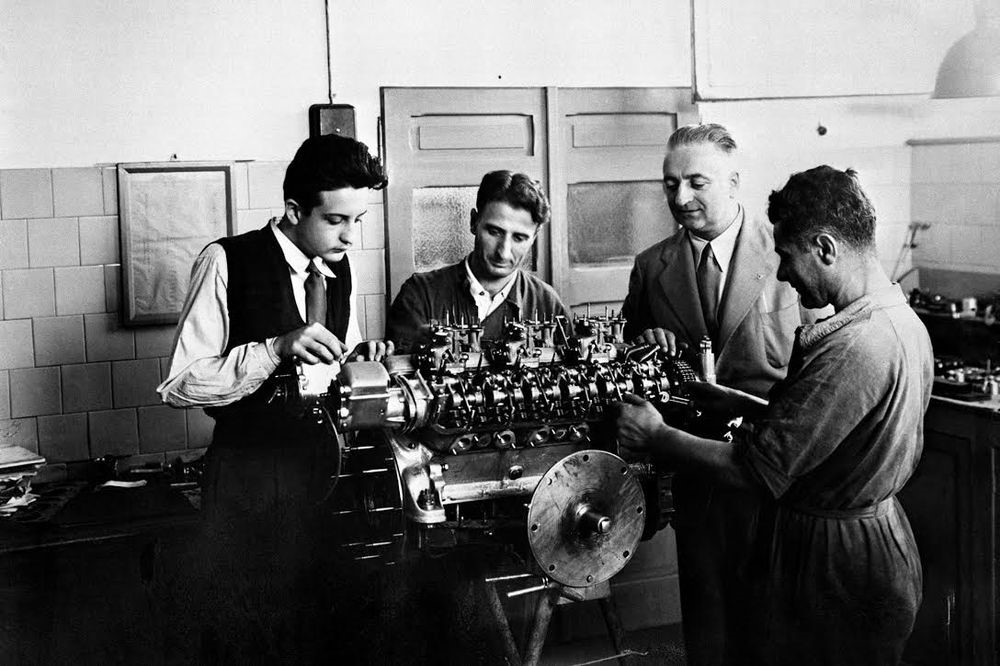
Enzo Ferrari with Colombo working with his team on a V12 engine in the late 1940s.
For example, when the Drake makes his first racing car he wants it with 12 cylinders. An absurd and useless complication which however, after the first victory of the famous 125 Sport at the Rome Grand Prix, opens the doors to success thanks to financing from banks and creditors. Twelve cylinders meant exclusivity, other technology, mechanical refinement.
Enzo Ferrari immediately takes advantage of the situation: the 125 is put up for sale. And whoever wants to race with that car can also have logistical support in the various competitions. Among other things, a unique case at the time, Ferrari also produces a small booklet to advertise the 125: eight yellow-colored pages entitled Manufacturing Program. Marketing, as we said, at that time did not yet exist but Ferrari already knew well all its secrets. On the cover and on the second page there were two huge prancing horses, the symbol of the team that he wanted to impose as a brand. And, speaking of the brand, the Ferrari font was also written in an unusual and absolutely personal way with white letters surrounded by a large black shadow. To differentiate meant to emerge. And to emerge meant to win. In other words, surviving in those difficult post-war years. This is why today we are proposing those brochures again, they are proof of how the Drake looked ahead, of how he had in mind the path to make Ferrari great.
The Drake was the first to work on the brand image, on the brand as we would say today. But he was also a true pioneer of sponsorships, managing, unique in the world at the time, to earn money from racing while all his competitors lost money to make cars race.
The Drake himself describes his strategy: "one of the first times I met Valletta, he asked me a curious question: "Ferrari, they tell me that you manage to do car racing and earn money while we, Fiat, are tired of the excessive expenses that it involves". I explained to him that the writings I had on the trucks of my team were of suppliers who subsidized my business. In those days they weren't called sponsors yet. And I added that from Shell, for example, I was getting 120.000 lire a month. Valletta was shocked».
Today in Formula 1 the sponsors are within everyone's reach but no team is able to organize and manage them with such skill. Alongside the classic sponsors, who sometimes also collaborate with the factory, Ferrari also has a group of very important suppliers, partners who collaborate directly to make Ferrari great. In short, a total of about fifty companies that literally "push" the Maranello firm.
It's been a long time since Shell gave Ferrari 120.000 lire a month and since Valletta was shocked by that exorbitant sum …
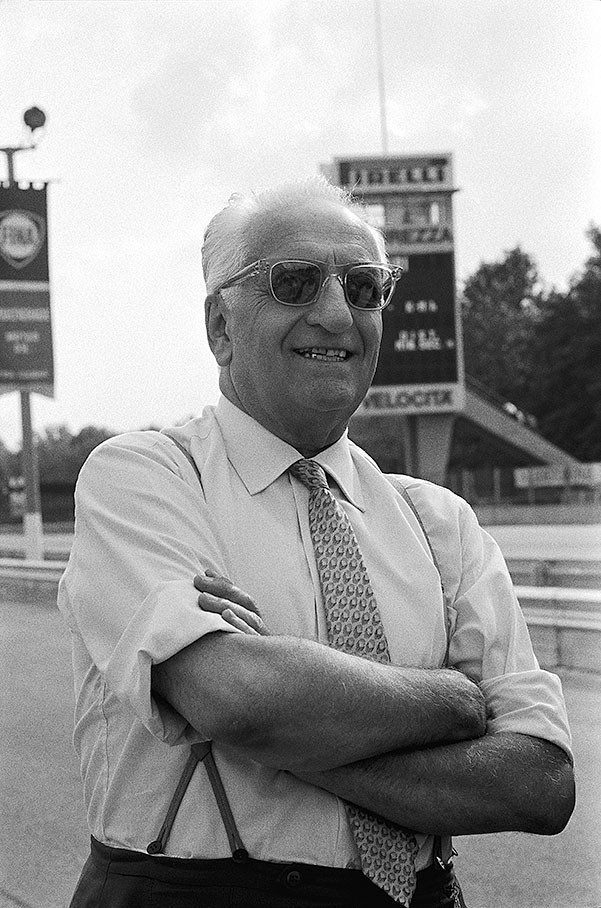
Enzo Ferrari at Monza in 1957. Photo by Rainer Schlegelmilch.
But let's go back to Ferrari's history as a driver and manufacturer: his first race dates back to 1919, when he made his debut as a driver at Parma-Berceto finishing fourth in the 3000 category and eleventh overall. For him the races were everything: personal satisfaction, a means to redeem himself, the desire to succeed. "I don't think I behaved really badly as a driver," he often said. And in fact he was right: for a rookie driver at that time winning nine out of 39 races was not a bad result.
When Ferrari started racing, in fact, motorsport was a profession for true daredevils: few means, a constant risk of being killed even in the most stupid accidents and already fierce competition. The second race that Ferrari took part in was the 1919 Targa Florio, again at the wheel of a CMN. The adventure immediately began badly: on the morning of departure he was stuck in the hotel elevator for almost two hours ruining his travel plans. The race did not go well: Ferrari reached the finish line when the public and especially the official timekeepers had left. Waiting for him there was only one Carabiniere who, with a big alarm clock, recorded the times and the order of arrival of the latecomers on a register: "ninth" was the response of the young Carabiniere in a uniform full of dust.
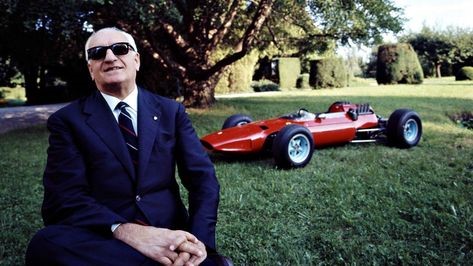
Enzo Ferrari would turn a hundred years old today. By Mario Fossati. February 19, 1998.
Ferrari had a special consideration for gregarious, for the humbles of human depth. He liked less the champions, the aces, after all, even of the steering wheel. "They expose themselves a lot." Ferrari was 84 years old.
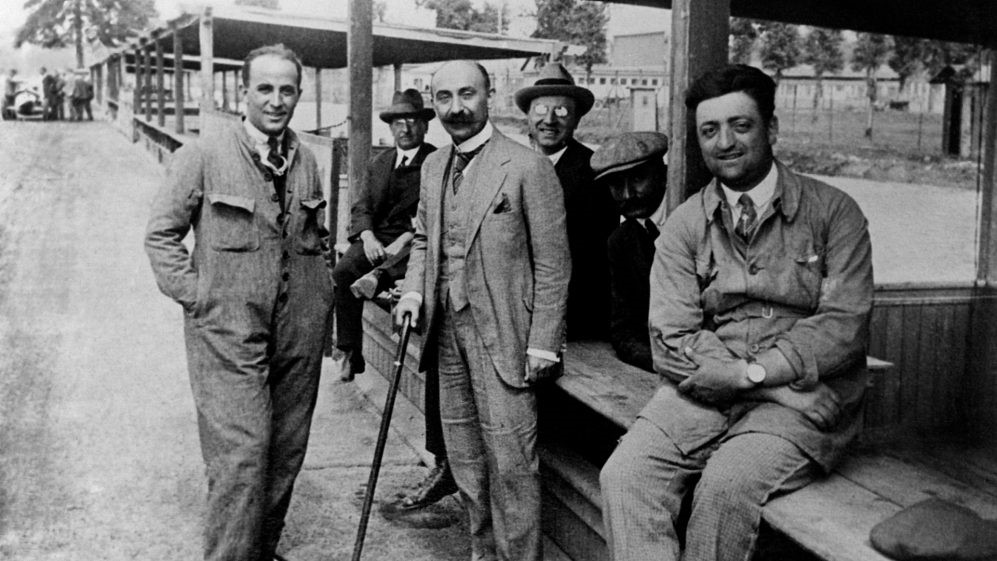
Enzo Ferrari (right) with Nicola Romeo (in the middle) and Giuseppe Morosi (left) at Monza in 1923.
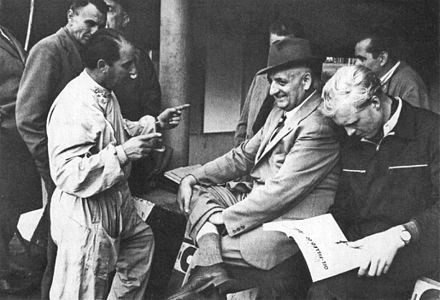
Enzo Ferrari and Mike Hawthorn at Monza in 1953.
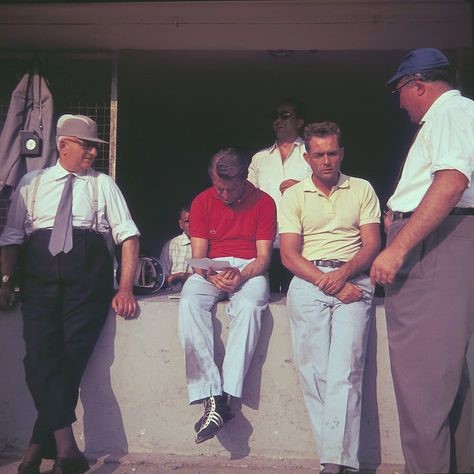
Enzo Ferrari, Wolfgang von Trips, Umberto Maglioli, Phil Hill and Carlo Chiti at the 1960 Italian GP in Monza.
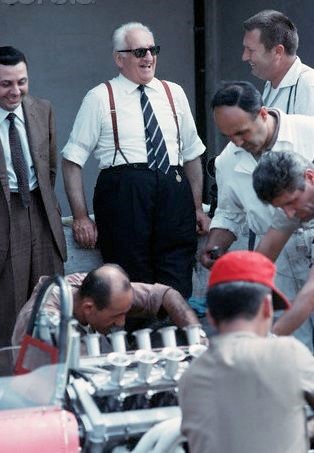
Enzo Ferrari at Monza in 1966.
He had managed to defeat the Alfas in England, at Monza, at the Nurburgring: he had interrupted the victorious trail of the Mercedes at Goodwood (I think). He had triumphed in the world championships. He was the most famous of all Italians: yet the most loved. The new factory. The pottery factories had asphyxiated his orchard. And he had built, here, a test track to train the drivers.
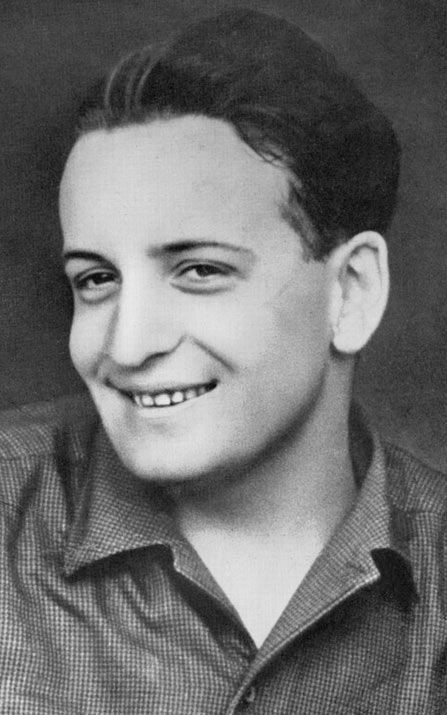
Dino Ferrari.
His son Dino and his wife had died. He had seen the disappearance of collaborators he had grown fond of, whom he sincerely loved, excruciating pains. His had a griffin profile, a Drake one. His age had softened his voice.
A little awkwardly, I asked him for a judgment that would add up the beloved Nuvolari and Varzi. "It belongs to Neubauer, the sports director of Mercedes. Nuvolari, a hero; Varzi, an artist, I would put Fangio close to Varzi". Ferrari criticized the absence from racing. "From Ascari to today, Brera interrupted him, the traditional shape of racing cars has remained engraved in me, the cars you drove too as a racer. Today's cars seem monstrous mole crickets to me." Ferrari replied that "aerodynamic requirements can contrast with visual satisfaction". And the participation of the driver, of the pilot as the protagonist? "Courage, however, is not lacking in drivers. Certainly. Courage, he pursed his lips a little, makes also vices positive: cowardice makes also virtues negative". The ending of the interview I have in the ear and in the eyes. Brera: "listen engineer, goodbye ..."
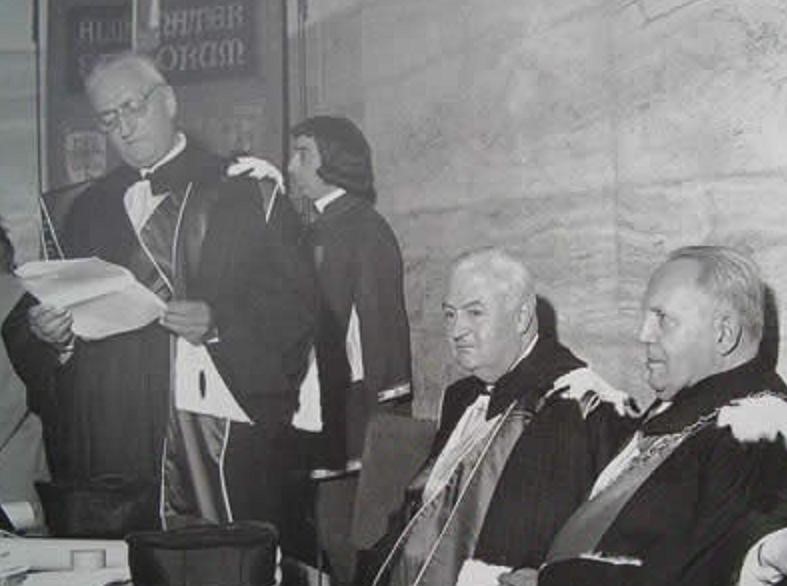
Enzo Ferrari on his graduation day in 1960.
Ferrari: "yes, engineer, do you know what came to my mind when I was given the honorary title? That Guglielmo Marconi had passed from there and I felt ashamed in my heart". Ferrari had won that day, 7 September 1982, 23 world titles, over 5.000 races in all categories of cars.
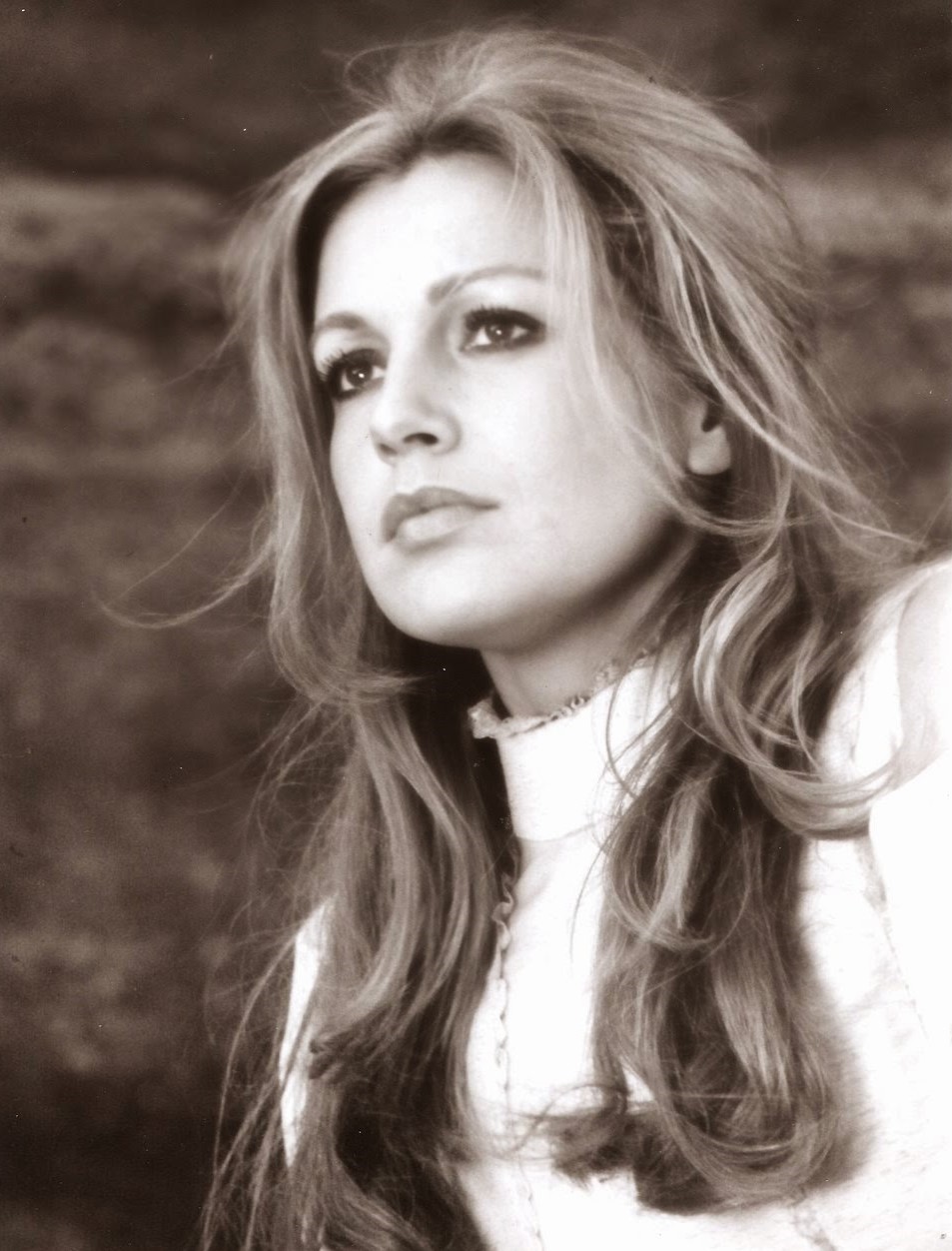
Catherine Spaak's interview with Enzo Ferrari for Autosprint on March 30, 1982.
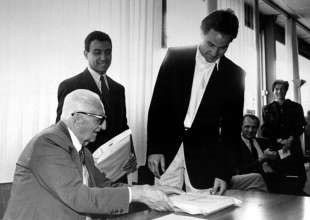
Enzo Ferrari, Gerhard Berger and Michele Alboreto.
"I have found men who, undoubtedly, loved cars like me. But, perhaps, I have not found others with my obstinacy, animated by this dominant passion in life that has taken away my time and the taste for many others things. I have never done a real tourist trip, I have never gone on vacation in my life, for me the most beautiful holidays are the ones I spend in the workshop ...“
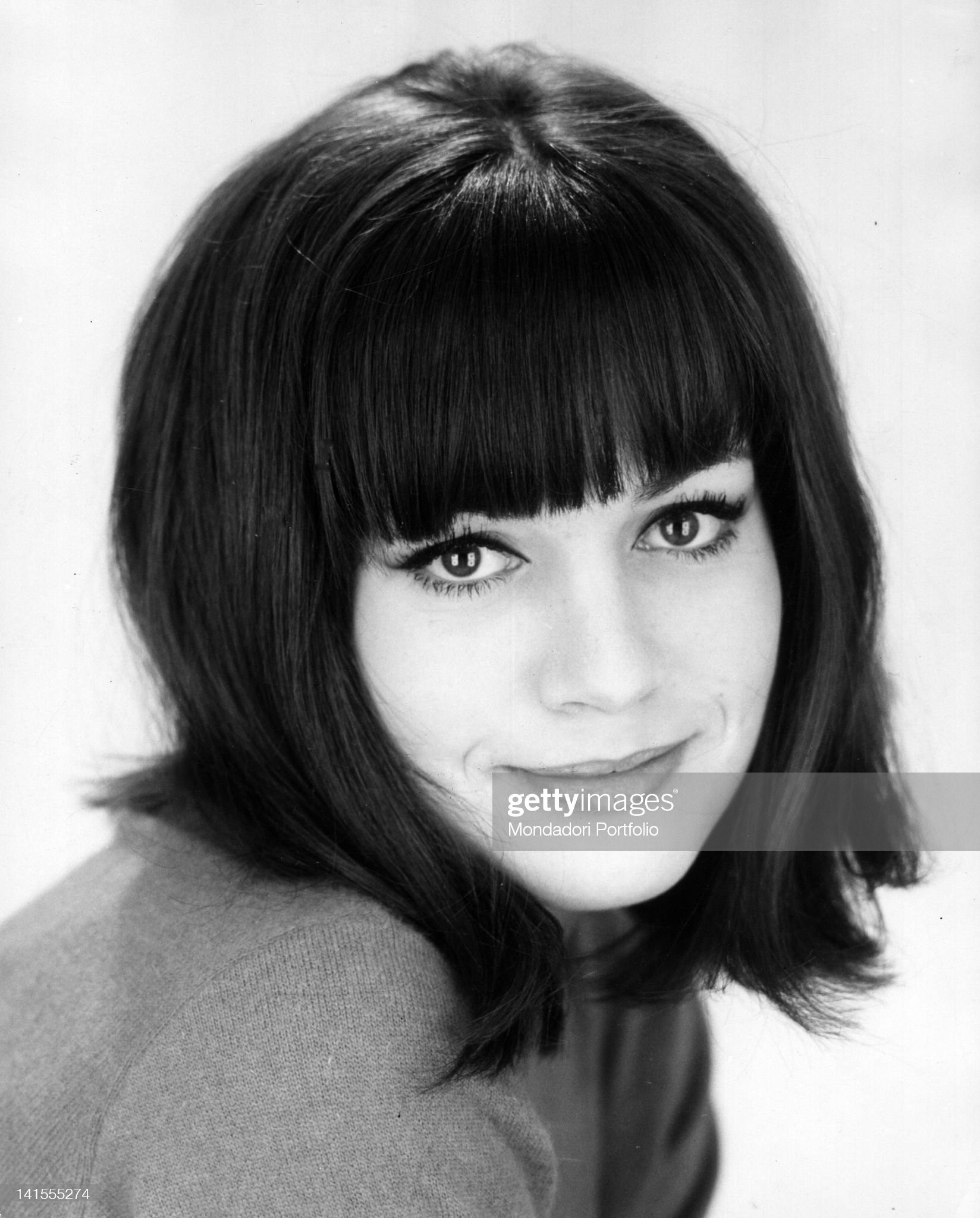
Portrait of French actress, singer, dancer and TV presenter Catherine Spaak in 1967. Photo by Mondadori via Getty Images.
I also believe that a stubborn will, a deaf, determined, constant ambition is enough for man to overcome all the obstacles he encounters along the path of his life. The focal point, however, is "for what purpose". To Fiorano, to Maranello I did not go excited by the celebrated symbols of power, reverent and obsequious in front of the mythical prancing horse, nor in search of emotions at three hundred kilometers an hour. I wanted to meet a man, not his legend. Wary, suspicious, he watched me impassively behind thick dark lenses. I understood why Ferrari is intimidating, the art of cornering others is not made of words but of silences and looks. Anyway, he took off his glasses halfway through breakfast. It may seem strange but we talked about philosophy, eating an excellent soufle. More than he did, it seems, could not be done in this half century. Tomorrow the world of automotive research and technology will go on anyway, perhaps less quickly, with less love, but everything will continue to change. The emperor, the tsar, the king of F1 is however alone, perhaps as the humblest of his workers, it seems like a fairy tale for wise and slightly sleepy children, yet it is not. Sometimes the biggest is also the smallest. It depends on the angle and on the eyes that look.
"The only prayer I know is this: ‘God, make me good’."
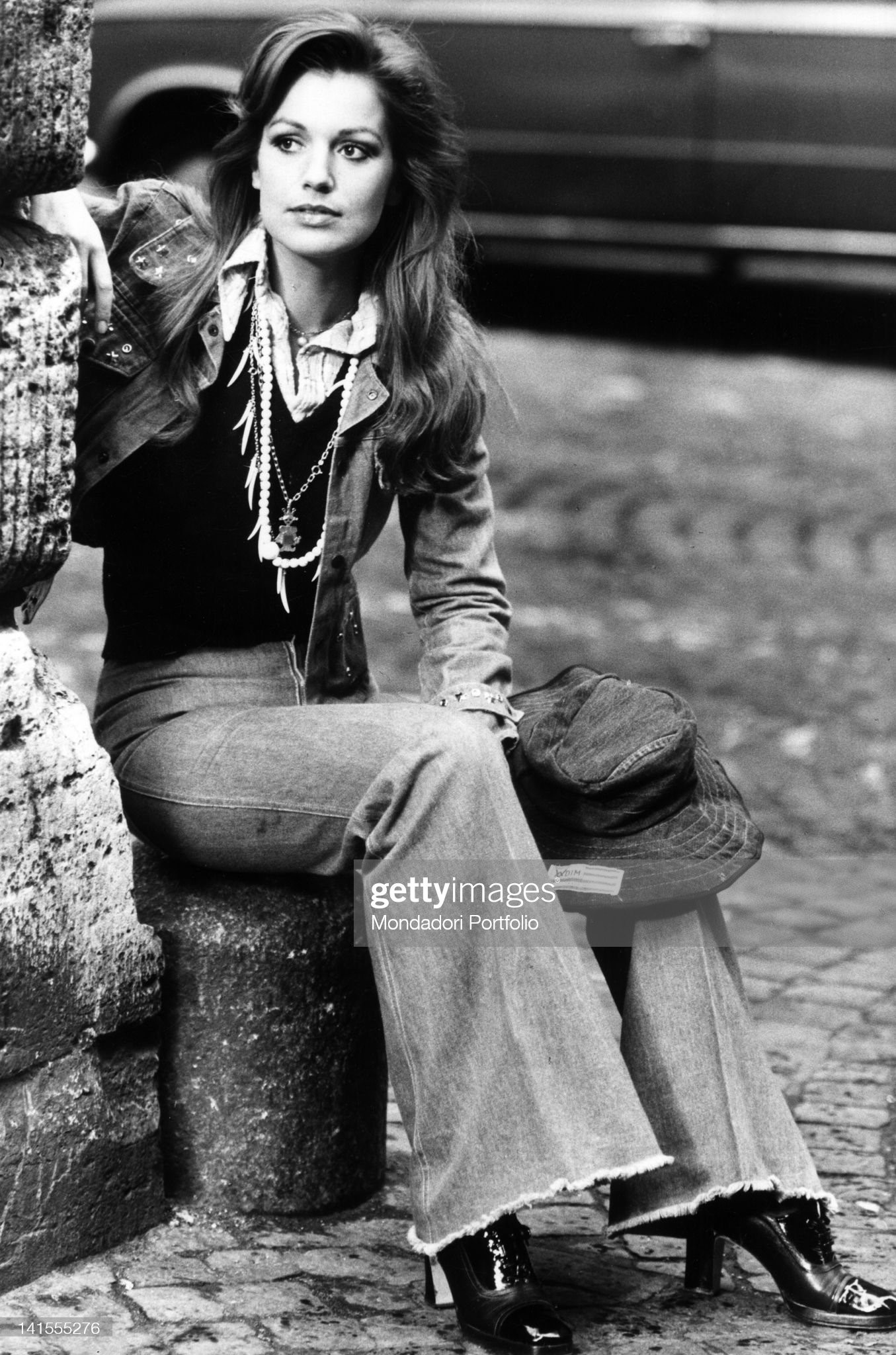
Catherine Spaak sitting in a corner of a street in Rome in 1970s. Photo by Rino Petrosino/Mondadori via Getty Images.
Maybe Mr. Ferrari is bad? I would say no. No more, no less than the others. And, perhaps, impractical in spiritual matters. He says, as if to reassure himself for fear of having a doubt: "even thinking about certain groans, arguing that a man enslaves a woman and considers her a simple object seems excessive to me". Perhaps that a woman's pleasure (real or simulated) is the pivot of giving and having or being. But why be surprised if Ferrari is ready to say that, if there is a soul, it is more likely that an engine has it rather than a human being.
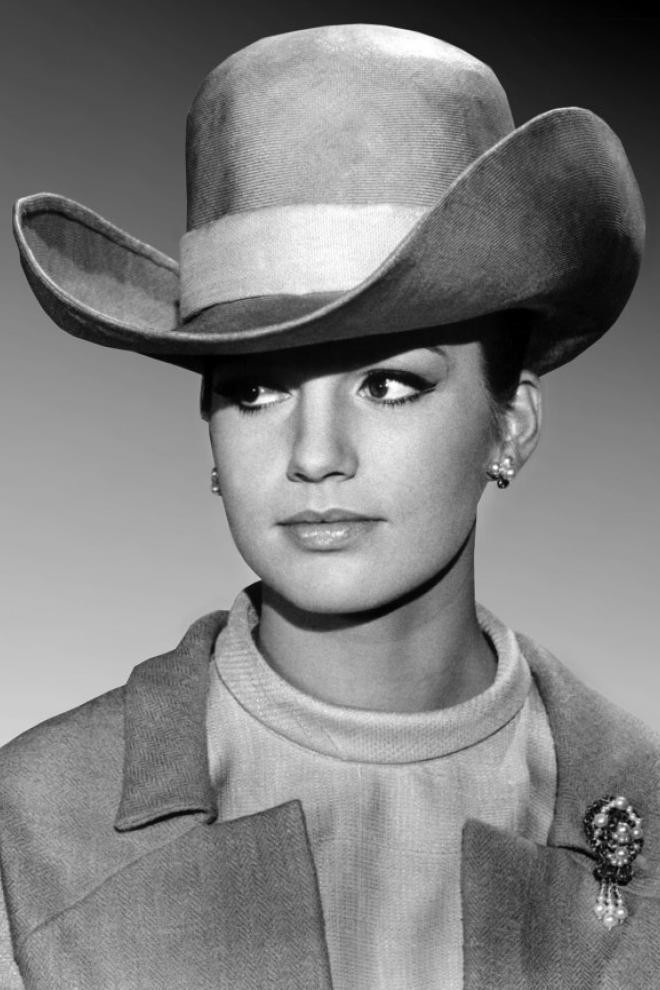
So you, engineer, do you only believe in the body, in matter?
"And what else should there be?"
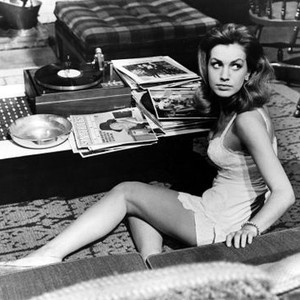
Are you just a digestive tract, meters of intestine, water and a pile of bones?
"There is the thought, my dear, a large computer made up of countless cellules ...".
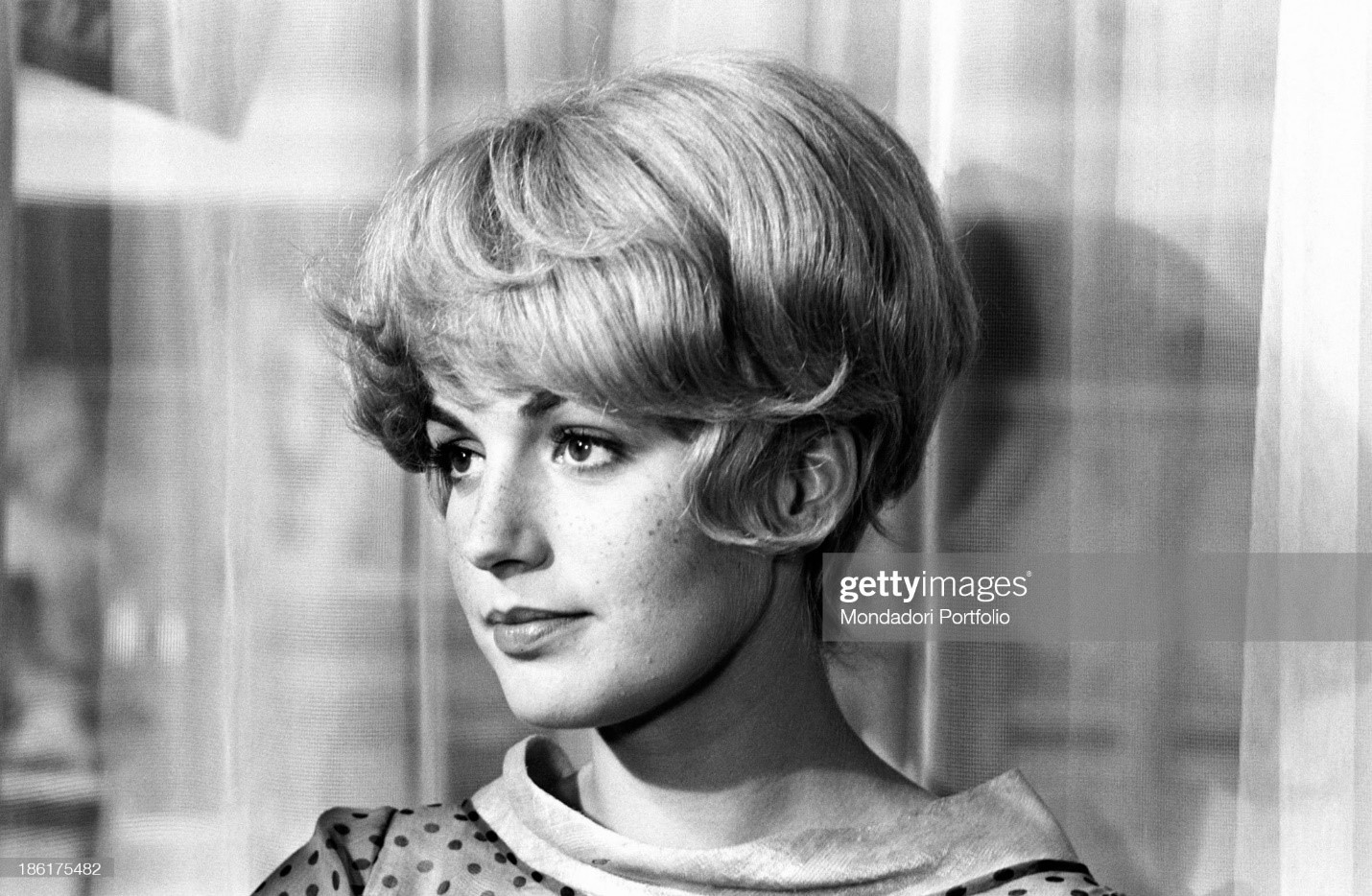
Portrait of French-born Italian actress Catherine Spaak in Rome in 1966. Photo by Marisa Rastellini/Mondadori via Getty Images.
And what is it, engineer, that never changes, beyond the body and mind? Ferrari looks at me amazed, as he has seen many “actors” pass in Fiorano. You see Mr. Ferrari, the problem, in my opinion, is all in the identification, we end up becoming what we believe we are. You have identified yourself with a wonderful engine and curious consequences derive from it, so various ideas and feelings are mixed and we make confusion with pride, possession, competition, patriotic sense, courage, morality, politics and progress. There are some slightly excited people who address you in these terms: the Ferrari puts your competitors in fear, restlessness, inspires respect, reverence; you, Ferrari, have created a desire in us who have inferior cars, an aim worth fighting for one day owning the "non plus ultra" car! You have launched a challenge: it is a Ferrari, are you worthy to drive it?
«We listen carefully to the sound of the engine and ask ourselves: is this an engine that cries in protest. No: this is the sound of an engine that screams with joy, a sound that no orchestra can play, a symphony of sounds that brings joy to the mind and the smile on the face".
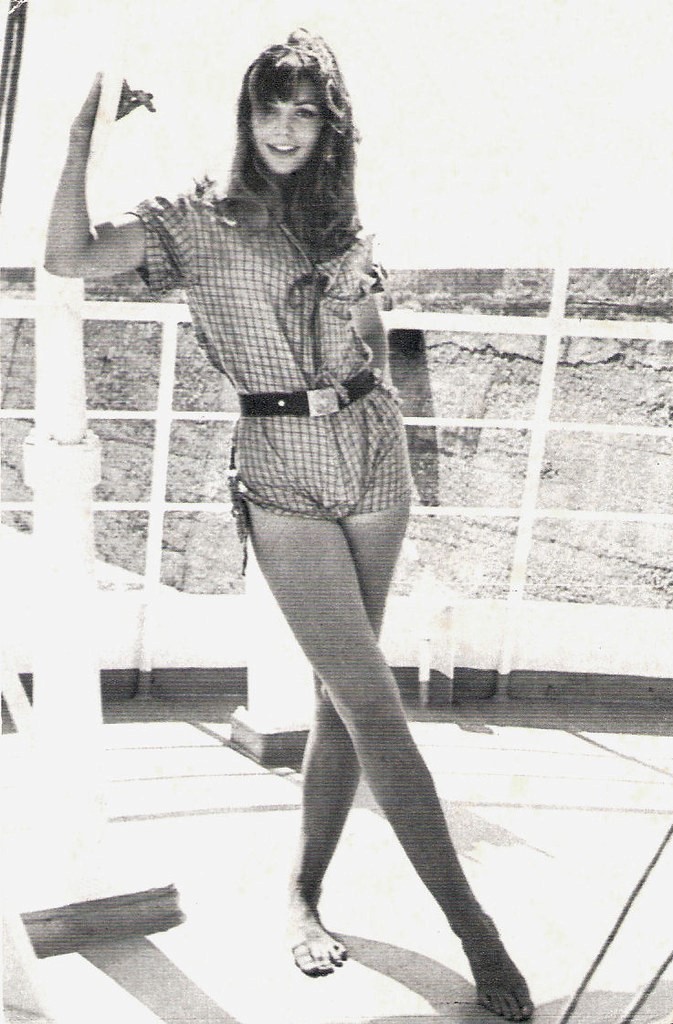
To me, all this seems dangerous: can a Ferrari really represent a man's ideal of happiness? The joy of the mind? And isn't it grotesque that, as happened in California, a billionaire gets buried behind the wheel of her Ferrari convertible, walled up together for eternity in a concrete block? Progress is necessary, Ferrari's commitment is noble, his contribution, his dedication and his tenacity are admirable.
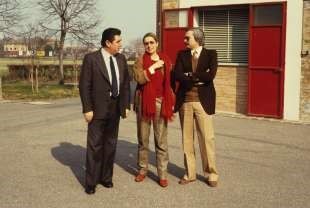
Catherine Spaak at Fiorano.
However, Mr. Ferrari who says that he has betrayed women, never engines, softens me because, in my opinion, he has not realized that, perhaps, the only person who he has really betrayed is himself. Who knows that true progress, the one that really changes something for the good of humanity, should be sought inside man rather than outside. The most beautiful symphony for men is not that of the revs of an engine, it should reside in the silence of an eighty-four years old heart that has found peace, serenity and that knows that it is never and never will be, neither alone nor guilty.
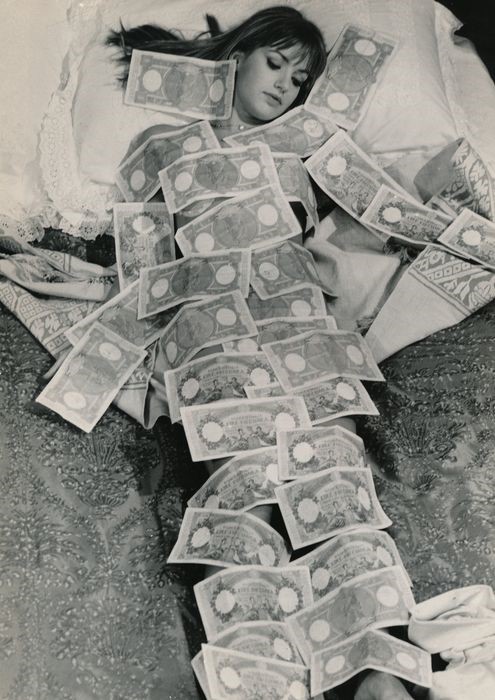
Your name is famous all over the world, your brand looks like a legend. How is all this built?
"By working immensely and considering work a lifeline in the midst of so much disorder".
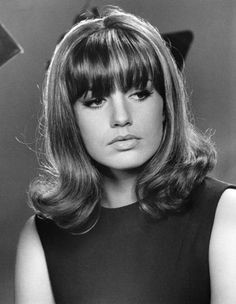
What does the Ferrari-Fiat alliance consist of?
"The Fiat-Ferrari agreement was born on June 18, 1969 and was defined to ensure development and continuity for my artisan company, while, at the same time, guaranteeing me the right to continue to be interested in problems related to sport and the progress of motoring".
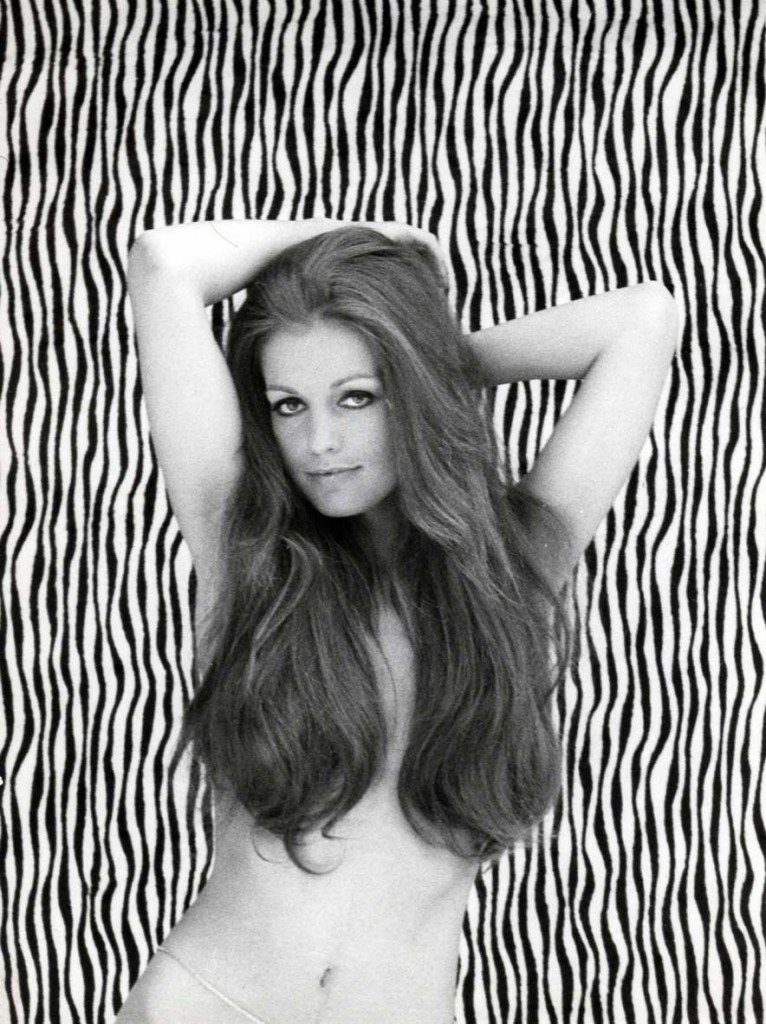
Is it true that Ferrari management expenses for F1 are estimated at over 9 billion this year?
"In my press conference, at the end of the year, I had the opportunity to point out that the deficit of the Sports Management for the year 1981 was 5,805 million lire (of which 500 million lire paid by Fiat). This figure, for 1982, will obviously suffer the increase imposed by the devaluation”.
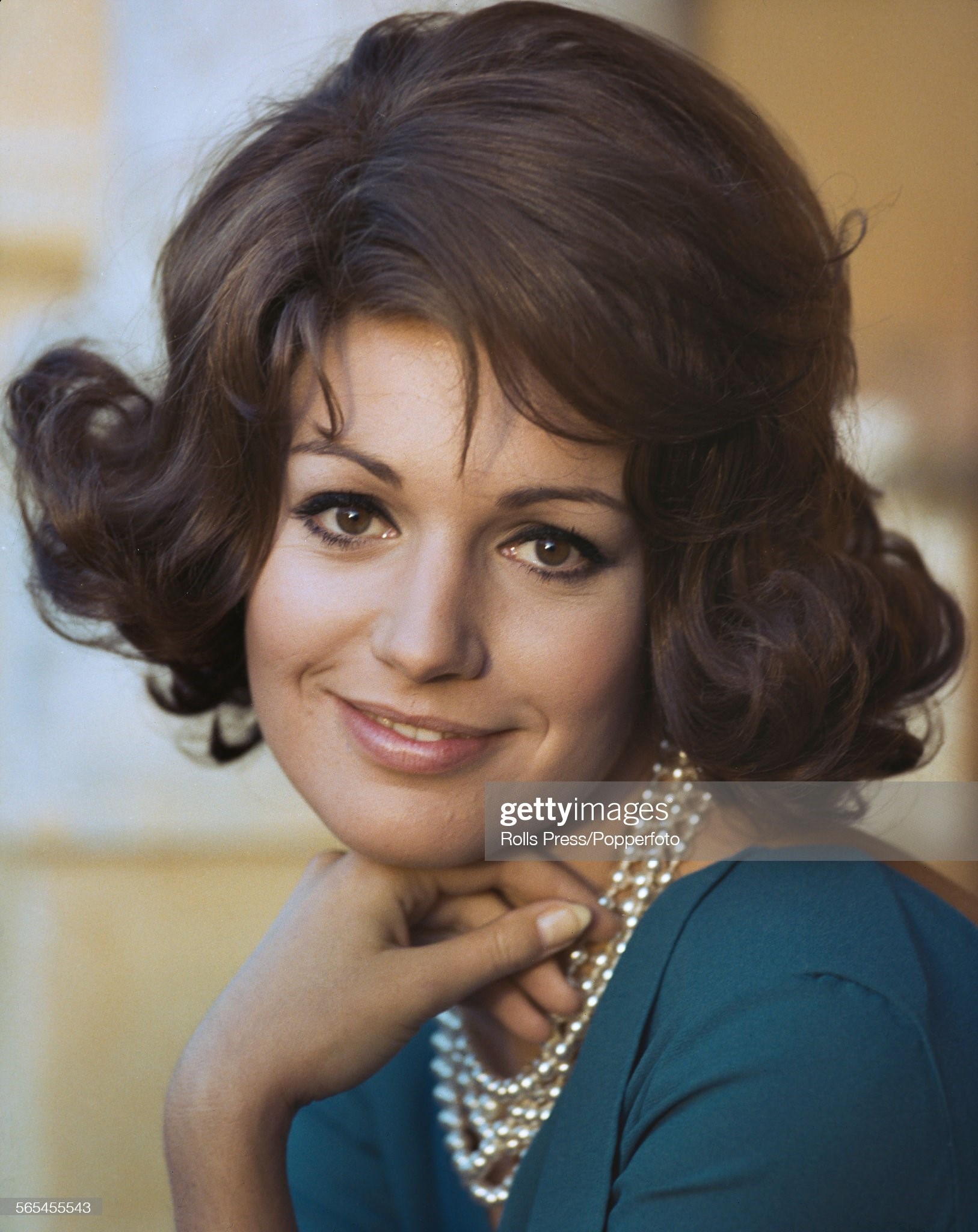
Catherine Spaak, who appears in the film 'Hotel', posed wearing a blue dress and pearl necklace circa 1967. Photo by Rolls Press/Popperfoto via Getty Images/Getty Images.
You said that "Sport with a capital S was killed by sponsorship, by wild commercial speculation". Why are your cars covered with Olivetti, Goodyear, Agip, Longines, etc. stickers? Is yours a surrender?
"I have always maintained that the only admissible publicity is that of those who contribute to the technical evolution of the racing car. The manufacturers you mentioned have nothing to do with the myriad of consumer and luxury products that have invaded the environment to the point of personalizing the cars: they are technical sponsorships and may, indeed have the right, to appear".
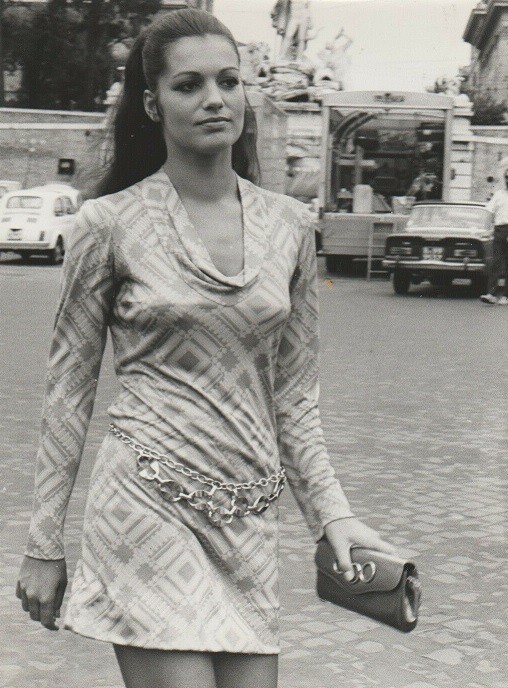
Is it true that Cartier bought your brand (the prancing horse) for a watch?
"Ferrari has not sold its brand, but an agreement is in the process of being finalized with Cartier so that this brand can take advantage of the prancing horse on several of its products that will annually be submitted to Ferrari for approval. With this, Ferrari has intended to defend its brand on a market invaded by many profiteers, trusting that Cartier will know how to properly defend the concession”.
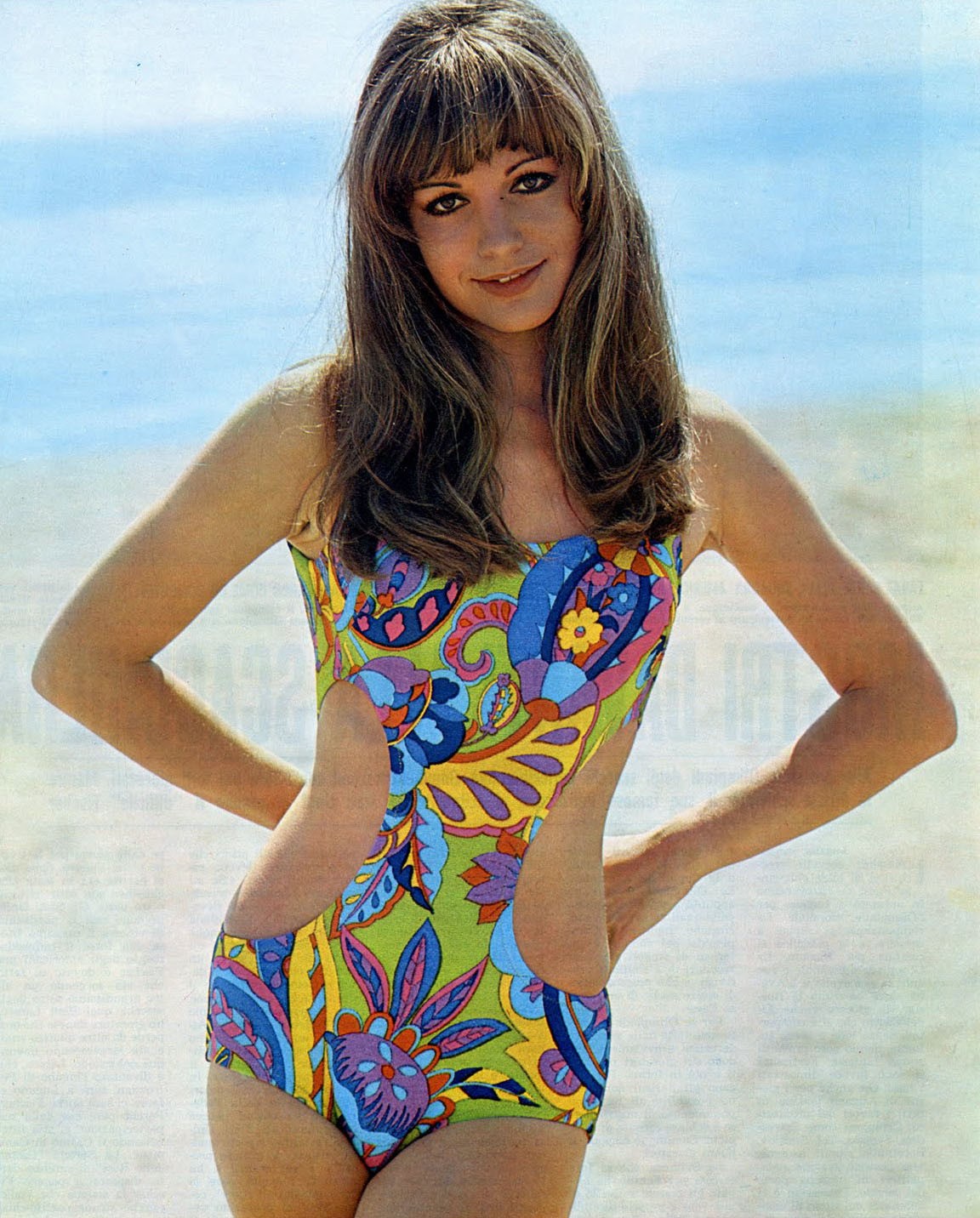
Catherine Spaak in 1968.
How do you think the "war" between aspirated and turbo engines will end?
"The current F1 has been in existence for fifteen years and the manufacturers have only been trying to fully explore this formula for two years before it ends its cycle in 1984. This pre-emptive war against turbo, which has not yet won any world championship, is conducted by those who tend to transform the Formula One Grands Prix into a spectacular motor racing bullfight, in which sport and technology become disturbing intruders”.
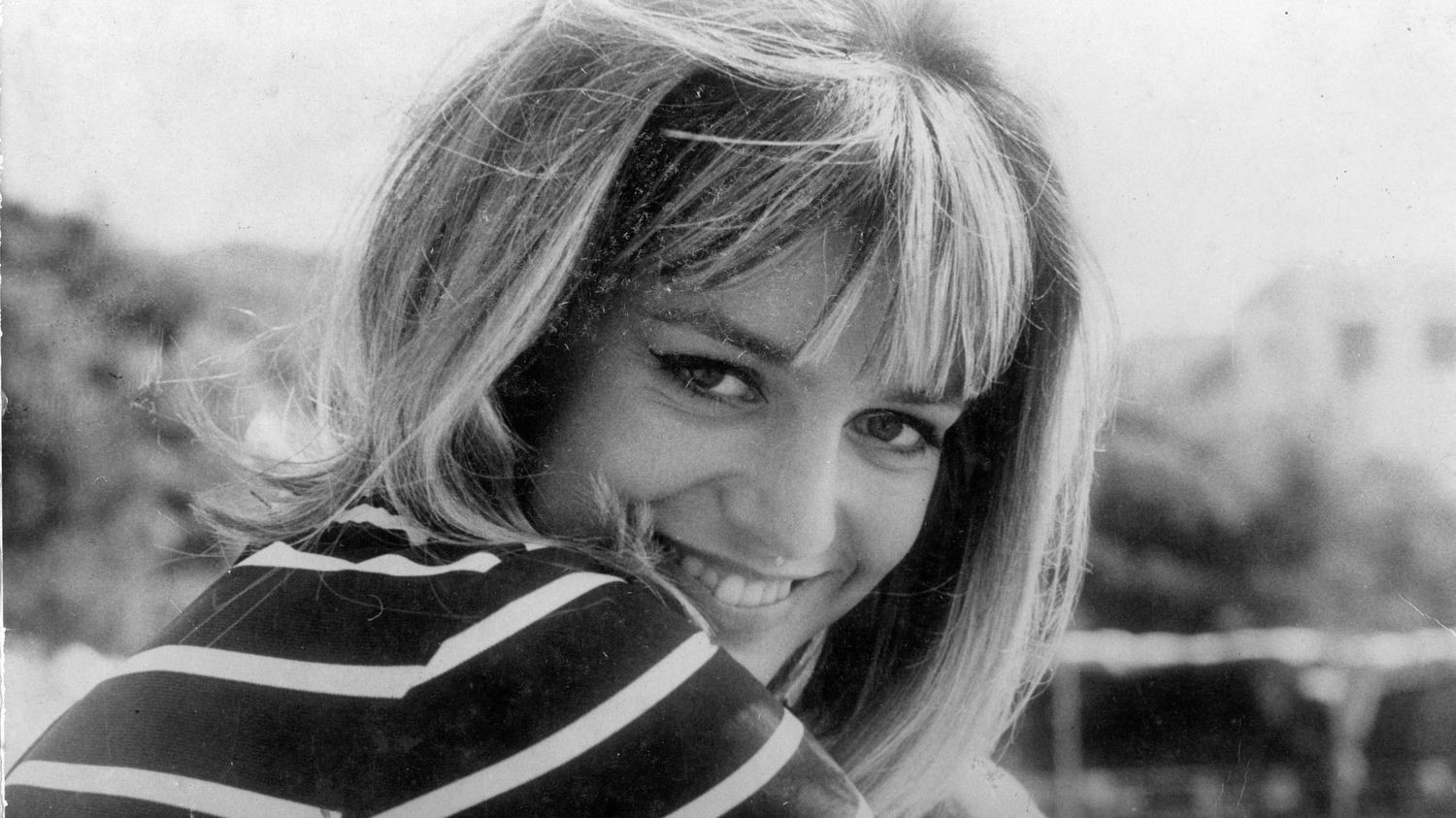
Catherine-Spaak, muse of the Italian post-war.
Who, in your opinion, should lead this business without fixed rules and which seems to be expanding day by day?
"It's true: the turnover is expanding more and more with the push of the drivers who exercise and plan the marketing of their image rights, while many teams that derive nourishment and income from this activity do not intend to spend on technological progress. However, there are fixed rules: there are regulations, there is the Sporting Code and everything is preordained so that everything returns to normal. The only thing missing is the presence of a strong sports-legislative authority that demands respect for it”.

French-Italian actress Catherine Spaak in the 1970s.
If the starting weight rule for racing cars is ambiguous, why not change it?
“The rule is not ambiguous. A distorted interpretation is allowed which, casually operated by various teams, results in an open violation of the spirit of the law. With the same "good faith" one could claim impunity for those who kill a woman, only because the code punishes homicide and does not speak of "femicide"".
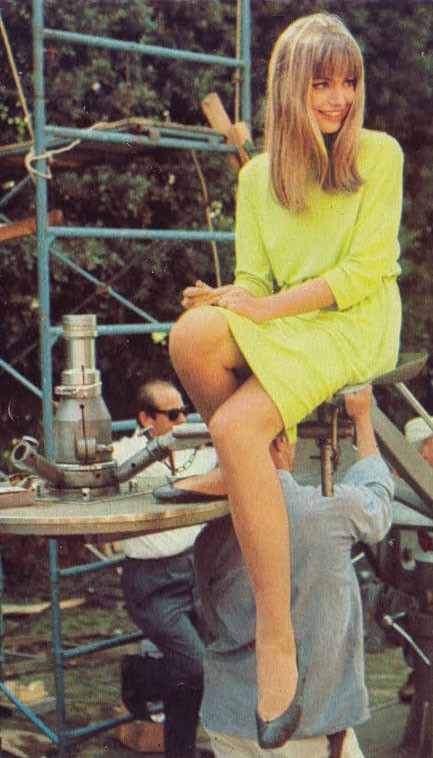
Catherine Spaak in the 1963 movie “La noia”.
Why is it not possible to establish a fairer equivalence formula to balance the displacement Cmc between the various engines?
"I do not believe, in the current state of technical research, that it can be established that the current equivalence formula is unfair. Who can tell?"
Would it harm you (the aforementioned more correct formula) or are turbo engines the best?
“I have already said that our technical research is aimed at progress. The turbo engines are an innovation that is now found on the majority of current Diesel engines already entered in the cars of common use and this means progress, since this technical path offers the possibility of obtaining less polluting engines with greater availability of power for the same consumption."
What complaints are for, if rules to be respected are not established before departure?
"Complaints should serve to get the real reasons recognized. Unfortunately, I am convinced that today, in our environment, expecting that you are recognized as being right is equivalent to exposing one's own impotence”.
If it is true that the man-car ratio in the race is divided as follows: chassis 33 per cent, engine 33 per cent, tires 20 per cent; is a driver who contributes 14 percent really worth billions? Why?
"I have always maintained that in automobile sport, with rare occasional exceptions, successes do not escape the law of pure sharecropping: fifty percent of the merit to the driver and fifty percent to the car. What a driver earns today cannot be foreseen by any trade union platform but, I repeat, the transfer of your image rights is an operation which is the sole responsibility of the interested party".
Are experimentation and research for F1 really needed in series production or is there a different motivation behind all this? Which?
"The car was born and progressed with racing. The competition is the necessary endorsement of any technical invention, since only the driver can find himself in a state of necessity that leads him to a sum of unthinkable, unpredictable, abnormal maneuvers and, therefore, only the race with its exasperated sequences can generate absolute judgments".
Niki Lauda said:"today, racing, in the corners the acceleration of gravity reaches 3 G. Your body weighs three times as much, like in a dive plane. The eyes are injected with blood, they come out of their sockets, the head tilts and you no longer see anything”.Doesn't all this seem monstrous to you? And for what purpose, then?
"Niki Lauda made a statement that was also confirmed in the recent Brazilian Grand Prix. We have all been able to see it. The president of FISA Balestre was right when he decided to abolish the infamous side skirts, which allow excessive speed when cornering. The trouble is that he then did not have the strength to enforce the provision in the face of the aversion of the English teams. All this is irrational and entails moral responsibilities for those who have circumvented an extremely valid and wise technical provision".
In your opinion, is the violence of F1 racing, which can even lead to "live" death, a spectacle? Have we gone back to the times of the Christians devoured by lions?
"There was an Honorable Member who declared that F1 races are an expression of violence, but I hope you don't agree with this assumption. I have already told you about the goals of progress that are the basis of the competition: alongside this technical content there is also a spectacular aspect in the competition that is able to offer the public the sum of emotions that summarizes that anxiety to overcome inherent in the essence and taste of human life".
How do you feel when a driver dies?
"Beyond sentimental values, I could say affective, I believe it is my imperative to try to know if the accident was caused by technical reasons. I deeply feel the responsibility that I take when I entrust my car to a driver and I consider it safe, within the limits of human perfectibility”.
There is war between you, Ecclestone and Jean-Marie Balestre. What do you think of the assault methods?
“I'm not at war with anyone. I respect the rules established by FISA, leaving no stone unturned for everyone to respect them. This has led to disagreements and conflicts, it is obvious, as well as it is obvious that everyone transfers the education he has received into everyday life".
What could Lauda do for Ferrari that he didn't do? Have you ever felt responsible for the Nurburgring accident that risked costing him his life?
«How can I imagine the availability of a human being towards his relations with a manufacturer that has revealed him? Let it be clear, however, that there is no unfinished business between Ferrari and Lauda».
Why are so few women able to make it to F1?
«Perhaps because Formula One suits men more than women. The exceptions that I remember, in fact, are few: Maria Antonietta Avanzo, Elisabetta Junek, Maria Teresa De Filippis, Lella Lombardi».
You said: “the car has always given me a great sense of freedom”. Engineer Ferrari, what is freedom for you? And what is courage?
"I have read that our freedom ends where that of others begins and that courage is the identification of the exact boundary that separates them".
You have lived of engines for more than 50 years, aren't you tired? Have you ever had other interests, other passions?
"Yes, actually I have been interested in engines and cars for 63 years and I attribute to this passion the merit of having offered me a purpose in life among so many cruel torments".
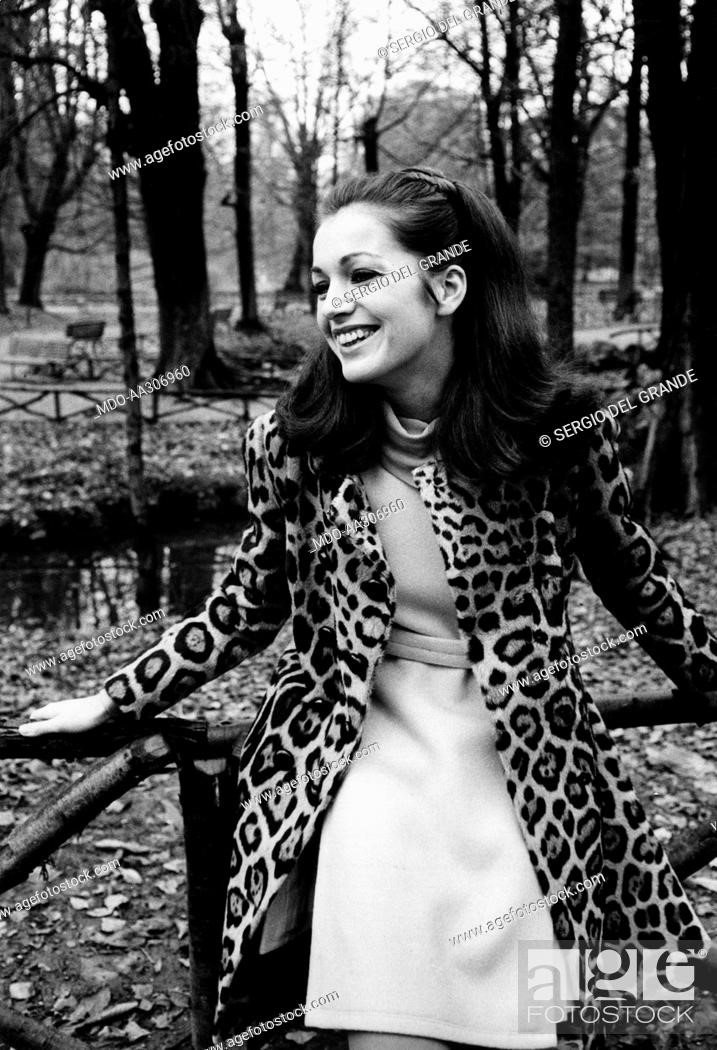
What has disappointed you the most in your entire life?
"The powerlessness to defend the life of a child who has been taken from me, day after day, for twenty-four years".
Is it stronger who commands or who knows how to obey?
«Whoever really commands doesn’t need to be strong, since his abilities give him prestige and consent. On the contrary, knowing how to obey means constantly increasing one's own strength, learning, collaborating and many other things”.
What do you mean to win?
"Winning does not only mean the applause of the crowd but, above all, the recognition of the synthesis of everything we have been able to do and foresee".
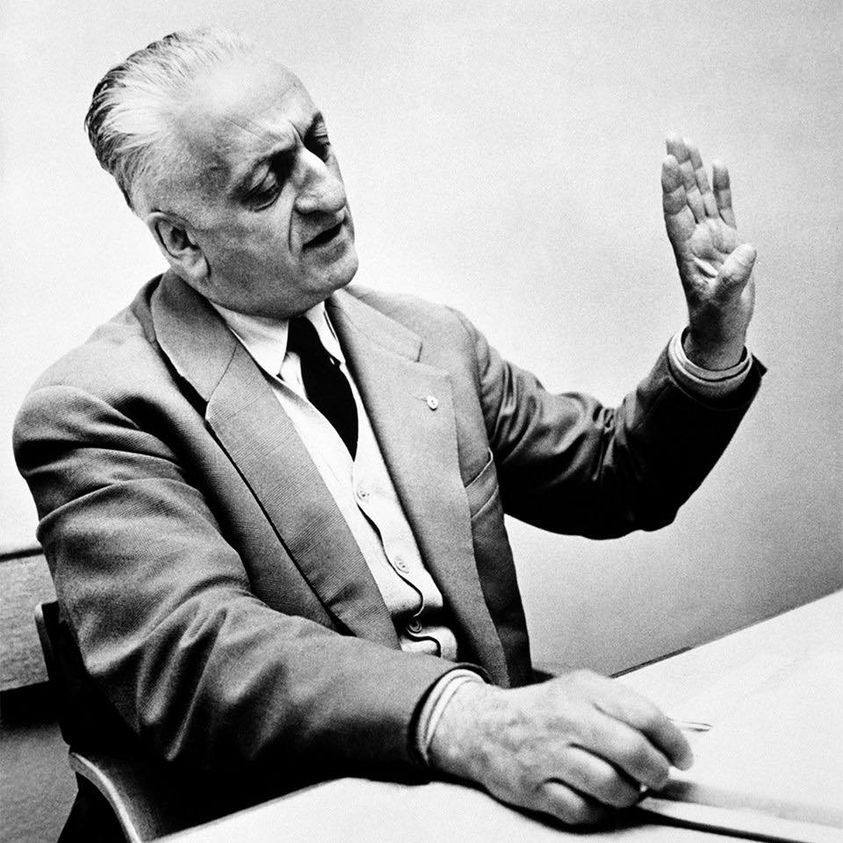
"But how dare you? Mr. Berlusconi, I do not allow myself to judge the crap you are broadcasting, so please respect my work, which in the world is much better known and appreciated than yours. You think about your own business and not mine, please. Take care of your cinema, your TV shows and leave me alone. I am an industrialist, you do your things and I hope you can do them well, but forget about Ferrari, its cars and, above all, me. These are matters that do not concern you and of which you don’t understand nothing. Have I been clear? I've finished ..." In 1980 Enzo Ferrari learns that Silvio Berlusconi has heavily criticized the sporting results of the Prancing Horse and chooses to call him. But he doesn't even let him talk. Too much anger. To Enzo they could really touch everything. All. But not Ferrari. Ofelè fa el to mesté! (Pastry chef, do your job!), an old Milanese saying goes. It is still widely used in Lombardy and it aims at who improvises himself as an expert and tries to do what he is unable to do.
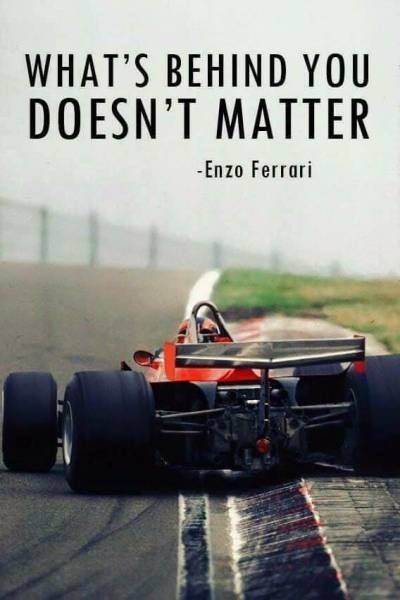
“Passion allows you to endure bitternesses and renunciations that ambition would not justify in any way." Enzo Ferrari
“I tried to become a great racing driver and I wasn't.” Enzo Ferrari
“As a boy I have always loved cars and I have always said that one day I will get to make my own car too.” Enzo Ferrari
“I love the car, I don’t mistreat it, I respect it.” Enzo Ferrari
“I didn’t have the opportunity to study, I stopped at what was once the third technique which today is equivalent to the eighth grade, but in life I have always surrounded myself with very cultured, capable people and above all pervaded by desire to be successful.” Enzo Ferrari
“I find it harder to write a page in correct Italian than to conceive how a winning engine should be.” Enzo Ferrari
"My father said to me: be careful. The assholes are expensive at all prices! So I tried to get along with someone who wasn't an asshole." Enzo Ferrari
“I decided to become a manufacturer simply because I was fired from Alfa Romeo.” Enzo Ferrari
“I have never had the mentality of the industrialist but that of the manufacturer which is totally different.” Enzo Ferrari
“I went back to the first impression I had in 1919 of an American car that had raced in Indianapolis and that was the 12-cylinder Packard. I have since married the 12-cylinder engine and have never been divorced.” Enzo Ferrari
“Herbert von Karajan one day told me and wrote me: "listening to your 12-cylinder you can perceive a harmony that no master will ever be able to interpret".” Enzo Ferrari
“Enzo Ferrari was convinced that the engine was good if it was beautiful and said that for this reason the best engine designer would have been Palladio.” Gianni Agnelli
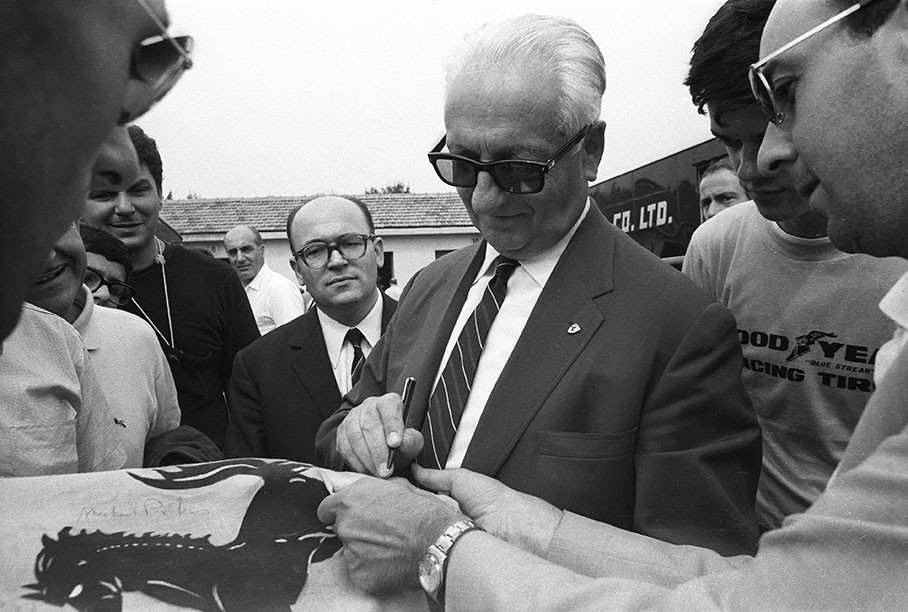
Enzo Ferrari gives autographs to waiting fans at Monza in 1966. Photo by Rainer Schlegelmilch.
“The car must first be dreamed of and then ask the collaborators if they feel capable of making it, if they share the dream of those who want to achieve success.” Enzo Ferrari
“You find something different in our cars, I'm not saying it's always the best, no, but something different. Because there is the intellectual relationship of man.” Enzo Ferrari
“We must always build one less car than the market requires.” Enzo Ferrari
“The racing car is like a son to me. When you think that the child represents the continuity of ourselves. You take him to school, the day he succeeds in his studies, that he’s the first of the class, you are proud of your son. This is what a manifacturer achieves by transforming the shapeless forged matter in a living mechanics, in a harmony of sounds.” Enzo Ferrari
“The drivers are divided into two categories, the professionals and the ambitious, that is the amateurs.” Enzo Ferrari
“If you are a natural talent you can be a racer. You don’t become one. You have to be a natural talent to be a top driver.” Enzo Ferrari
“The champion, you can find the stylist as you can find the man of extreme audacity but it is difficult to determine who is the best. There are completely different circumstances that require completely opposite personal characteristics and commitment.” Enzo Ferrari
“Fortunately the champion changes every Sunday, he is the one who wins.” Enzo Ferrari
“For my drivers I feel an affectionate interest.” Enzo Ferrari
“When one of your drivers dies you have many thoughts, for example about the hallucinating fragility of our life.” Enzo Ferrari
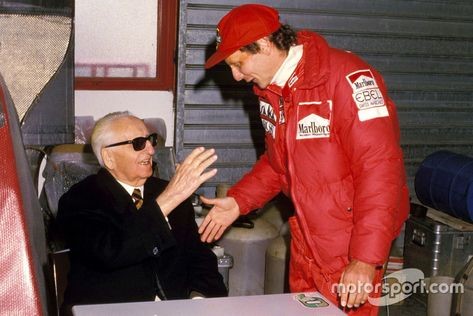
Enzo Ferrari with Niki Lauda.
“When Niki Lauda told me that he no longer wanted to compete with Ferrari, I thought he had broken a promise.” Enzo Ferrari
"My father advised me not to become friends with the drivers because sooner or later they leave us or die or go driving for the competition". Piero Lardi Ferrari
“There are too many causes that contribute to a mournful event, there is never a single cause. It’s the concomitance of several reasons that lead to a man’s sacrifice.” Enzo Ferrari
“There are often speculations about the death of a driver and if there is someone who sold the death, TV is one of them.” Enzo Ferrari
“My past is full of pain and sad memories: my father, my mother, my brother and my son. Now, when I look back, I see everyone I have loved. And, among them, there is also this great man, Gilles Villeneuve. I loved him.". Enzo Ferrari
“Nuvolari and Villeneuve were the only ones who won even when they lost”. Enzo Ferrari
“I was not ambitious but consistent.” Enzo Ferrari
“Only in racing and from racing the progress springs up and only in competition I see life.” Enzo Ferrari
“I don't remember anything worth more than the first win, there's nothing. They often ask me what was the most important victory of a car from my factory and I always answer like this: the most important victory will be the next". Enzo Ferrari
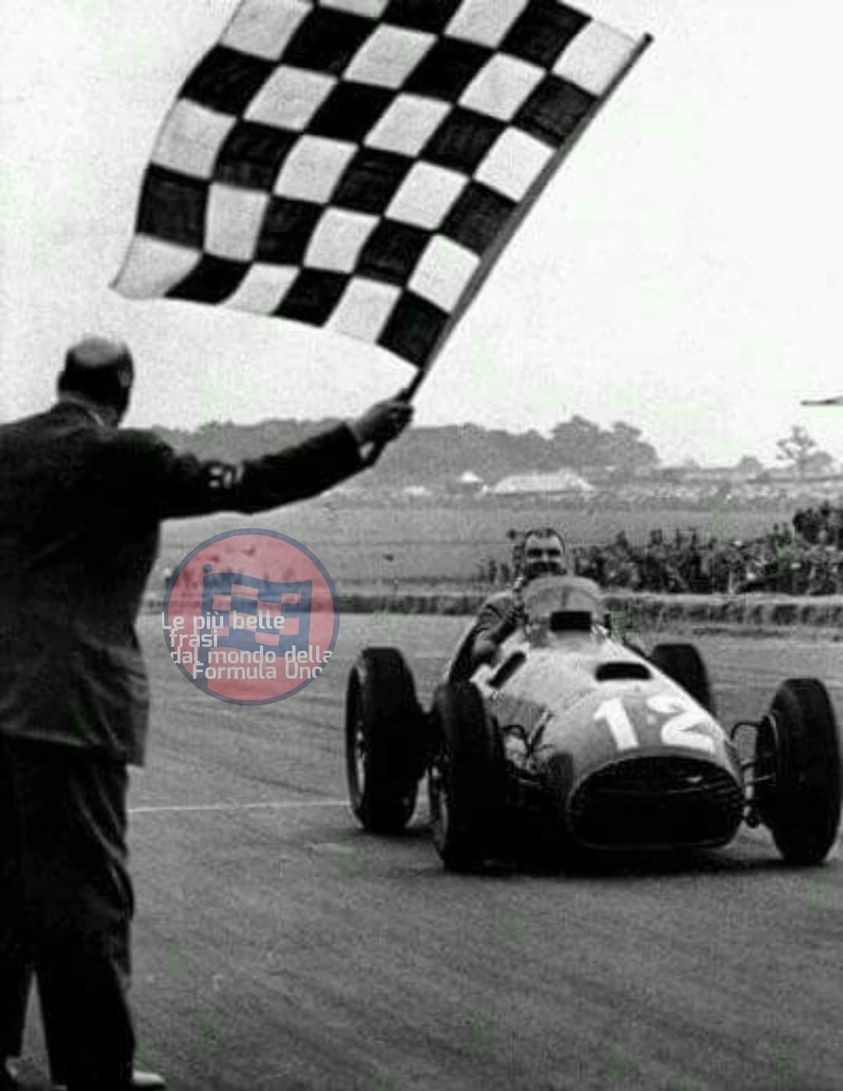
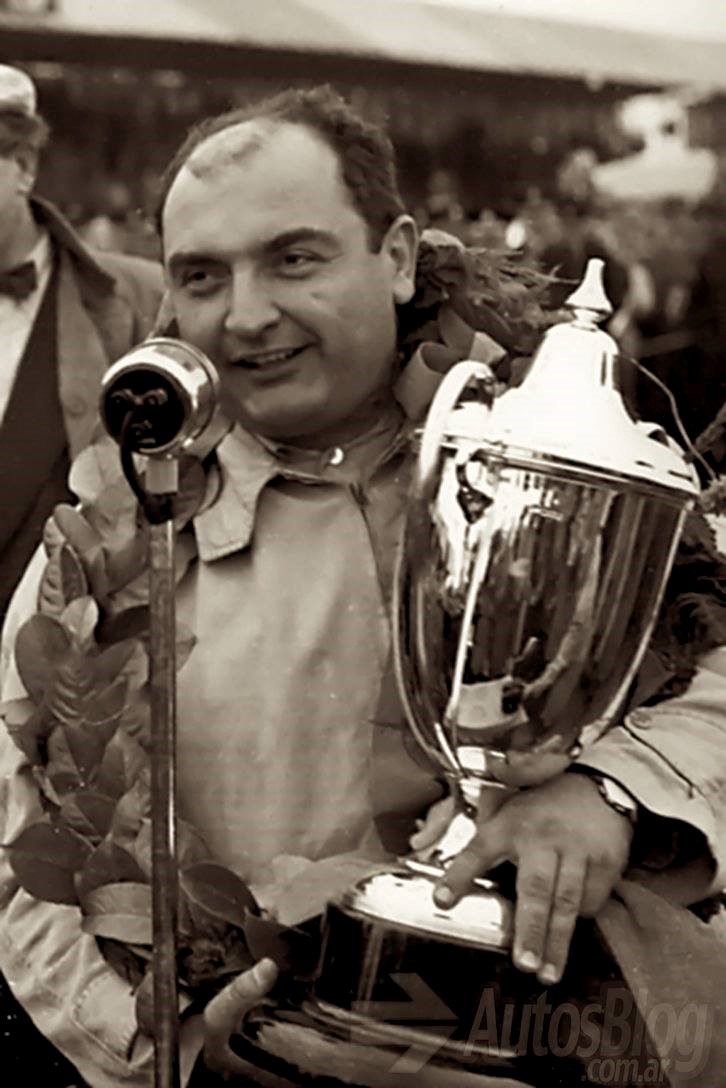
"When on July 14, 1951 Gonzáles in a Ferrari, for the first time in the history of our direct matches, left behind the 159 and the entire Alfa team, I cried with joy, but I mixed the tears of enthusiasm with the tears of pain, because that day I thought: I killed my mother.” Enzo Ferrari
“To win the race means experiencing a curious euphoria that coincides with the bustle of the crowd and the clapping on the last lap.” Enzo Ferrari
“Before the start of a race there is a sum of sensations that disappear as soon as the start is given.” Enzo Ferrari
“It’s easier to understand the defeat than the victory.” Enzo Ferrari
“My day is always monotonous, office in Modena, office in Maranello, Fiorano track, returning home in the evening. And on Sundays and public holidays Fiorano track and Maranello office.” Enzo Ferrari
“Do you know why I don't go around to visit even important people? Because if I go they can have a certain impression of me, nice, unpleasant, asshole, I don't know. On the other hand, if they come here the opinion they have is about the work I do, about what I build, about my collaborators. I am delighted to meet whoever comes here.” Enzo Ferrari
“Mine with the car is an indissoluble marriage so I didn't get tired of it, on the contrary I'm sorry at the thought of having to part with it one day. This is the only thing that saddens me.” Enzo Ferrari
“Young people today may know little about what was my life, my past. If I were to say that when I started I thought I was doing something more than just one car I'd say a lie.” Enzo Ferrari
“I have dedicated my life to the automobile, a conquest of freedom for man.” Enzo Ferrari
“Modena is the capital of engines because it is the home of rioters, of very generous people who want to work.“ Enzo Ferrari
“I believe I have had and still have a lot of friendships. My chagrin is that of not being able to know these many friends and those few that I have been able to fully evaluate evidently revealed to me some skills and substantially a contribution that not even relatives could have given me. True friendship is the contribution of feelings, of concrete facts in times of need, of necessity. When they arrive spontaneously, without soliciting. That's proof of true friendship. True friendship between pilots is very difficult to find, I would call it camaraderie.” Enzo Ferrari
“As for who hasn’t been my friend, I don’t have something that I cannot forget. I try to remember only the beautiful days spent together, never the contrasts. If someone is or was angry with me evidently he has or had reasons that I haven’t been able to neutralize.” Enzo Ferrari
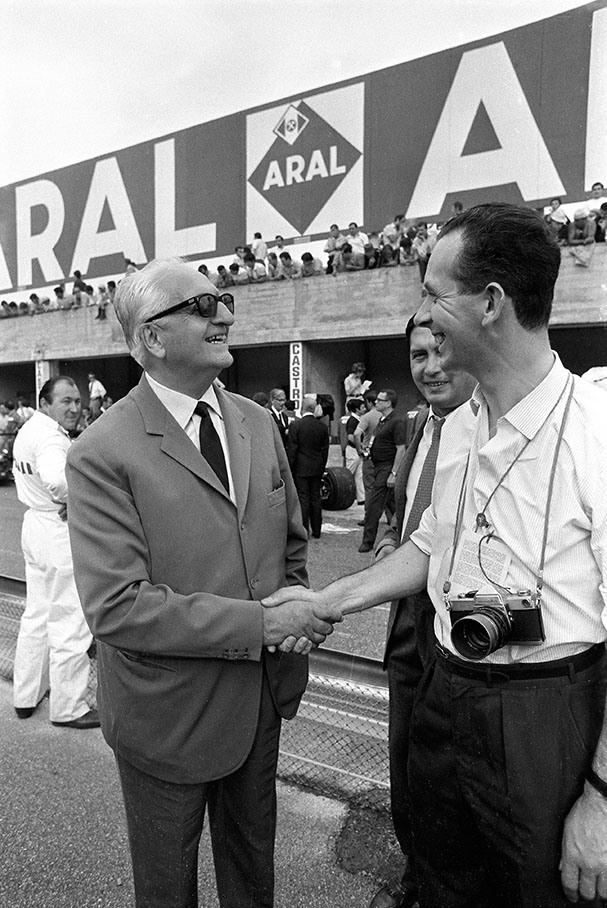
The British journalist and author John Blunsden shakes hands with Enzo Ferrari at Monza in 1968. Photo by Rainer Schlegelmilch.
“I have a very particular conception of love. Love is too serious a thing, a sum of feelings that cannot be confessed after three hours or three days or three months that you have met a woman. In the sense that in the beginning we are dominated by desire which has nothing to do with love. I love you means I want you so much.” Enzo Ferrari
“We men are selfish even with wives or acquaintances, with girlfriends because we expect that the wife is a beautiful woman, that she is an excellent cook, that she is an adorable mother, that she is kind to friends when they come into the house, then at bedtime we think they should replace any lover. I think it's a little too much.” Enzo Ferrari
“Women are the best reward for work.” Enzo Ferrari
“I think I did what I liked. I don’t think I have any credit with anyone. I just did something selfishly interesting for myself. I am reassured by the thought that what I have done has not harmed anybody, if then someone has benefited from it then my egoism finds a justification.” Enzo Ferrari
“It was a youthful dream that probably partially came true. Whether I am now a known man or not is something that concerns me, yes, but very relatively because I have not changed my life, my habits and, above all, my love for the beautiful mechanics. I remained a suburban boy who dreamed of becoming someone in the automobile field.” Enzo Ferrari
“To those who call me a dictator I answer that, if being a dictator means expecting from others the commitment that I profuse in my work, obviously they are right.” Enzo Ferrari
“To those who say that I have a grumpy character, I reply that they are right.” Enzo Ferrari
“I probably appeared tough and arrogant to mask my weakness. My brutal sincerity is often mistaken for cunning.” Enzo Ferrari
There is something terrible behind success. Italians forgive everything, thieves, murderers, criminals of all kinds, except success. They don’t forgive success to anyone.” Enzo Ferrari
“Whenever I am invited to give a judgment I refuse. I offer opinions, never judgments because I think about what I have done in my life and above all I believe that, in order to judge, you must have found yourself in the conditions in which the person you would like to punish or reward acted.” Enzo Ferrari
“I like solitude because I like to confess myself.” Enzo Ferrari
“I wear dark glasses because I don't want to give others the feeling of how I'm made on the inside. I side with great loves and great hobbies.” Enzo Ferrari
“I have always lived with fears.” Enzo Ferrari
“I have made many mistakes.” Enzo Ferrari
“More than once I have thought of retiring, I have never done it because my greatest terror is that of being unemployed.“ Enzo Ferrari
“I have read Stendhal several times because he was the first writer who brought me to face very rough situations without letting me enter the bedroom.” Enzo Ferrari
“Prizes are like invitations to breakfast, they arrive when they are no longer needed.” Enzo Ferrari
“I have the hope of being able to work until the last day.” Enzo Ferrari
“The competition is evolving and becoming more and more a show and each show has its needs. I believe that today there is the element of the economic interest that dominates many decisions, once there was pure passion.” Enzo Ferrari
“You become old only when memories take the place of dreams.” Enzo Ferrari
“I feel alone after so many events and almost guilty of having survived.” Enzo Ferrari
“I would say that life is a boundless jail.” Enzo Ferrari
“I worked a lot, I'm nothing, I'm not an engineer, what I got demanded a very high price. I think I have achieved many things beyond my merits and have been deprived of essential feelings that I would have prepended to any other result.” Enzo Ferrari
“This has been my life, that I don't hesitate to call a panting walk. I have now walked over the top of the mountain. Countless times I looked in the mirror wondering who I was, what I came to do in the world. I believe that if I had been offered to start the journey again I would not accept. I would hate to go back to a world where violence has ended up replacing reason. This is a world I no longer recognize myself in.” Enzo Ferrari
“A balance of my life will be made by those who take me to the cemetery.’ Enzo Ferrari
“How would I like to be remembered? I would prefer silence. If I could I would say: "forget me". If it is inevitable: “like the one who invented hot water.”" Enzo Ferrari
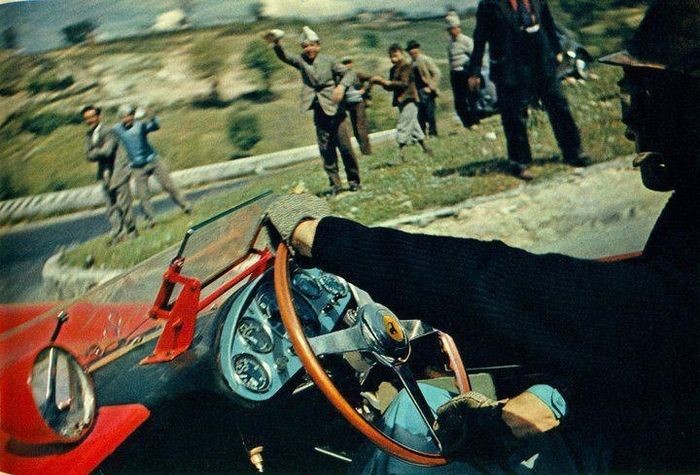
Enzo’s passion for winning had led some drivers to the worst …
"I was very intimidated because, in any case, I realized I was entering a temple when we went to his office, the one still attached to the racing department of the old management, an unadorned room. When we met for lunch he was very relaxed, very affectionate, but he had a charisma that made you feel a little in awe. Perhaps I have understood Enzo Ferrari more in recent years when I combined those memories with what I read about him and I also read the opinions that others had of him. And then a figure is put together, perhaps that of an elusive person. Because you never knew where he was. He could be the closest person emotionally and affectionate or a person who has been described as extremely detached from events or people in a way that was perhaps also extreme, I would say almost cruel, which is not however the correct term. And then this is the charm from which awe is born. He had a great attachment to victory then he wanted to produce the cars, he wanted to win. He was very different from others in the automotive world, for him producing cars was almost a means to achieve victory. Perhaps his charm was that he was not classifiable because he was always in another dimension. Great observer, extremely intelligent person, connoisseur of human emotions, of the human soul and of human weaknesses. So he could read situations perhaps better than any other person." Paolo Barilla
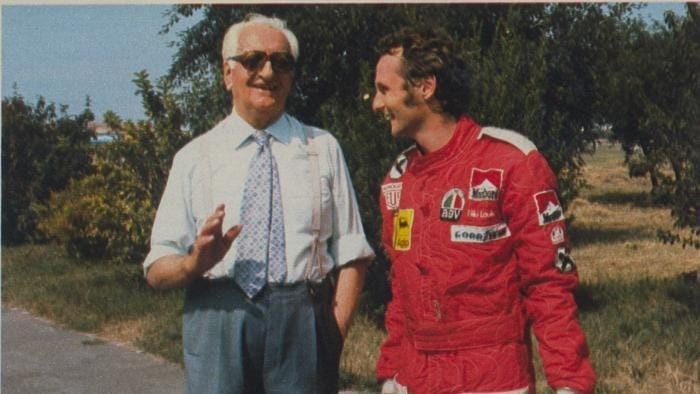
Enzo Ferrari with Niki Lauda.
“Enzo Ferrari was a person with a great character, a big heart and a very hard head.” Niki Lauda
“Enzo Ferrari? A curmudgeon with a heart of gold. A great, the greatest of all. I met him in 1973 when in a race I finished with my BRM in front of Jacky Ickx's Red. Luca di Montezemolo approached me and invited me to Maranello. The Drake proposed that I race for him the following season. Obviously, I liked the prospect. However, I didn’t have much opportunity to negotiate on the salary: 50 million lire, there was no way to go further. I then proposed to Ferrari an "in-kind" supplement: "you give me a Ferrari Daytona, I drive it for a while, then I sell it and make cash." He agreed and gave the order to deliver the car to me: the problem was that I badly ruined it in an accident. For me Ferrari was the boss and I have always had great respect. When I needed him, I knocked on his door and walked in. If we had a quiet conversation, everything went smoothly: Ferrari was indeed a figure with an enormous personality, but he was at the same time a good person. Even though the divorce was a bit traumatic in the end, I never had a big problem with him. But he had a shortcoming and I also told him, in the proper manner of course: he never came to the races. He let himself be informed by an entourage that sometimes presented the situation to him in a sweetened way, even though he was then able to evaluate the flow of information and make the right decisions. In any case, in addition to having the support of Luca who was my intermediary, I have always preferred to tell him things that are almost hard, but true. And I gave of the you to him, or rather I said "hello Enzo", every time I met him: for his loyalists it was shocking, Ferrari being the President, the Commendatore and, at least, the Engineer. Not that it was easy to deal with Ferrari, actually. In Fiorano, during a test, his son Piero was my interpreter, because he spoke English well. Enzo turned to Piero and made me ask: "how's the car going?" I replied: "it's understeering like a shit ...". Piero was stunned and said to me: «I can't translate this for you. A Ferrari is never a shit car ...”. I concluded: "well, then tell him it has hellish understeer." Even said like that, it was an unwelcome criticism: he wanted to kick my ass. On another occasion he summoned me to ask me this question: "the car is too slow, what can you do?" I replied that I was not an engineer and that it was not my job. But I had an idea to gain from three tenths to a second. Ferrari called Mauro Forghieri, the technical director, who was not entirely convinced, but the Drake cut it short, looked at me and admonished: “it is the first and last time that I do such a thing. Make sure it works.” Within a few days, we improved by eight tenths and, since then, I believe I have earned Ferrari full respect. Of course, we also had fights over money, for example in '76. Enzo told me: "I'm not giving you a penny more than last year, a driver should be happy just to drive a Ferrari". I replied, "I want the equivalent of $ 300,000." He cursed, said all kinds of bad words, then we settled for 280,000. But the battle continued on the exchange of the schilling, the Austrian currency of the time. In my most difficult moment as a man, that is after the accident and the burning at the Nürburgring, I learned that Ferrari, despite being impressed by what had happened to me, had immediately put the interests of the Scuderia first: he had given the order to Daniele Audetto, the sports director, to contact Emerson Fittipaldi to replace me. And, when Fittipaldi explained that he couldn't come, he fell back on Ronnie Peterson who, in the end, didn't come to Maranello.
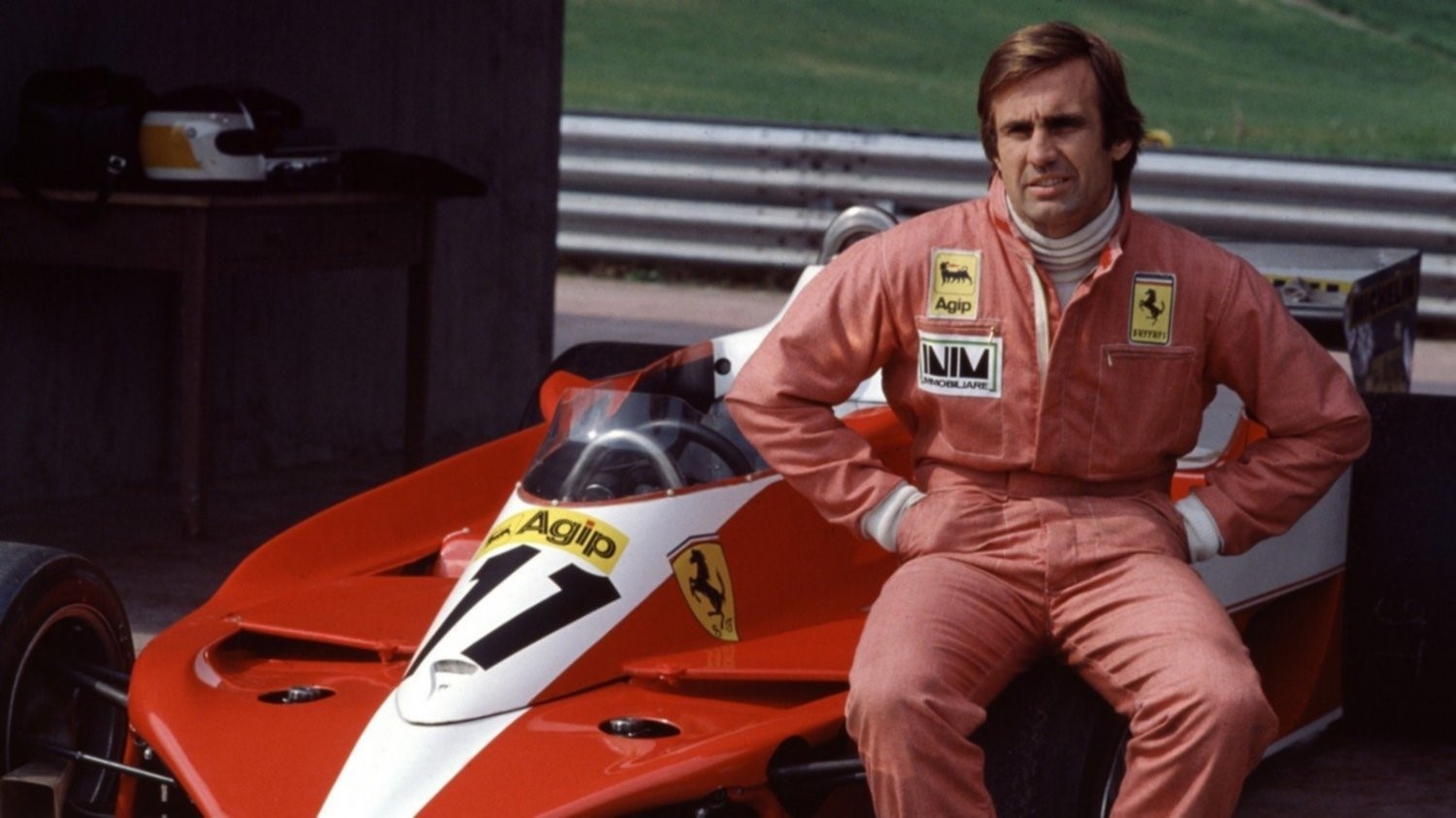
Carlos Reutemann, Ferrari 312-T3.
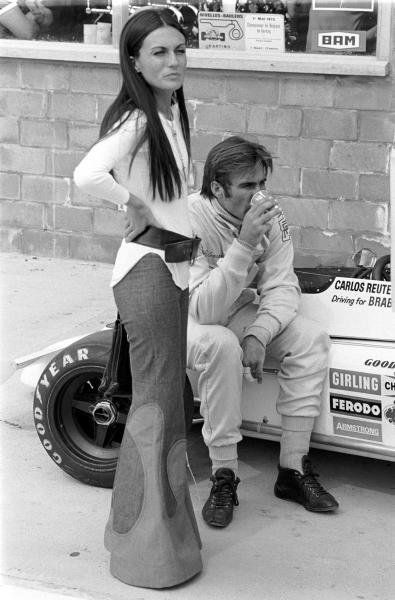
Carlos and Mimicha Reutemann.
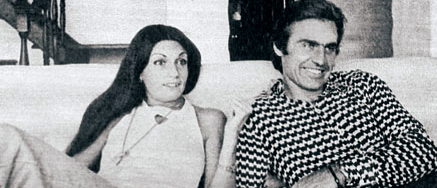
Carlos and Mimicha Reutemann.
Ferrari was convinced that I would never be able to go back to racing and, from his point of view, I can also understand it. Instead, it irritated me that he had bet on Reutemann even though, for better or worse, I had proved to him that I was still an F1 driver. This is a controversial chapter in my relationship with Enzo: when, at the Fuji GP, I decided to retire due to the downpour while Hunt continued and won the title, Ferrari supported my choice. But later he reproached me for the decision to return at Monza already: in his opinion I had exaggerated in anticipating the times.
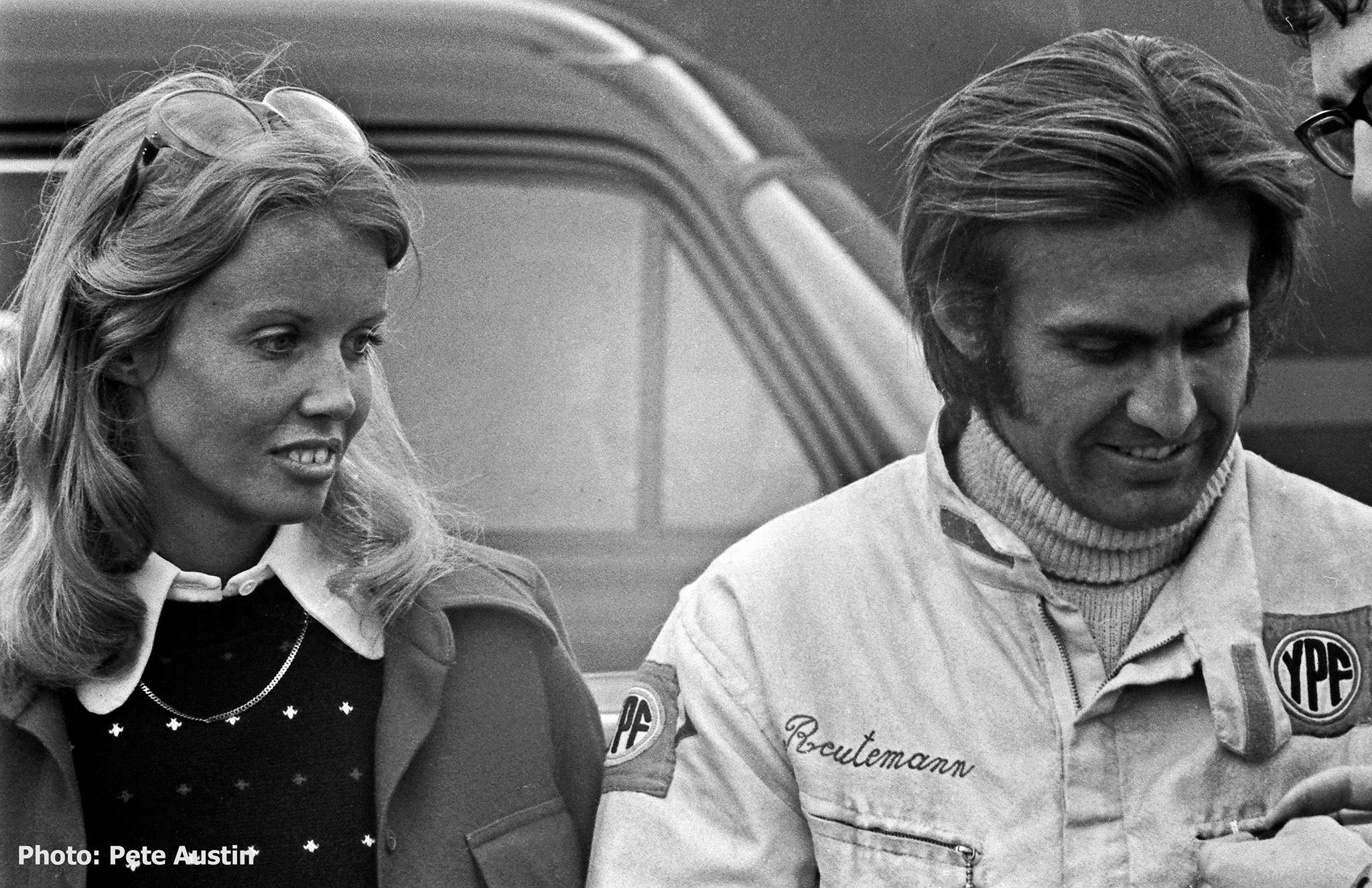
Carlos Reutemann with Barbro Peterson. Photo by Pete Austin.
In the end I convinced him to keep me next to Carlos for the 1977 season: Reutemann started the championship better, but I was the one who imposed himself. I had already decided to leave Ferrari and I did not race the last two Grands Prix, as the title was now safe. Ferrari took it very badly. He thought it was a betrayal and a rudeness: in particular, he had not understood my reasons for testing myself in another team. The tear was stitched up during a test in Imola, but first the Drake had sent me a Christmas letter written in green ink: peace had returned. There will no longer be someone like Enzo Ferrari, the most charismatic person I have ever met in my life. But thank God, Luca di Montezemolo and Ferrari always manage to honor his memory and his great, very great story. Niki Lauda
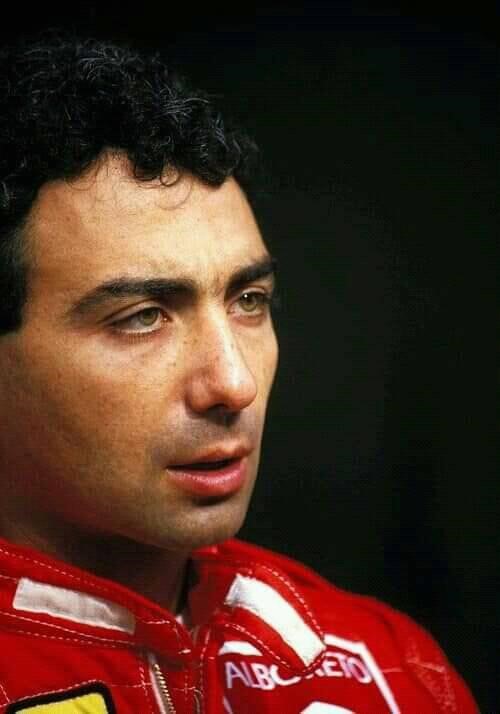
Michele Alboreto.
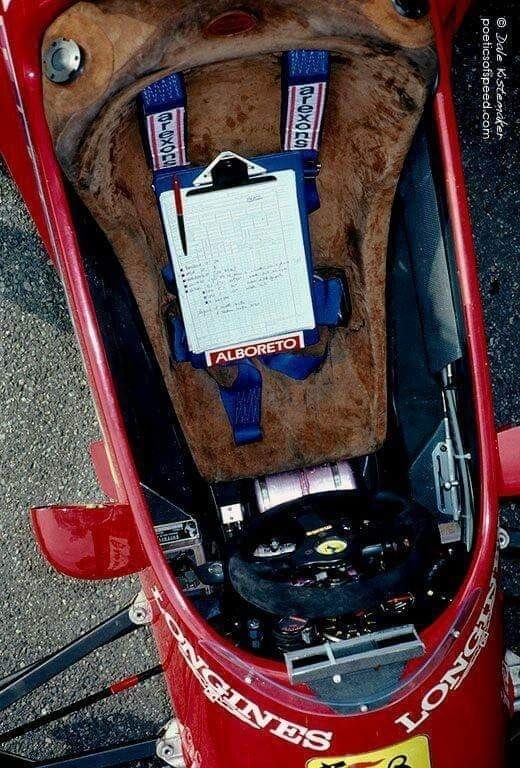
Michele Alboreto’s Ferrari.
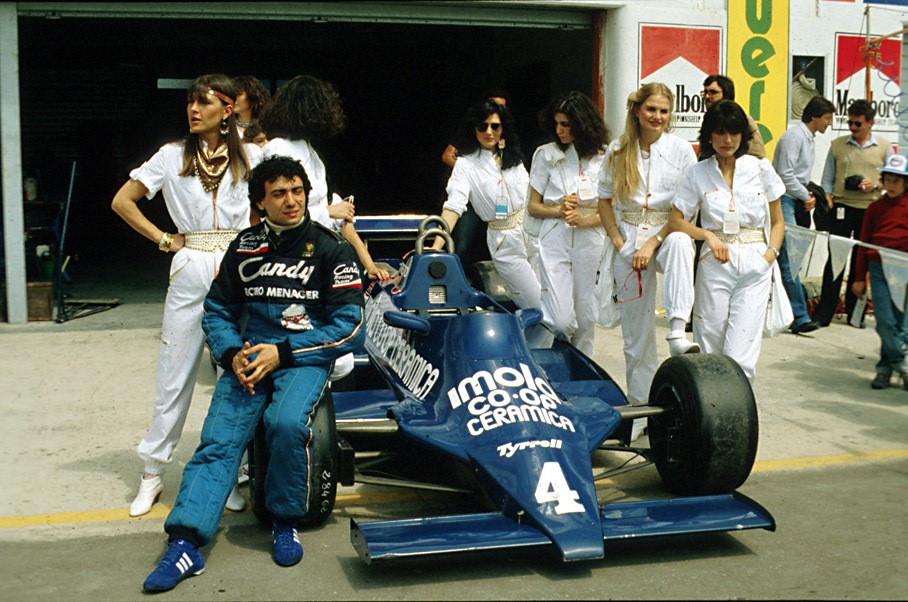
Michele Alboreto, Tyrrel Ford, at Imola in 1981. Photo by Rainer Schlegelmilch.
“It was not Enzo Ferrari, an Emilian entrepreneur, who went to knock on the door of the greats but it was the kings and emperors who came to buy the car in Maranello.” Michele Alboreto
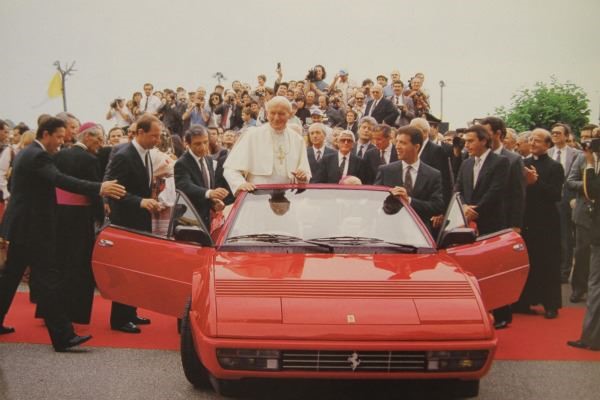
This is the only Ferrari the Pope was ever seen in. On the 4th June 1988, a truly unique visitor was welcomed in Maranello. Coming through the gates of the Ferrari factory was Pope John Paul II. On that day Karol Wojtyla was welcomed by Piero Ferrari.
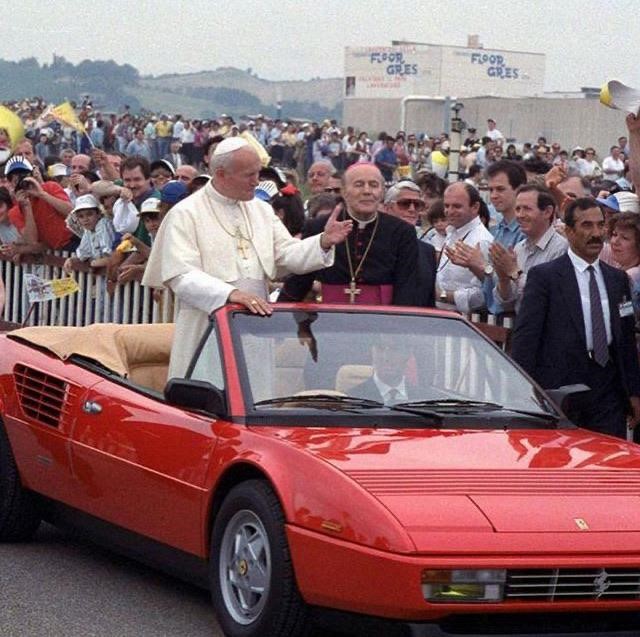
Pope John Paul II in a Ferrari Mondial Cabriolet in 1988.
“I am very different from my father Enzo. He started selling his father's house to buy racing cars. He was also a man who had outbursts of generosity and tenderness that he never advertised. Perhaps he didn't want to let it be known, he wanted to cultivate his image of a determined man, of a tough man. Races were his life. He loved to drive. He was a driver, how good I don't know, who drove until he was 85 years old with a fairly tough, aggressive style, like in the 1930s and 40s without synchronized gears. He was very hard on the gearbox and would also put his foot down very hard on the brakes. But he had great control of the car. My father could not decide on a name for the first car he designed and my mother said to him: “call it Ferrari … like Bugatti did!” If I imagine my father today … no, I can’t imagine him. I think he would have been very happy with what Ferrari does.” Piero Lardi Ferrari
"You can work for many companies but in the end the one that remains impressed is Ferrari because Ferrari is a myth". Daniele Audetto
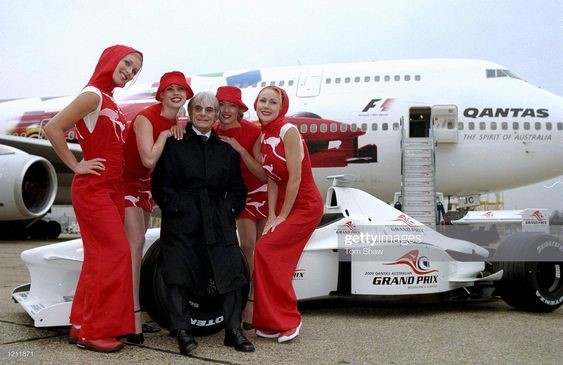
“My first meeting with Mr. Ferrari was strange; because of his lack of English and my lack of Italian. But with the help of Mr. Gozzi we managed very well and became close, probably because he trusted me and I trusted him. Even when we had the FOCA/FIA war, behind the wall, he supported me. Although he always referred to the English teams as garage people he had big respect for Colin Chapman of Lotus. He liked people to think that he supported FIA as that was the legal establishment but was always happy with the deal that we closed together. I really miss this real gentleman, Mr. Ferrari. He could be relied on to do what he promised”. Bernie Ecclestone
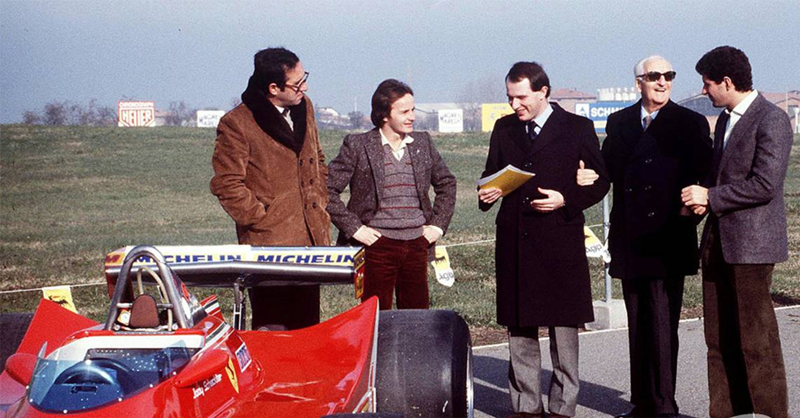
Gilles Villeneuve with Mauro Forghieri, Marco Piccinini, Enzo Ferrari and Jody Scheckter in 1980.
Sometimes Enzo Ferrari would call me precisely at noon and say: "come to Maranello, let's have lunch at one at the Cavallino and then have a chat". I had a Giulia Super 1600 cc and, even if you drive fast (there were no speed limits), to do about 190 kilometers in an hour was impossible for me. I always made this objection to the Drake and he laughed at me replying: "you don't know how to drive anymore!" It was a little theater that was repeated every time. The Monday following the 1981 San Marino GP I had hit hard because Gilles Villeneuve had taken pole position and was penalized by a wrong choice of tires: it was raining but, at a certain point when the rain had completely subsided, Gilles had returned to the pits for mounting the slick tires but, when it started to rain again, Villeneuve had to return to the pits again finally reaching the finish line with almost 2 minutes of gap. That didn’t sit right with me because I suspected that the decision to make Gilles return to the pits was made by the team and not by the driver. Maybe I was wrong but I was crazy about Gilles: I angered Ferrari who for two or three months didn't answer the phone anymore. One day, around a quarter past twelve, he phoned. He told me: "we must not be angry, come to Maranello and at one o'clock we will have lunch at the Cavallino and talk". Usual theater. "Engineer, how can I be in Maranello in three quarters of an hour?" He replied: "go down to the courtyard, you will find a Ferrari with a driver who will take you here faster than with your car". I went down to the courtyard and saw an orange Ferrari, dented in several places. Close by, smiling, there was Gilles Villeneuve. He said in that strange Italian of his, full of French “R”: “come on Nestor, I was here with a sponsor and the Engineer told me to come and get you”. The trap was sprung. We hit the highway and started traveling at 250 km per hour on the … hard shoulder. Gilles passed the trucks as if they were adversaries on the track, every now and then he re-entered the carriageway when the trucks were three or four in column. “Gilles, I'm scared, go on the normal carriageway”, I moaned. And he, laughing: "shut up and have fun". I was hoping for the traffic police. Nothing. As God willed we got off the highway and Gilles calmed down a bit. He knew that on the road to Maranello there were the policemen who never forgave him for anything. And he had paid several fines. We arrived at the Cavallino at one and six minutes. From the courtyard of the Corriere to there it had taken Gilles 51 minutes flat. A madness. We entered the restaurant, went to the room where Enzo Ferrari used to have lunch. The Drake was standing near the table. He smiled. "Did you have fun?" He asked. And suddenly the plot of what had been a kind of tragedy for me was clear to me. I replied: "no" and tried to leave. But Franco Gozzi and Athos, the manager of the Cavallino, stopped me and took me back to the room. I sat down pretending to be sulking but in my heart I thought that perhaps 98 out of 100 Italians with Gilles at the wheel would have a blast. And then, finally, I too smiled and ate happily. Villeneuve then finished fourth in Belgium but won the next two races in Monte Carlo and in Spain. And in Madrid his was an epic victory, the last of Gilles”. Nestore Morosini
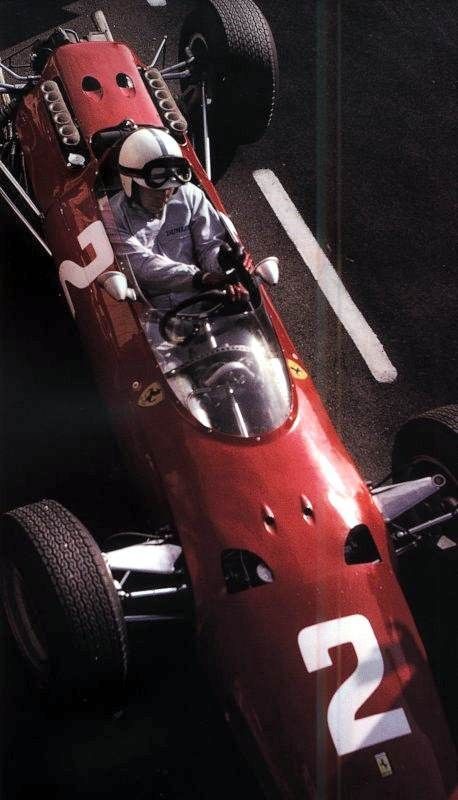
I still remember the first reaction when for the first time I arrived in Maranello from Milan. I wanted to get a first impression, set the seat because we wanted to do the tests right away and try the car. It was an extraordinary moment. I arrived at night and it was really exciting to see the Ferrari factory, to get in tune with the place. There was fog, the atmosphere was mysterious, it was like being in a movie, I got goosebumps. When I entered the factory I had a kind of shock because the building was old and I was expecting a modern, technological factory. I expected everything to be more beautiful, newer but it was all the opposite, everything was very traditional. But obviously what matters is not the appearance of the structures, what you do with those structures counts. Michael Schumacher
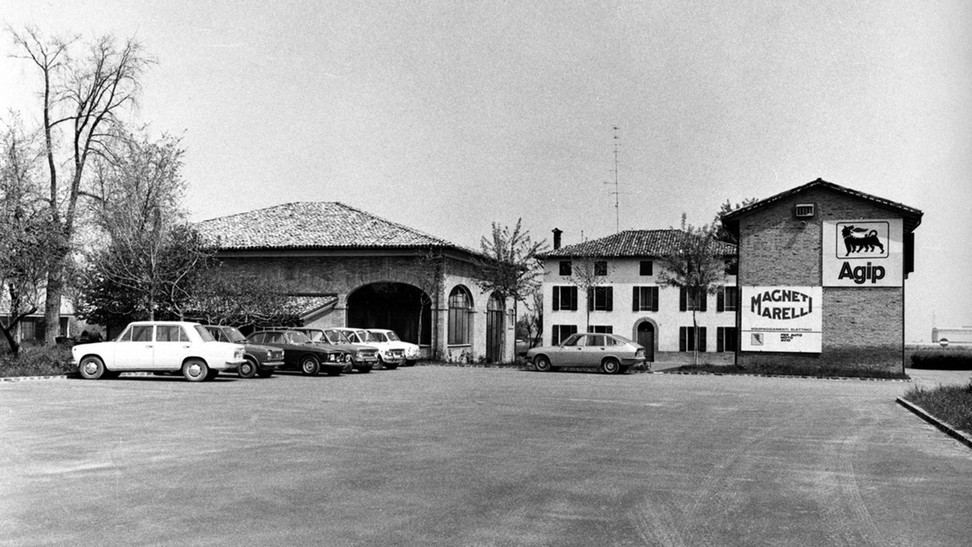
Enzo Ferrari’s house at Fiorano circuit in 1972.
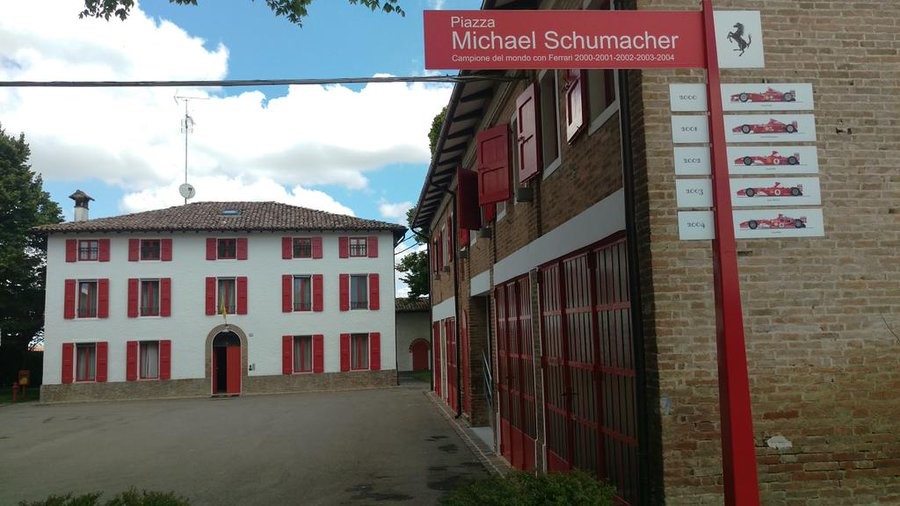
Enzo Ferrari’s house today.
“I walked in there rather shyly and was enchanted by his desk above which there is a silver frame with his photograph inside. I've always tried to move in there with respect. For a driver occupying the Ferrari house is like a musician who can stay in Mozart's house". Michael Schumacher
“I understood the difference of racing for Ferrari or for any other team: with other teams you are the driver of a team, when you race for Ferrari you are the driver of an entire country. It's a fantastic feeling”. Jody Scheckter
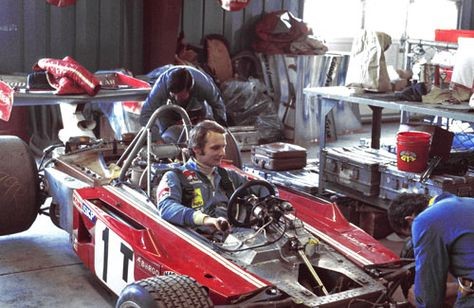
"For me Ferrari is my heart, Mercedes my wallet". Niki Lauda
“There is no car like Ferrari.” Niki Lauda
“For those who know Ferrari there is the brand, there is the past, there is the amount of victories they have achieved. For those unfamiliar with it there is the appearance and also the noise because the noise of the Ferrari engine, with the tuning of the exhaust, is like an organ tuned in the right way. One hears this noise and is automatically attracted.” Gianni Agnelli
‘Not all Italians cheer for the national football team but all Italians and 50% of non-Italians cheer for Ferrari.” Gianni Agnelli
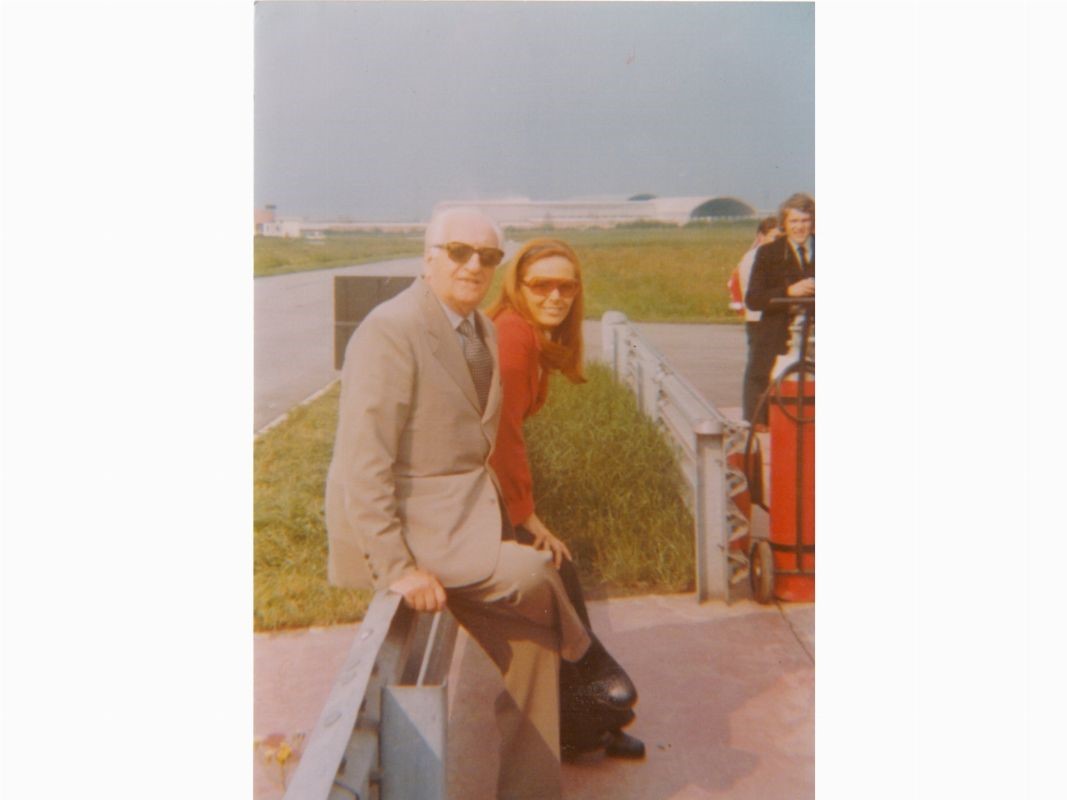
Fiamma Breschi with Enzo Ferrari.
Fiamma Breschi and Ferrari. By Francesco Veramini.
“A shock was immediately born between the two of us. We quickly became friends with an instinctive trust. At our first meeting he looked like a farmer, in a frock coat, with old and worn out, above-the-belly-button, ankle-length trousers, with low socks, with a deformed hat on his head. Amazed, I asked my beloved Luigi: is this Enzo Ferrari?"
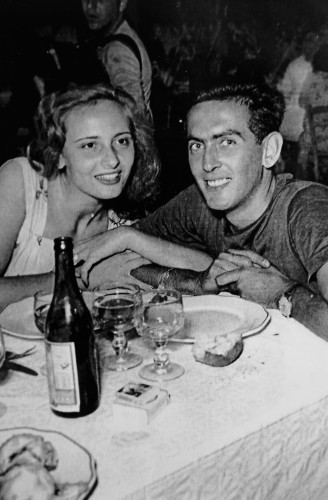
Fiamma Breschi with Luigi Musso.
Fiamma Breschi, a beautiful Florentine woman, a woman of the past with the beauty and freshness of today, a lady with streaked hair, big glasses, t-shirts and low-waisted jeans was "able to dress the Ferrari of tango Red, bud green, China black and flame yellow". She invented the colors of the most desired car in the world.
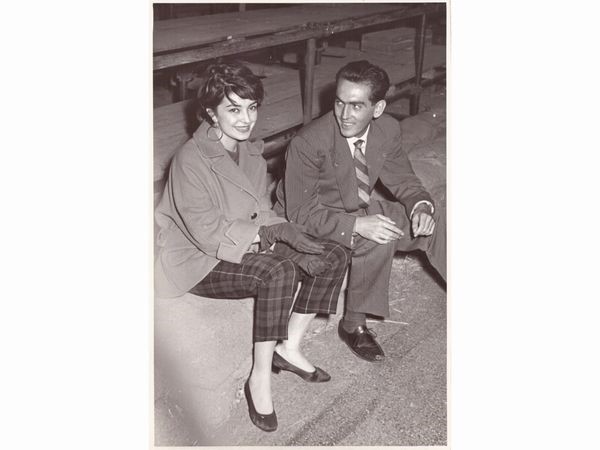
Fiamma Breschi with Luigi Musso.
"Enzo Ferrari? I only know that he asked me to marry him until 1988, the year in which he died. But I've always told him no. I’ve never been in love with him: my only love was Luigi Musso. Even if I had a nothing short of wonderful relationship with Ferrari”.
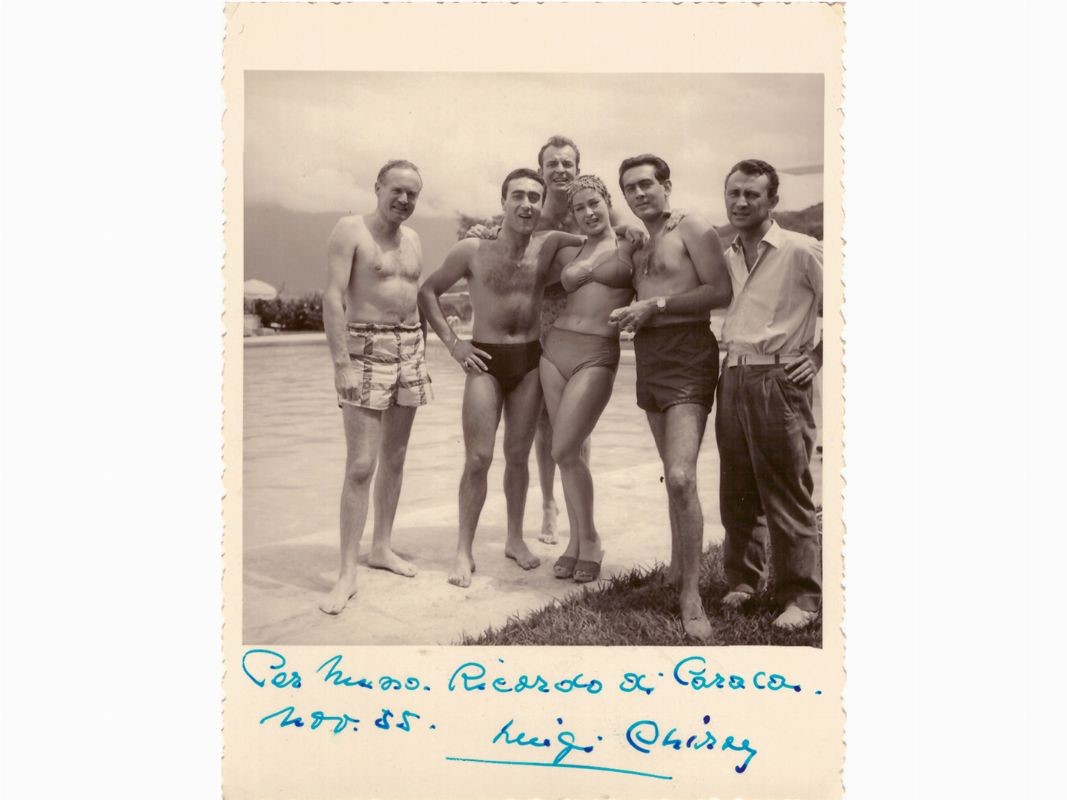
Fiamma Breschi with Luigi Musso.
Some sources including Romolo Tavoni tell of a different reality, namely that Ferrari after Musso's death was very close to her to the point that a long-lasting relationship was born between the two which resulted in Fiamma's desire to marry the Drake.
It is worth mentioning her in an interview in 2009: what did Enzo Ferrari represent for you?
"He was a great friend. A wonderful man, intuitive, with a difficult character. But not as they invented on TV in that fiction that didn’t do him justice. I think I have always been a bit ahead of the times, one thing that always came to me instinctive was the look: I have always loved the combination of colors and clothing. I saw Ferrari and immediately thought he had to change. He was already a character of great depth and presenting himself like this was not right. For him first of all. Ferrari played along. He entrusted himself to me and I invented what later became his way of dressing himself. For example, he used to wear only black and white ties. From Florence I brought him the colored ones by Gucci. And then he changed his mind too. He said yes to color himself. To put on light clothes, white shirts, black glasses. On what I advised him he nodded amused. Even if, out of our friendship, I know well how he behaved especially with the drivers of his Primavera team. He pitted them against each other so that they stimulated each other so that the competition between them could start. This is why they called him "brain agitator". For Ferrari the drivers were in a sense robots who drove his cars. And when I told him something about his rough manners he shut me up: “I consider myself worse than the others but I don't know how many are better than me”».
"Enzo Ferrari was a man above the natural: I have never met an intelligence like this. He was an honest man and smart as hell. He had a devourer relationship with life and he occupied all the space of the people around him be them his drivers, his children or his women. He was a car builder and a destroyer of men but if you entered his orbit you would have given anything not to get out of it”.
"There has always been an underlying misunderstanding between us: I wanted a role in the world of cars, he thought it was enough for me to live in his cone of light. 'When does such a fortune come back to you?', My mother told me. In fact, it never happened again but I never stopped loving my man, Luigi Musso and it’s like that still today".
How did you meet Luigi Musso?
«I met him in a restaurant in Rome: he was already married. As soon as we looked at each other I felt inside me that he would be the love of my life. It was a scandal at the time because he left his wife and his daughter. We were speechless with awe, we didn't care about the world. Then it all suddenly ended in Reims, he died in an accident on the circuit. More than 50 years have passed since his death and there is still no moment of the day that I don't think about him".
Were you Enzo Ferrari's secret woman or not?
«Not so secret. Partner yes. But not in that sense. We were friends, it was something big but platonic. We also spent four hours a day on the phone. Maybe that's why our relationship lasted so long. Already in 1962 he wanted to marry me, that's true, he had also planned the checks».
How was it that the friendship between Enzo Ferrari and you was consolidated?
“After Luigi's death he approached me with kind words: I wanted to die too, it is useless to hide it. He wrote me to go and see him, he told me to eat and keep my spirit up. To take long walks in the countryside. He encouraged me to live”.
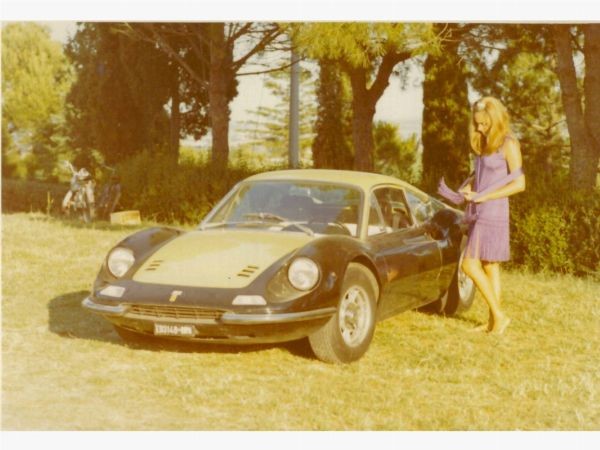
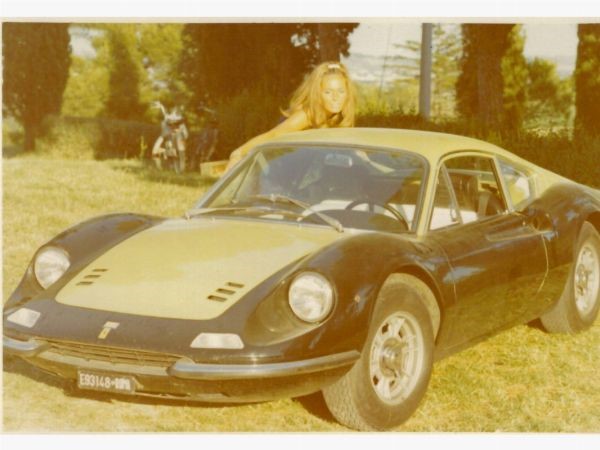
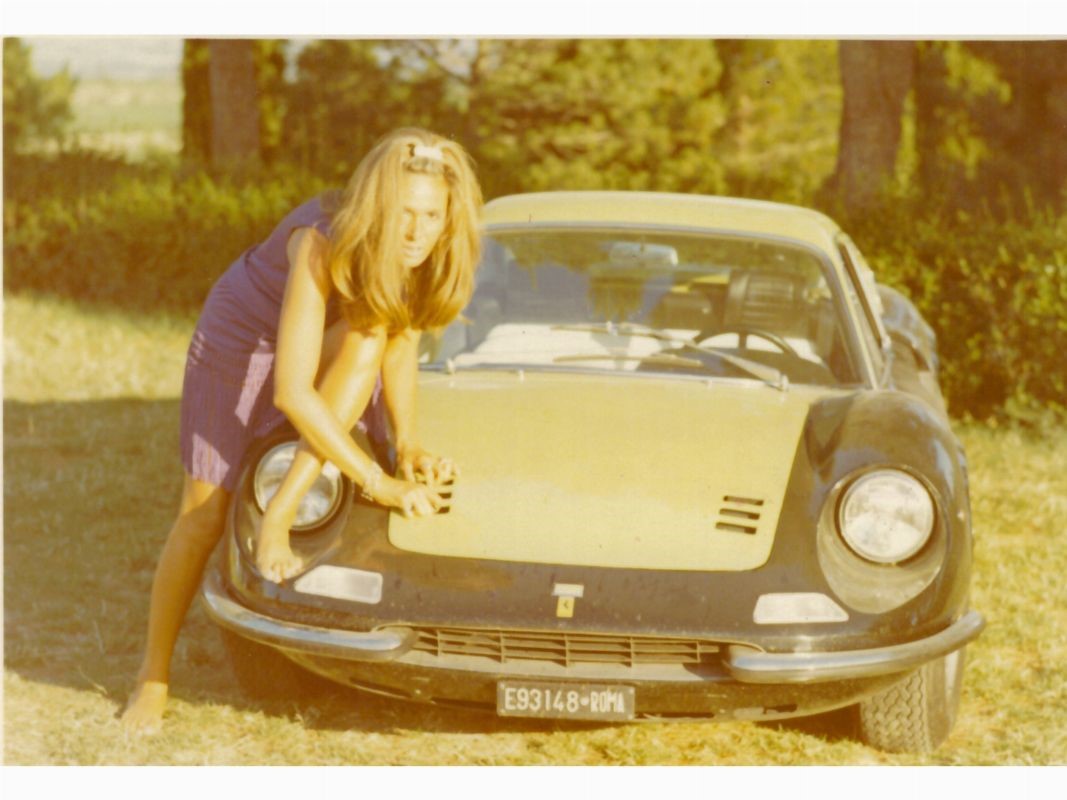
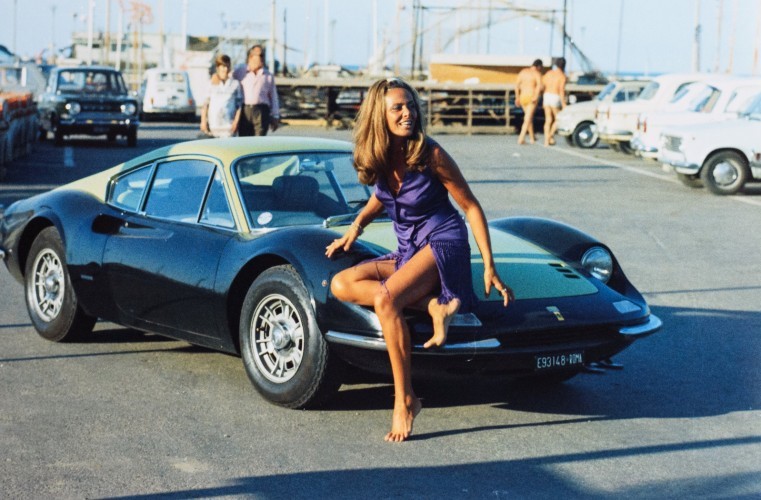
“I have his letters which testify it. After Musso's death he wanted me in Maranello, without being the boss's lover as everyone thought in that provincial Italy. I had my own class and my own culture, maybe Ferrari must have fallen in love with this too. He wanted me to choose cars and models, colors and drivers. For Ferraris I conceived the long nose, for example, or the two-tone ones that are back in fashion today. He trusted and I was not wrong. I can say proof in hand that I have contributed to the growth of the style of the Maranello firm”.
Did something have your signature?
“Before Vuitton, in 1966, I invented a set of suitcases for the Ferrari 275 in printed canvas".
Ferrari in Florence: has he ever been at your place?
«Twice and it was an exception: everyone knows that he didn't move from Maranello. But in Florence he came to eat at my house. In 1976 he made my mother have a cup with the prancing horse with the inscription: “to Clorinda, the best cook in the world”».
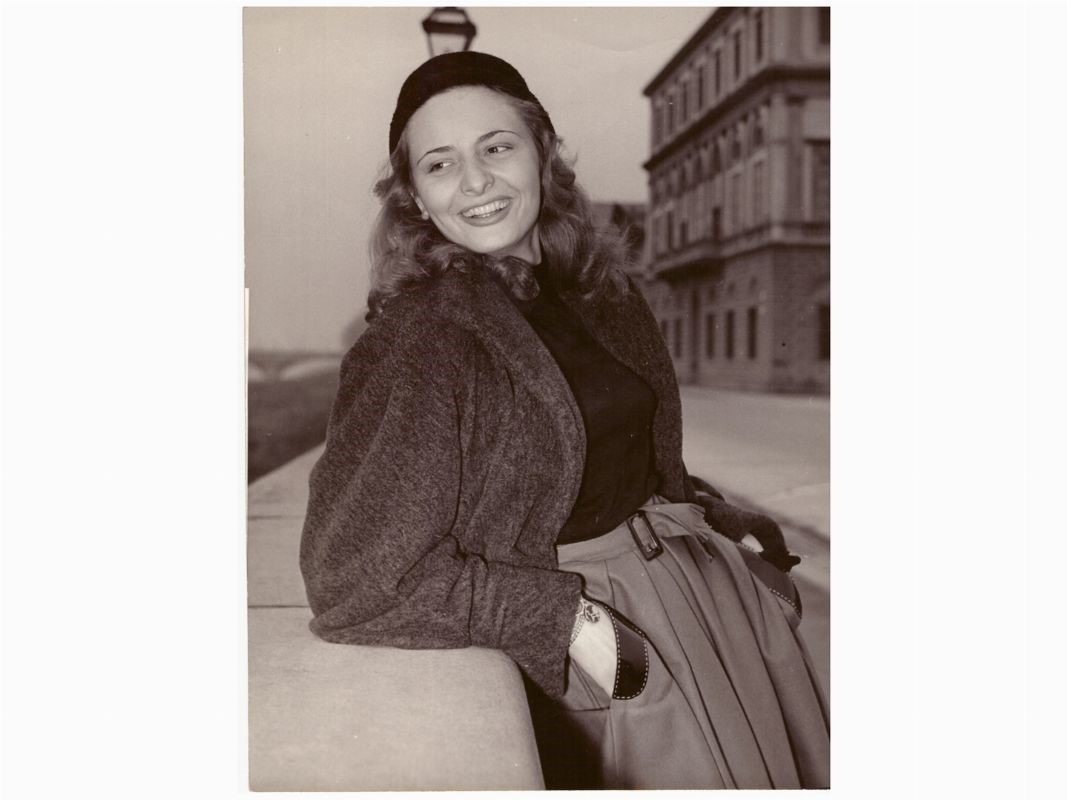
The last appointment with Fiamma Breschi. 23 November 2015. Ruoteclassiche. By Alessandro Barteletti.
The last time we saw Fiamma Breschi was also the first. It was March 9, 2015, this year. Before us only Enzo Biagi had written about her: Fiamma Breschi was a very capable woman at not being found. And she was just as adept at finding you.
It has happened to us twice. The first when a letter from her arrived in our editorial office because we had written about her beloved Luigi Musso. The second on the sidewalk in front of number 16 of a street not far from the center of Florence, where she lived. And where, on March 9, we met her.
On the phone she told us that we would have found her name on the intercom and to ring as soon as we arrived. We were doing it. Once, twice, three times: no answer. Not far away a woman with perfectly styled blond hair and a pink jacket observed the scene but we did not take into account that presence, at least until we met her gaze. Then we understood and she understood too: she held out her hand, ready for a firm handshake: "a pleasure, I'm Fiamma". Fiamma Breschi was like this: direct, overwhelming and with a smile that kept her face constantly illuminated.
Fiamma Breschi died last November 20th. She was 81 years old. We re-publish the article from that time to be us this time to find her. And so that you too don’t lose her.
It would deserve the script of a film and a book would not be enough to tell the life of Fiamma Breschi. Yet the interviews she gave can be counted on the fingers of one hand: one is the one she granted to Enzo Biagi in 1980 for the book “Ferrari”. Another is the one you are reading.
Fiamma Breschi was the girlfriend of Luigi Musso, the Ferrari driver who disappeared in Reims in the accident triggered by Mike Hawthorn on 6 July 1958. "When the doctor told me that Luigi was dead I started to throw myself out of an open hotel window but a handshake grabbed me and brought me back to reality: it was that of Beba, Juan Manuel Fangio’s girlfriend”. For over thirty years you have been Enzo Ferrari's confidant, friend and "spy". "He wrote me letters every day, sometimes more than one a day, with the unmistakable purple ink and his sideways handwriting: he ended up asking me to marry him but I said no". And when, a year and a half ago having to remember on these same pages the figure of Luigi Musso ninety years after his birth, we tried to contact her she seemed to have disappeared from the face of the earth. No references in the telephone directory, no one "of the circle" who had news of her, no Internet page with her contact details. The only clue is the book she published in 1998, “My Ferrari”, in which she wrote her story: too beautiful not to be told.
Strange but true for a woman who for years has been a witness, albeit discreet, to a world perpetually in the spotlight like that of Formula 1. A woman who has been able to boast illustrious friendships: "I met Delia Scala when she was Eugenio Castellotti's partner, we remained friends until she passed away; I refused to give Vittorio Gassman a lift in my car, he asked me in a very rude way; Roberto Rossellini came to my house for me to help convince Enzo Ferrari to make a film about him”. On the other hand the fact that took place shortly after the publication of the article on Luigi Musso was surprising for us: to receive in the editorial office the letter, strictly handwritten, in which Fiamma Breschi thanked us for that memory. Yes, it was her who found us.
A film life. The house in Florence where she welcomes us is the same where Rossellini asked her that favor. Certain questions should not be asked a lady but Fiamma Breschi makes no secret of her age: "I was born in Florence on April 24, 1934". The first encounter with engines took place a short time later: "I started a car when I was nine". The Topolino of her uncle, who parked every evening under Fiamma's eyes: “one day he'll forget the keys inside, I said to myself. And if he forgets the keys I'll go around! So one day he left them unattended and I went around. At 14 I was already driving, at 18 I got my driving license". She has a lot of fun telling us that fact. Fiamma Breschi is like this: with an overwhelming vitality and a smile that still makes her face shine (however she asks us not to photograph her, we disagree but respect her choice).
Instead Luigi Musso arrived in her life when she was seventeen: “handsome, tall and two eyes…, two eyes! When I saw him for the first time he didn't even notice me but the next day we met again to take a trip with some friends and I was the first to get into his red Lancia 'Sport'." Her way of telling is hilarious, pressing, with the rhythm of that speech witty in the tones and aspirated in the sound that only those of Tuscan origins can boast. “The day I got my driving license Luigi and I immediately went for a ride in the car and, at a certain point, he gave me the wheel. He stopped me two curves later: 'but who gave you the license I'd like to know!' Then he explained to me what was the way to sit, the positions of the hands, how to keep other drivers under control. He showed me that the passenger must swing but not bounce, explaining to me that this is a sign of a clean driving, the one that pays the most as was his. Don't think they were just a driver's tricks, those are the rules for driving correctly. And then for me these rules in life were used to do many things".
Like becoming Enzo Ferrari's “spy” many years later. “Ferrari - and this is a well-known story - never followed the races in person. So at a certain point he decided to send me to Monte Carlo where the drivers' market was decided”. Fiamma, summing up today, has known three generations of drivers, from Fangio to Senna. She began to frequent the pits when the wheels were changed with a copper mallet and gasoline was put in the tank with the funnel. She has seen the salaries of the pilots multiply from a few tens of thousands of lire to billions euros. "In short I had a bit of experience and then in Monte Carlo, as a special correspondent for Ferrari, I tried to understand what was the mood and to consider the opportunities. Then I called him and told him what I saw, what I felt and what it seemed to me. I gave him my point of view which was clean, sincere because it was not influenced by all the mechanisms of the team: the rules that Luigi had taught me twenty years earlier were helping me to understand which drivers were worth to bring to Maranello".
Enzo Ferrari broke into the life of Fiamma Breschi in the months following Musso's death. “I already knew him, of course, because Luigi was racing for him. But after the accident I fell ill, a severe form of hepatitis and it was then that Ferrari began to write his letters to me. Some have been lost, some have ended up in a thousand pieces but the others are still here: some speeches, without 'proofs' I wouldn't do them. In this correspondence that lasted years there are also the clear, explicit, precise statements in which Ferrari asked me at a certain point to become his wife". But Fiamma, the voice becomes serious, said no.
It was tiring to be “Ferrari”, Fiamma tells us. "There is no reason but at a certain point in his life he chose me to confide in. I only realize now the need for him to do it. He feared that someone might discover his weaknesses, his fears, his contradictions. He felt too well known, too discussed, too cumbersome. Above all he felt alone".
"When I met him, Fiamma still remembers, Ferrari was wearing short socks and underarm pants. Then, over the years, we became more and more confident and I advised him (she says "advised" but the sly expression she has printed on her face suggests "imposed") to dress differently. More elegant, more modern, I chose his ties. And he, who was an intelligent person, humored me because he understood that his figure gained by it”.
Fiamma does not just intervene on Enzo Ferrari's personal style because, at a certain point, she also has her say on that of the Ferraris. "Shall we talk about colors?", She asks us pretending disinterest as if the topic was not one of her favorites. She starts again like a raging river: “I have always liked yellow, it was also the color of Luigi's helmet. One day I make myself a dress of a beautiful yellow, all tight with a jacket on top of it and I think that color would have looked really good on a Ferrari. So I go to Boano, who was one of the best coachbuilders on the market: 'can you make me this yellow here?' He works on it for fifteen days, then he calls me: 'I'm sorry, it doesn’t come to me, this yellow crashes'. So I go to Scaglietti, who takes it a bit as a challenge given that Boano had failed. He calls me eight days later, he will later confess that he had worked on it day and night, to tell me that he had made it". A 275 GTB of this color with a long nose (that too was my idea, I proposed it to Ferrari by making a scribble on a drawing of the original version, inspired by the hood of the car Cruella De Vil drives in a cartoon) goes to the Geneva Motor Show but it's a disaster, nobody likes it. I didn't understand, Fiamma resumes. "Then I saw it: do you know a glass of watered down white wine? Here you are, it was like this. But I didn't give up and another 275 GTB was sent to the Paris Motor Show, yellow as I said. The rest is known history”.
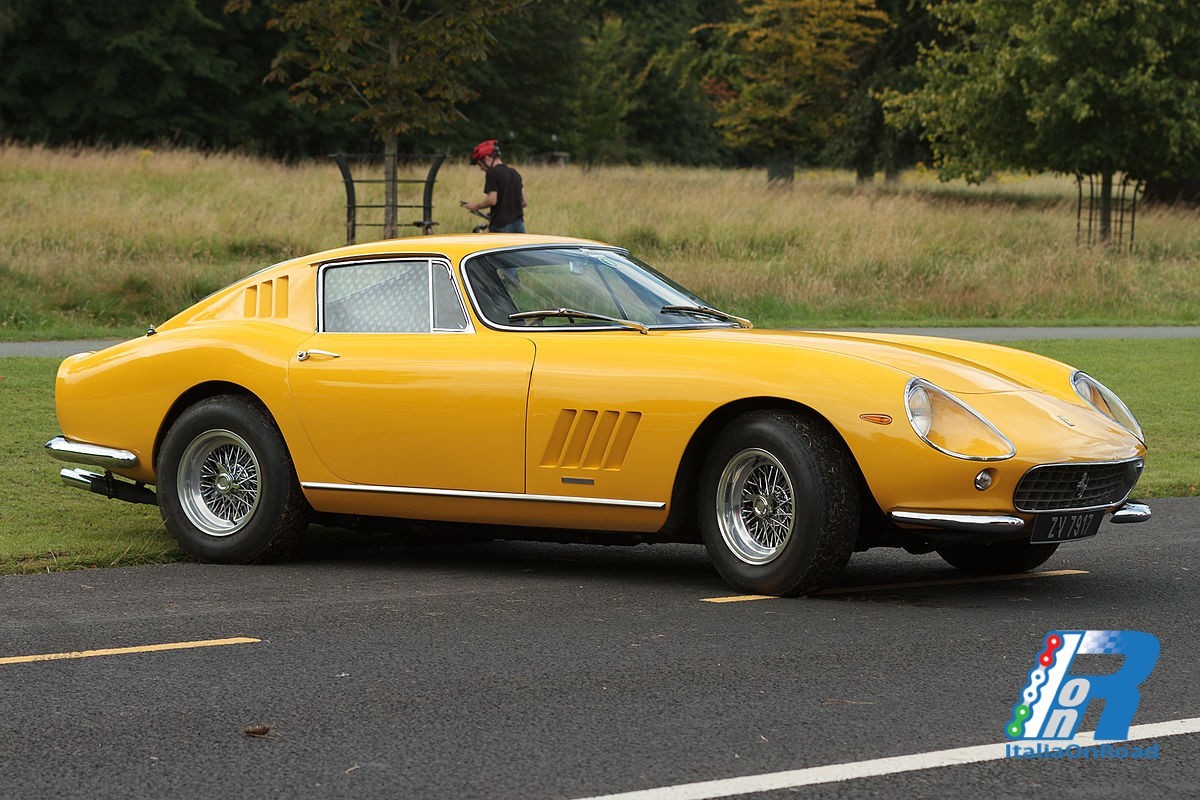
1965 Ferrari 275.
The new color is called Fly Yellow because, Fiamma confides us again, Enzo Ferrari told her that Fiamma Yellow could not be done: "at least there was the 'F' and then he wrote me this ...".
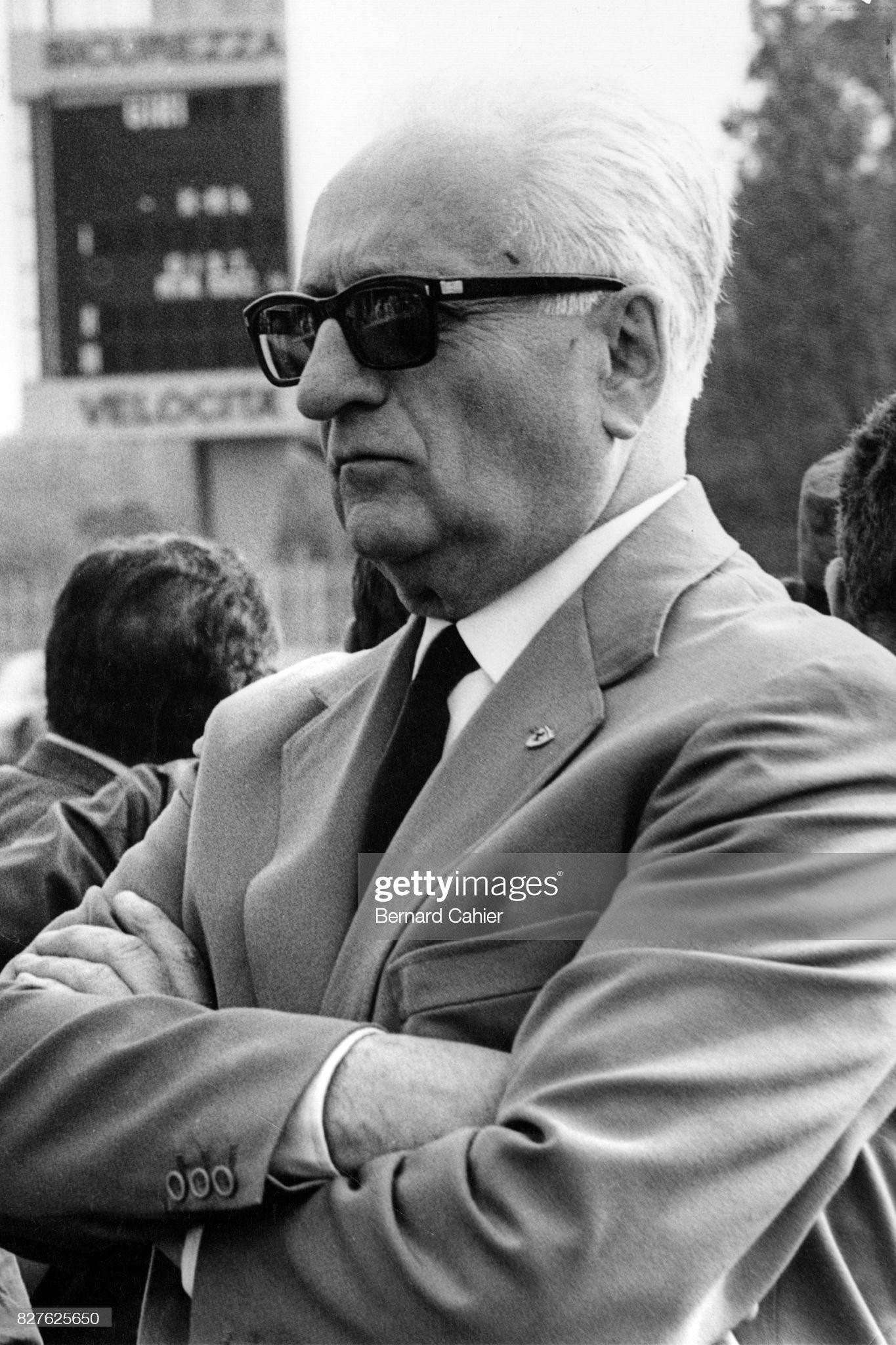
Enzo Ferrari, Grand Prix of Italy, Monza, 12 September 1965. Photo by Bernard Cahier/Getty Images.
She shows us a dedication on the first page of a copy of “Le mie gioie terribili” (My terrible joys) translated for the Rising Sun: April 24, 1959, Roman hepatic yellow, referring to Fiamma's hospitalization in the clinic in Rome. And then below: April 24, 1966, Fly Yellow has reached Japan! Signed Enzo Ferrari.
Fiamma Breschi, Enzo Ferrari's lady in yellow. November 25, 2015. By Umberto Zapelloni.
An obituary signed by Mauro Forghieri and Gaetano Passarelli announced the death of Fiamma Breschi in the Corriere della Sera. But who was this beautiful woman that the engineer Forghieri, father of many successful reds, remembers "with pain and regret when races were lived and won with great carefree and cheerfulness and with the presence of beautiful ladies in the pits".
Fiamma was first of all the partner of Luigi Musso, the talented Roman driver who died at the age of 34. Musso was a driver who did not spare himself. On and off the track where he enjoyed life right down to the last drop of champagne. "A butterfly cannot fly all its life" was the phrase he used to describe his way of understanding life.
Fiamma Breschi after the pain of the death of her beloved continued to attend the races after meeting Enzo Ferrari, with whom she embarked on a daily correspondence (the letters of the Engineer, in purple ink, were bought by his son Piero a few years ago before they end up at auction). What the relationship between Enzo and Fiamma really was is not known but the influence the lady had on Ferrari was clear. At least to hear what she wrote in her book "My Ferrari" and told in various interviews.
Here are some examples:
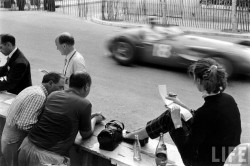
Fiamma in the pits.
“He wrote to me for years. I still have the dozens and dozens of letters he sent me. Sheets of paper covered in purple ink that he used because he thought it was a "disappearing" ink, that is that it would have vanished with time. It was not so and even today the Drake still speaks to me through his letters”.
"I first met Ferrari in 1953 and the last time I saw him was in 1987. He was a great man, with a lot of brain. A defect? To expect the best from people”.
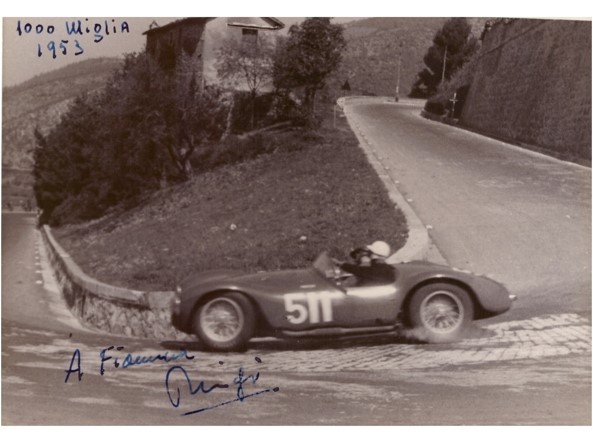
Enzo Ferrari's letters to Fiamma Breschi. "You are a twisted thread, a match against the wind." By Alice Dutto. 24.05.2017.
Photos, memorabilias and love messages written by the «Drake» to his inspiring muse. They will all be auctioned on May 29th. An opportunity not to be missed for collectors of the Cavallino and for fans of Formula 1. Fiamma’s suit also inspired the yellow of the cars.
Fiamma Breschi is one of the most fascinating female figures in Formula 1. She has always been passionate about cars.
An unprecedented Enzo Ferrari, more human and sensitive than he wanted to appear. This is what we find in the words he dedicated to the woman he was in love with, Fiamma Breschi.
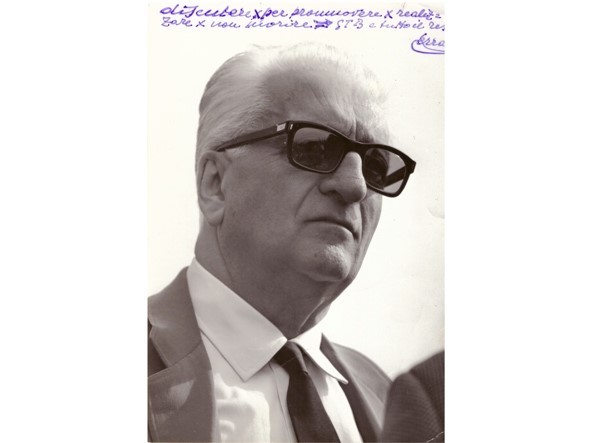
His letters, in which he promised her eternal love and asked her to marry him despite the age difference, will be sold by Maison Bibelot in Florence on Monday 29 May in the auction «Fiamma Breschi, the Lady of Formula 1». Among the lots there will be many other rarities in the field of publications and collectibles related to the world of the Cavallino and of the four wheels.
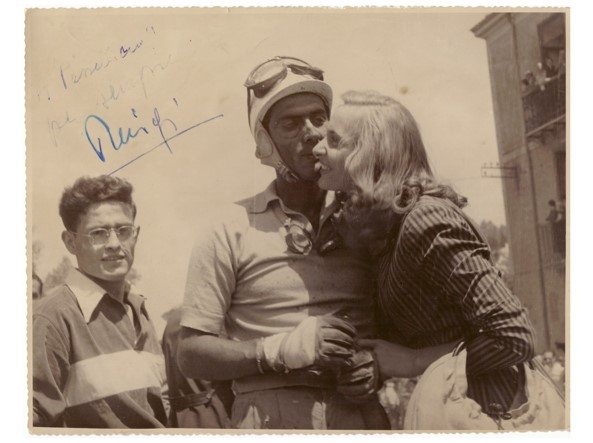
The progress of the relationship between Ferrari and Fiamma can be seen by how the tone of their writings changes over time. Until the middle of 1959 Ferrari signed with his surname while Fiamma was the «cara signorina» (dear miss).
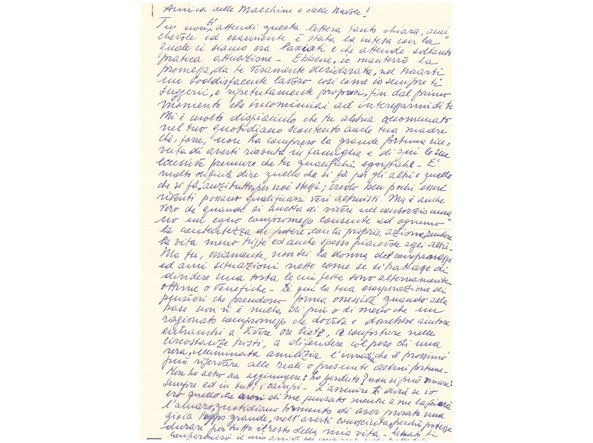
Afterwards the tone will become more confidential: from "lei" (Madam) to "tu" (you) and Fiamma is nicknamed "signorina Bertuccia" (Miss Barbary macaque), "filo ritorto” (twisted thread), "fiammifero controvento” (match upwind), “Testa dura non di legno” (hard head not of wood), «l'Amica delle Macchine e delle Nuvole» (the friend of cars and clouds). Ferrari is nicknamed "Anselmo" or "il prode Anselmo" (the brave Anselmo), making fun of his middle name.
A letter dated May 22, 1959 will be auctioned, in which Ferrari tells of having helped for three years during the Second World War a young widow of Polish origin who was persecuted together with her son.
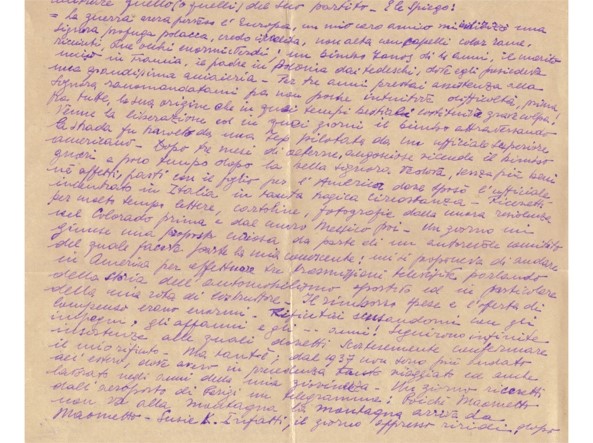
1960, the letter of the 400 Super America
In the letter dated 14 January 1960, Ferrari wrote about the 400 Super America designed by Pininfarina, which was to debut shortly after and which was then produced in 46 units until 1964.
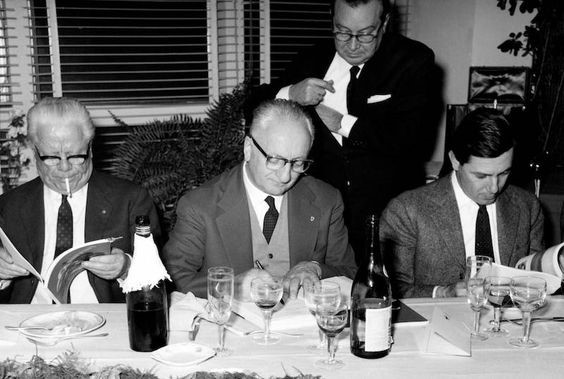
Battista Pininfarina, Enzo Ferrari and Sergio Pininfarina (right).
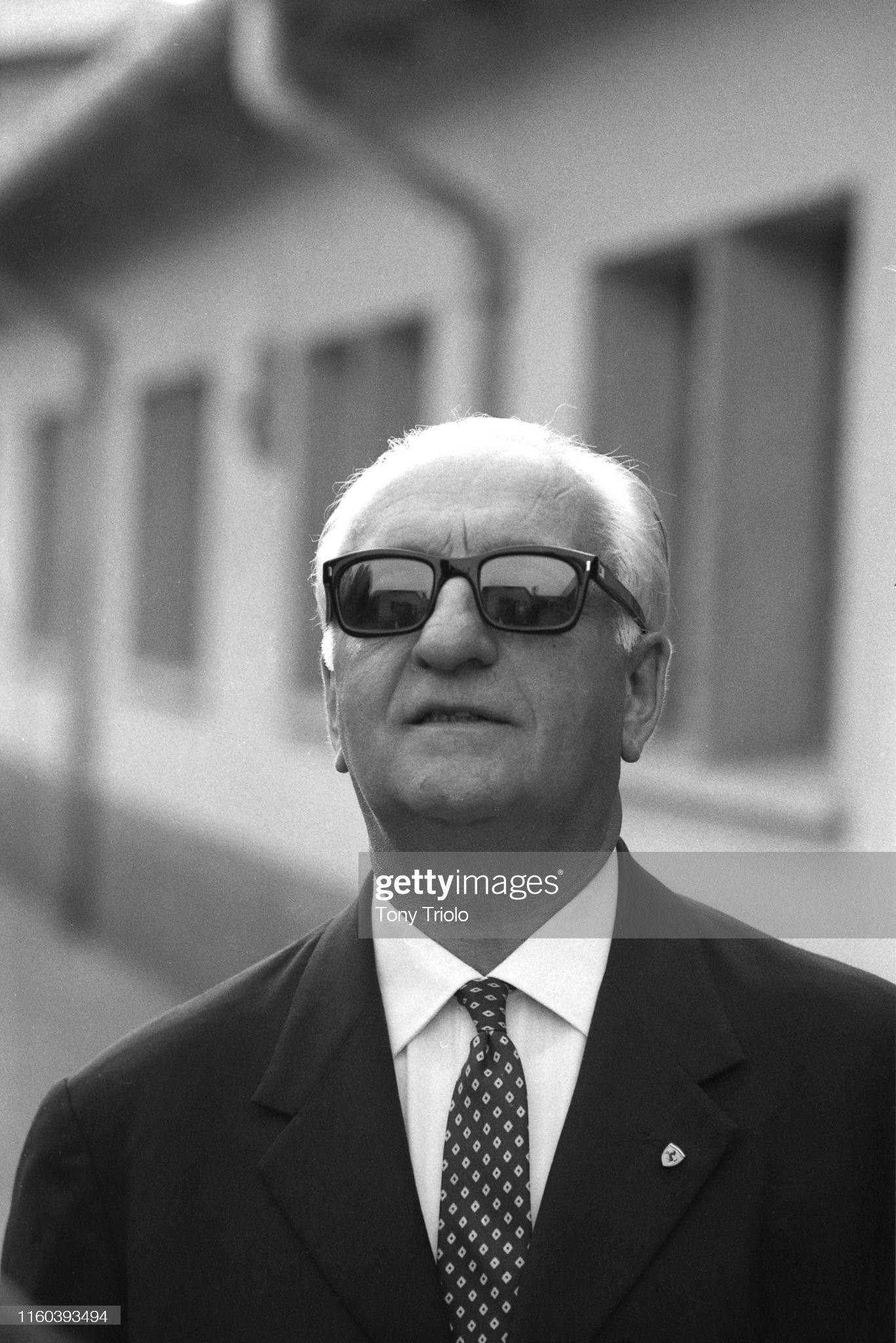
Closeup portrait of Ferrari founder Enzo Ferrari in his factory office. Maranello, Italy 7/20/1964. Photo by Tony Triolo /Sports Illustrated/Getty Images.
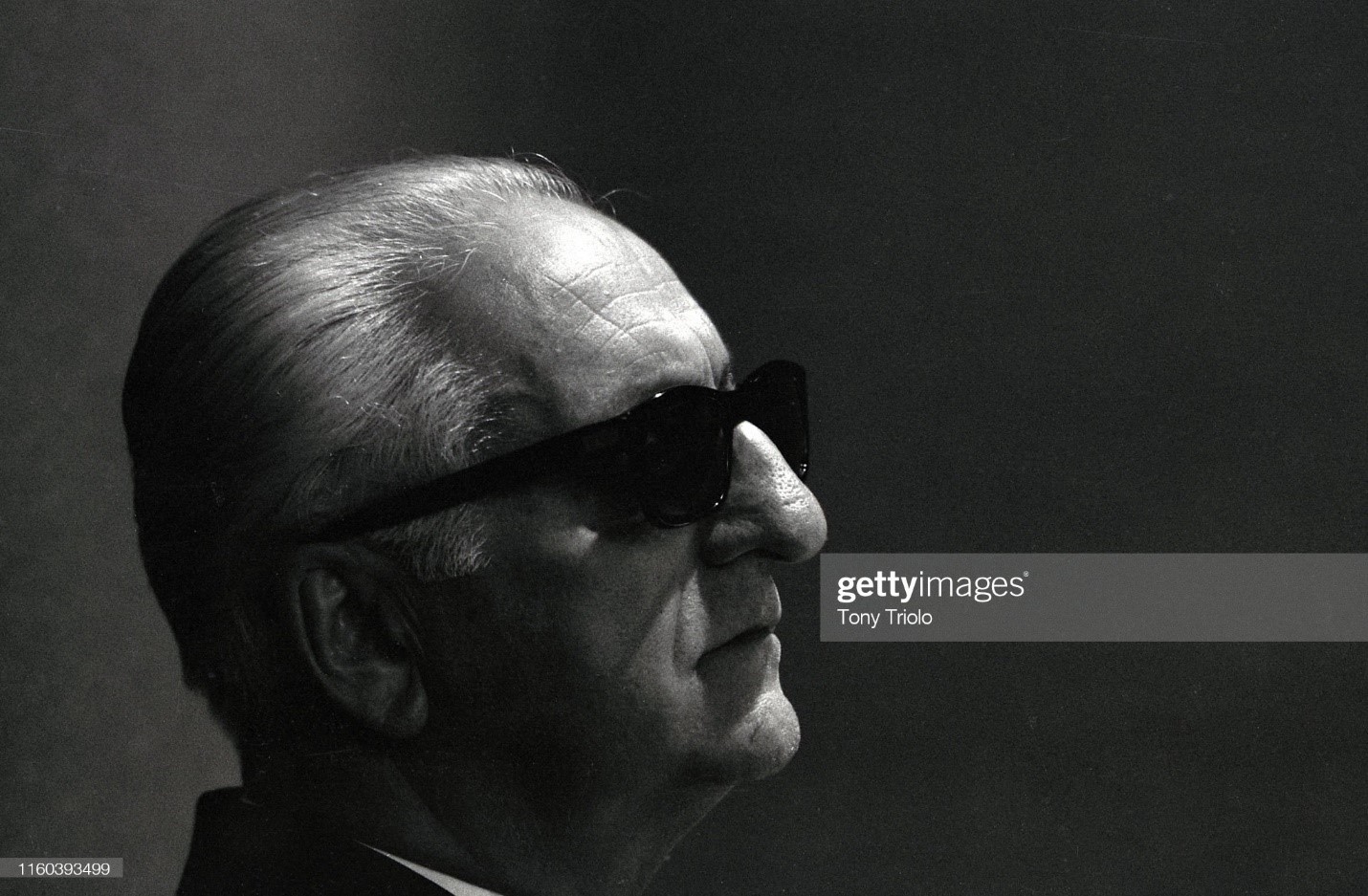
Closeup portrait of Ferrari founder Enzo Ferrari in his factory office. Maranello, Italy 7/20/1964. Photo by Tony Triolo /Sports Illustrated/Getty Images.
The first one was owned by Gianni Agnelli.
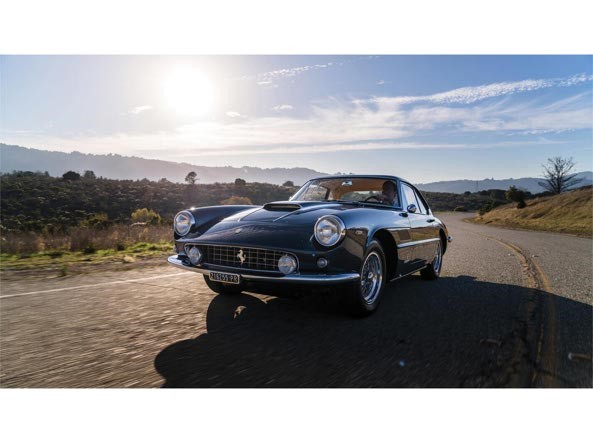
1961, the letter on the change of style
In the letter dated 18 February 1961, Ferrari talks about his look completely revisited by Fiamma.
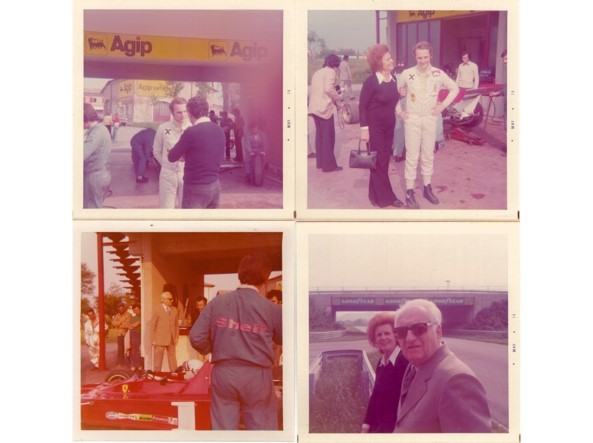
At the auction, in addition to the items from her wardrobe such as Chanel, Ferrè, Armani and Cavalli clothes and accessories, there will also be an insider tip for collectors: a set of suitcases with beauty-cases created by Fiamma Breschi herself in the Ferrari monogram fabric.
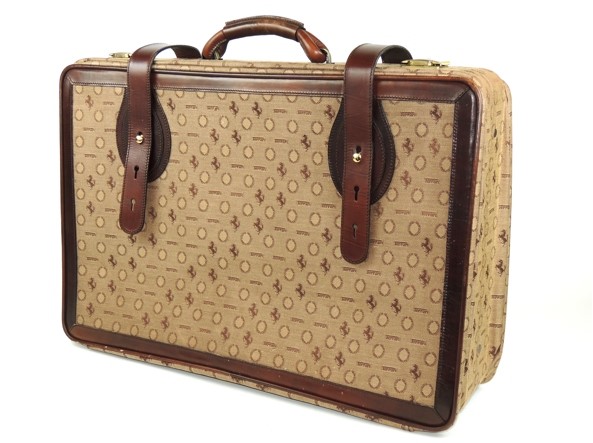
At the auction - in addition to the memories of Maranello, the letters from Luigi Musso, the medals of the dead driver, books, photographs, memories and curiosities - the furnishings of the Florentine house and a selection from her wardrobe will also be auctioned. In all there are over 300 lots that reveal the world of the beautiful lady who was able to steal the heart of Enzo Ferrari.
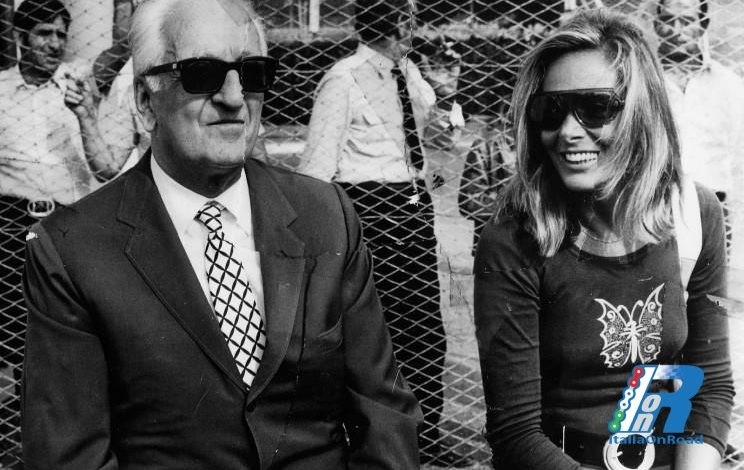
A memory of Fiamma Breschi, for thirty years the shadow of Enzo Ferrari. June 20th, 2017. By Fabio Avossa.
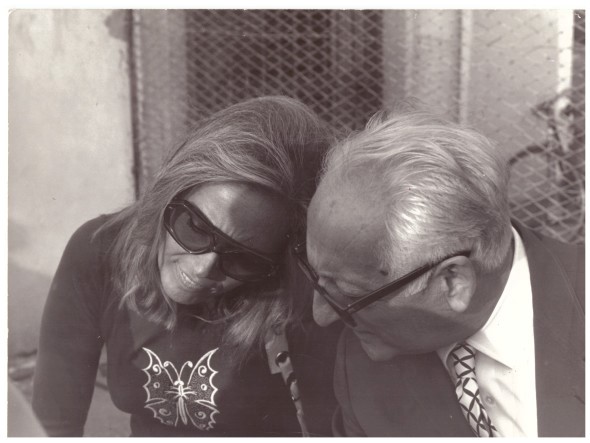
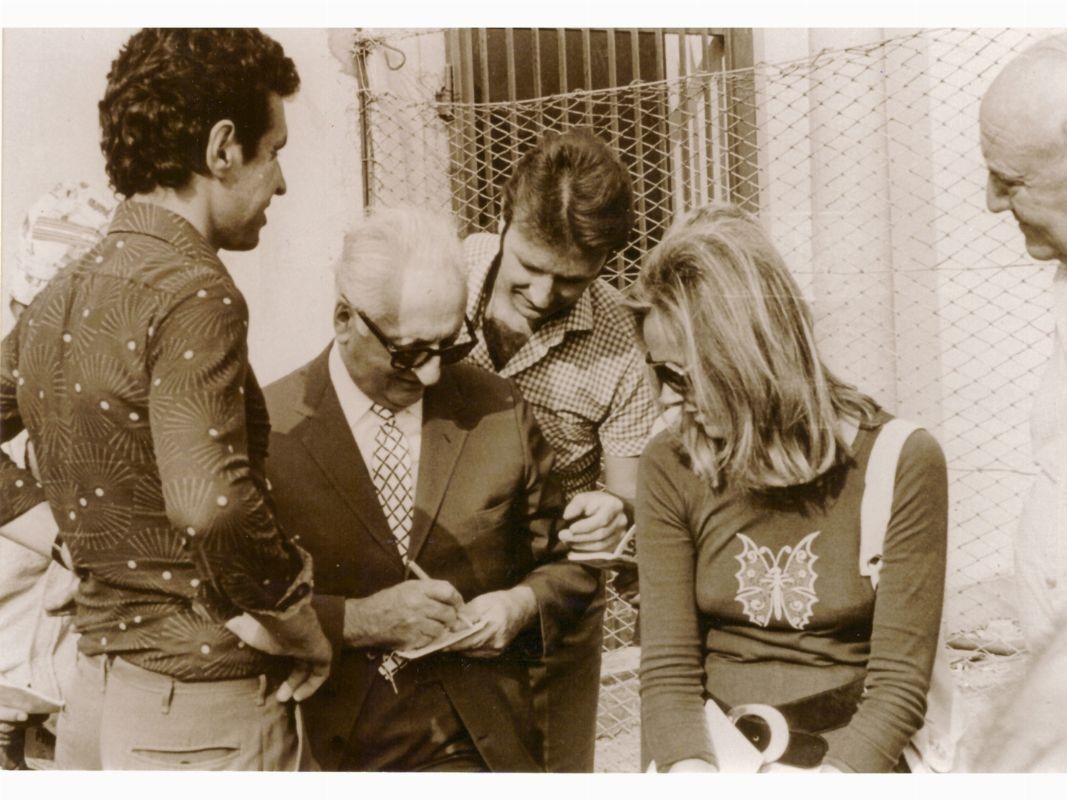
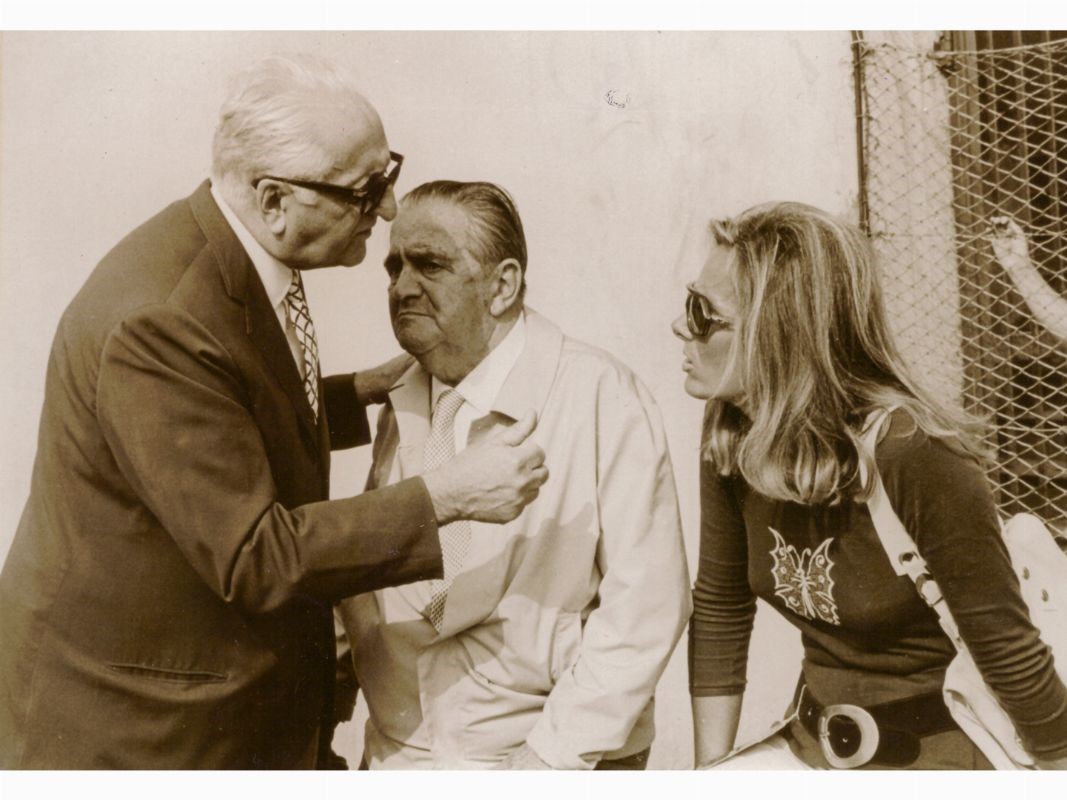
Who was Fiamma Breschi, this little-known character and what function did she have in Ferrari if she had one?
She was a beautiful woman, very private. For a brief period she was a film actress, in 1954 she had starred in the films “In amore si pecca in due” and “Desiderio ‘e sole”.
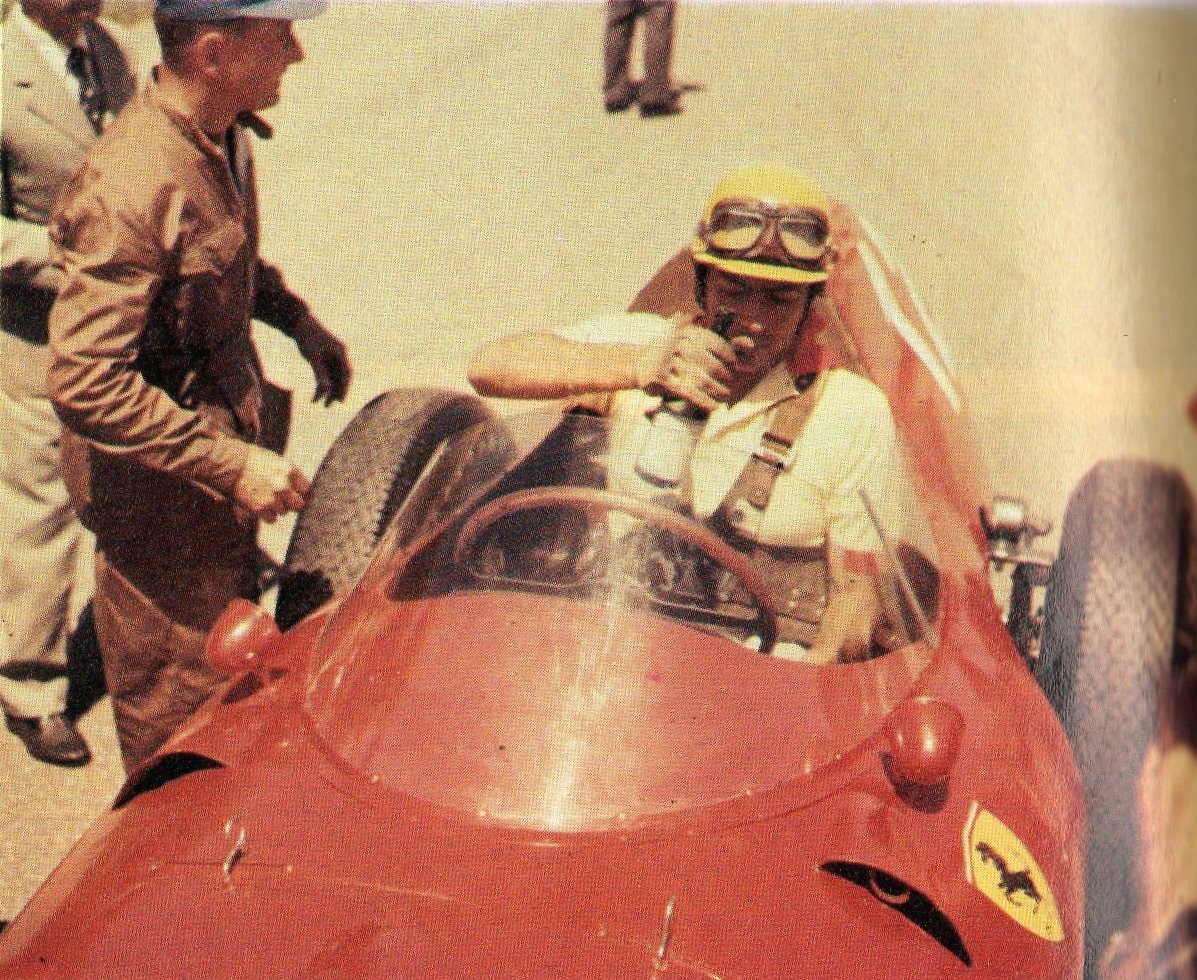
Musso at the 500 Miglia of Monza in 1958 in the Ferrari 412 MI n.12.
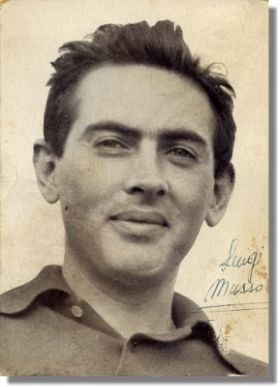
She had met Luigi Musso when she was seventeen and was fascinated by him.
She had always followed the Roman champion around the world on all the circuits where she loved to collect the autographs of her driver friends on her personal leather bag.
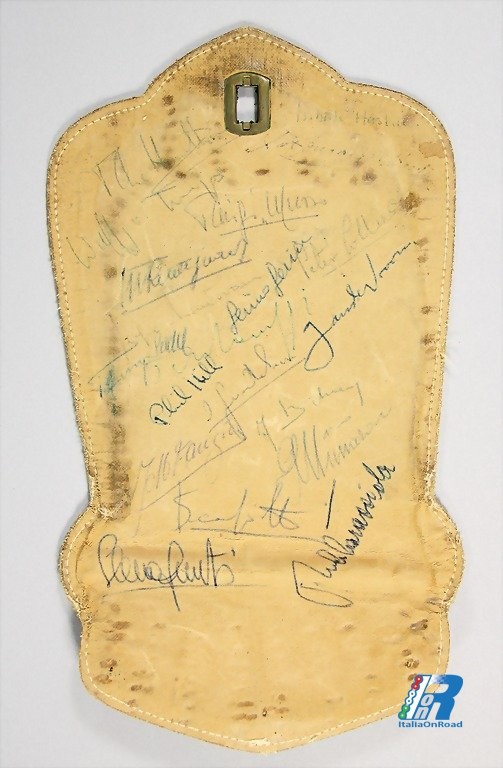
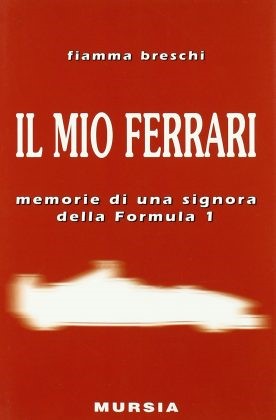
In 1988 she wrote a memoir, "My Ferrari".
On November 20, 2015 she left in Florence with the discretion that has distinguished her throughout her life.
Videos
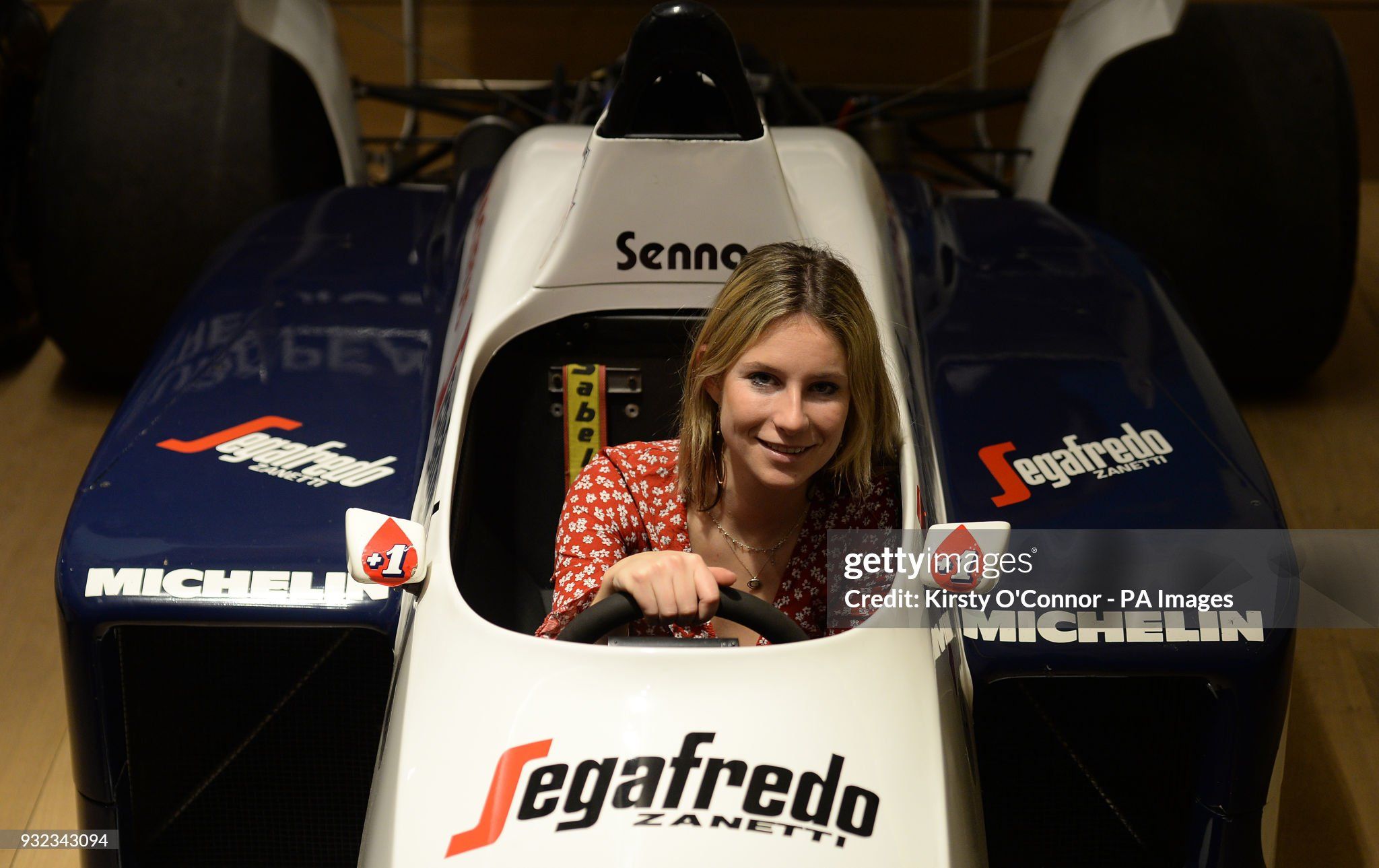

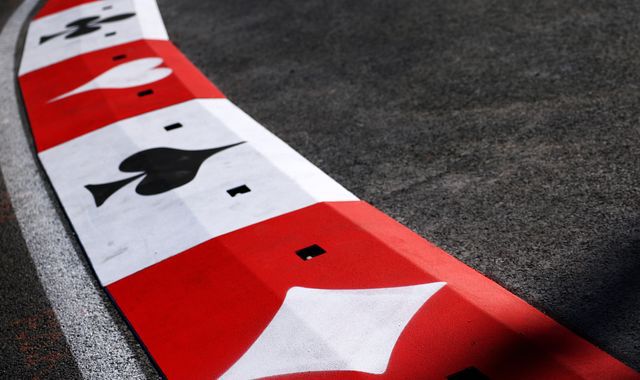
Comments
Authorize to comment